Use these 41 tasks to improve your site’s rankings and boost organic traffic.
For best results, create a free Semrush account (no credit card required) and follow the steps in this guide.
How to Use This SEO Checklist
We’ve divided these SEO best practices into five sections:
-
Basic SEO Practices Checklist
-
Keyword Research Checklist
-
Technical SEO Checklist
-
Content & On-Page SEO Checklist
-
Link Building & Off-Page SEO Checklist
Address all five sections for a holistic SEO strategy. If you have limited time or resources, focus on the most relevant tasks. Return to this guide whenever you’re ready to move on.
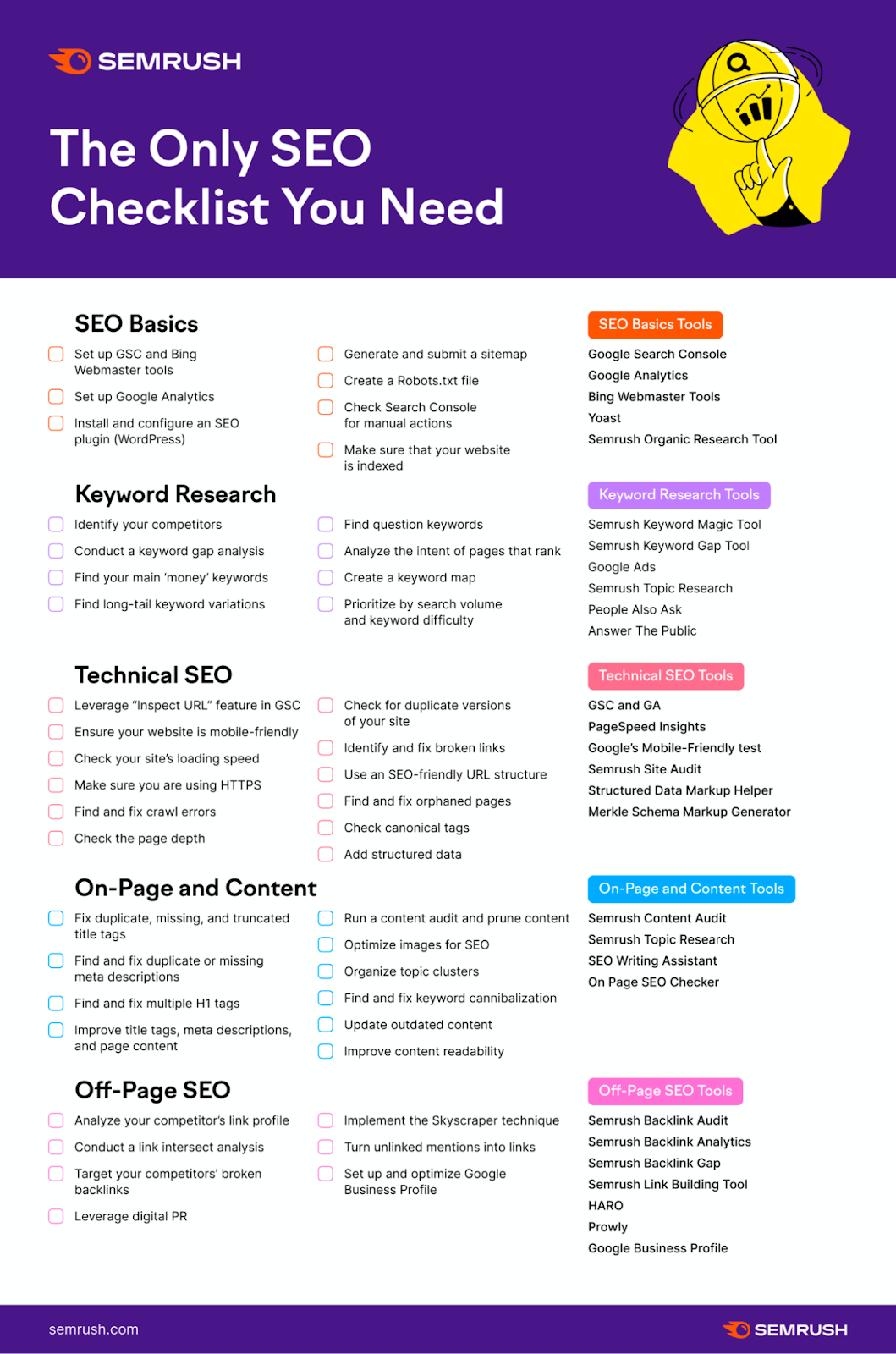
Download a copy of the checklist here.
Basic SEO Practices Checklist
These first steps create a foundation for your SEO. Skipping them can make it harder to rank.
1. Set Up Google Search Console and Bing Webmaster Tools
Set up Google Search Console (GSC) or Bing Webmaster Tools to monitor your SEO performance and submit your pages to search engines.
These tools allow you to:
-
Monitor your SEO performance
-
Submit sitemaps and URLs
-
Identify crawl errors

They’re both free tools that help you monitor, maintain, and troubleshoot your site’s performance in Google or Bing search results.
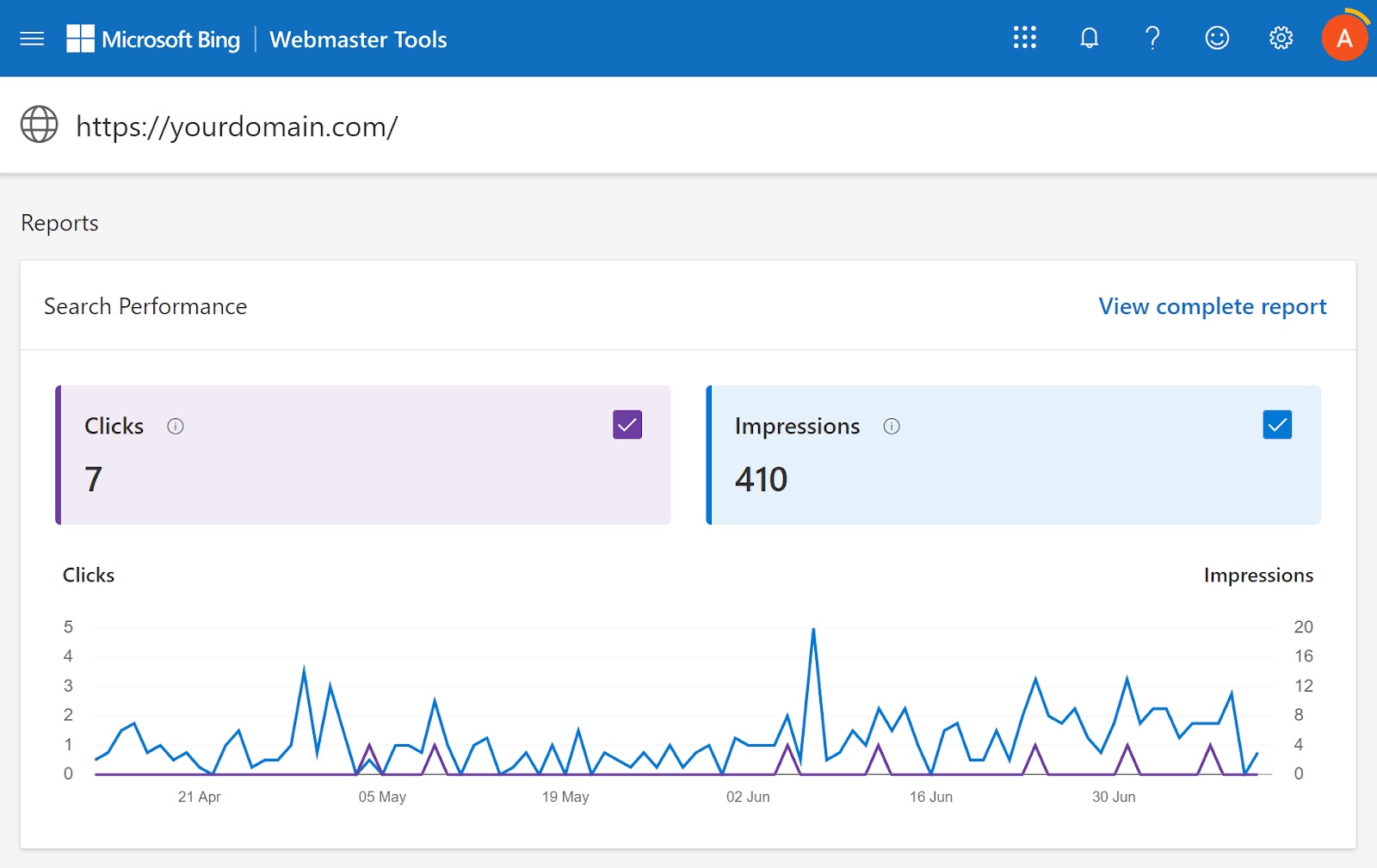
2. Set Up Google Analytics
Set up a free Google Analytics 4 (GA4) account to track site traffic and user behavior. With GA4, you can see:
-
Which pages bring the most traffic
-
Traffic sources (sites and search engines)
-
Bounce rates and page views
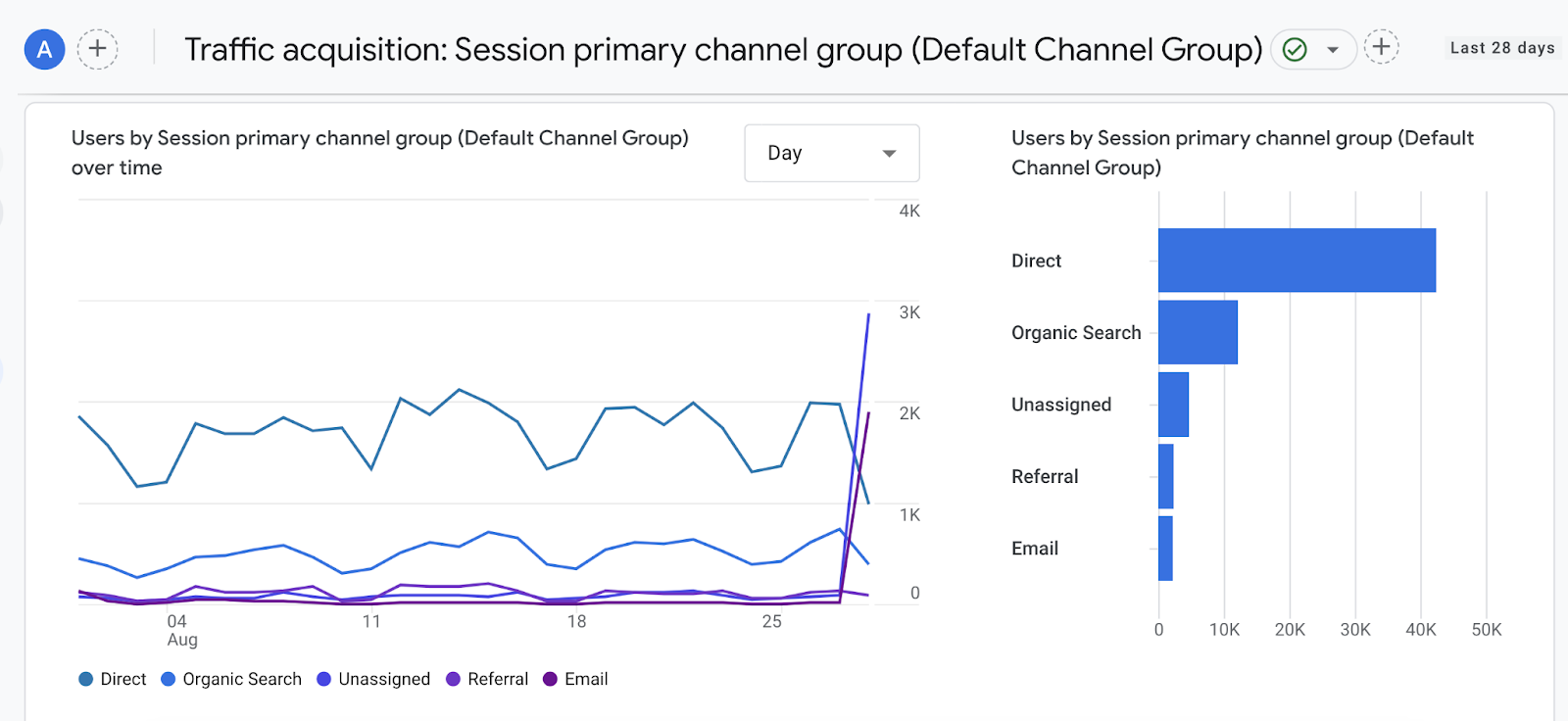
3. Install and Configure an SEO Plugin (for WordPress Sites)
A WordPress SEO plugin can help you:
- Generate sitemaps automatically
- Edit robots.txt files
- Manage on-page optimization
Here are some popular SEO plugins, along with their key features:
| SEO Plugin | Key Features |
| Yoast SEO | Content analysis: Offers real-time suggestions to improve readability and search performance XML sitemaps: Automatically generates XML sitemaps to help search engines index your site On-page optimization: Allows you to easily edit things like title tags and meta descriptions for all site pages Related keyphrases: Integrates with Semrush to find additional keywords you can optimize a page for |
| Rank Math | GSC module: Showcases key information like search performance, sitemap status, and any indexing errors Schema markup: Offers advanced schema markup options to help your content stand out in search results Redirect manager: Manages 301 redirects and monitors 404 errors Keyword optimization: Lets you optimize each page for multiple focus keywords |
| SEO Writing Assistant | Real-time content analysis: Recommends real-time improvements to boost your performance Tone of voice: Analyzes your content to ensure it matches your brand voice Originality check: Checks your content for potential plagiarism Readability score: Assesses your readability and suggests improvements to your content clarity |
4. Create and Submit an XML Sitemap
Create and submit an XML sitemap to help search engines understand your site’s structure and index your pages. If you use WordPress, a sitemap is created automatically. Otherwise, create one with a sitemap generator tool.
Next steps:
-
Submit your sitemap to Google Search Console and Bing Webmaster Tools
-
Add your sitemap URL to your robots.txt file
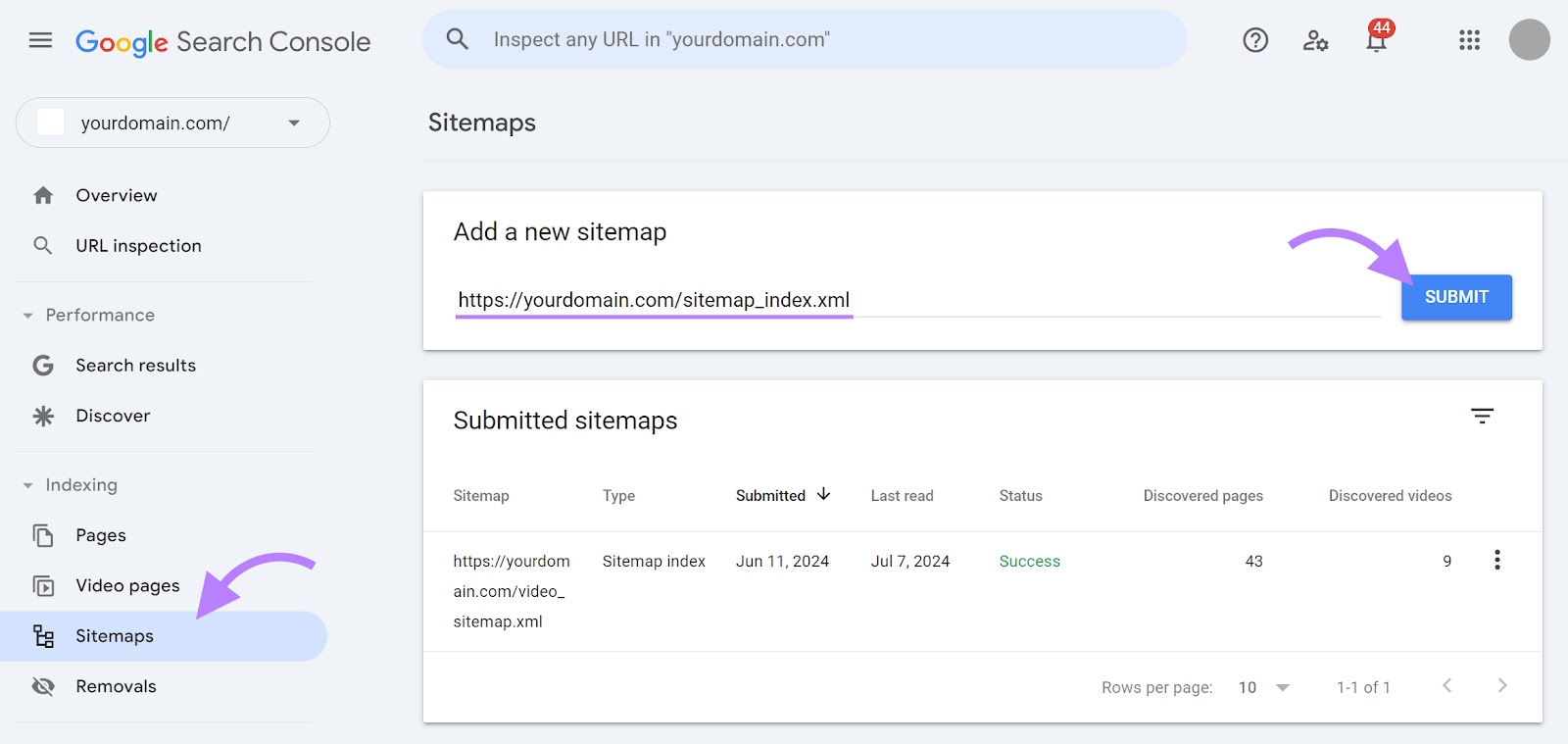
Here’s what our blog’s sitemap looks like:
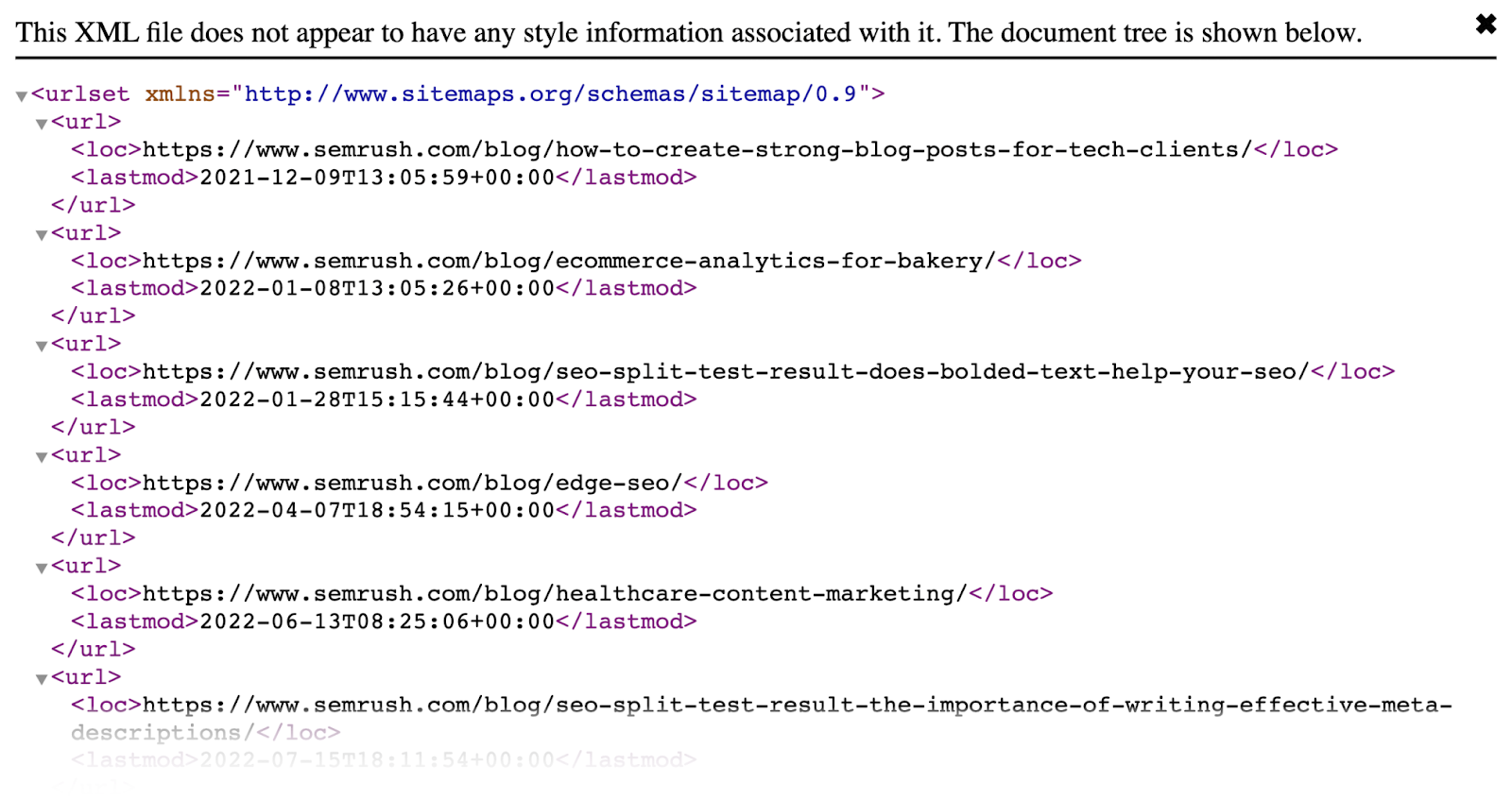
Use Semrush’s Site Audit to find and fix sitemap issues.
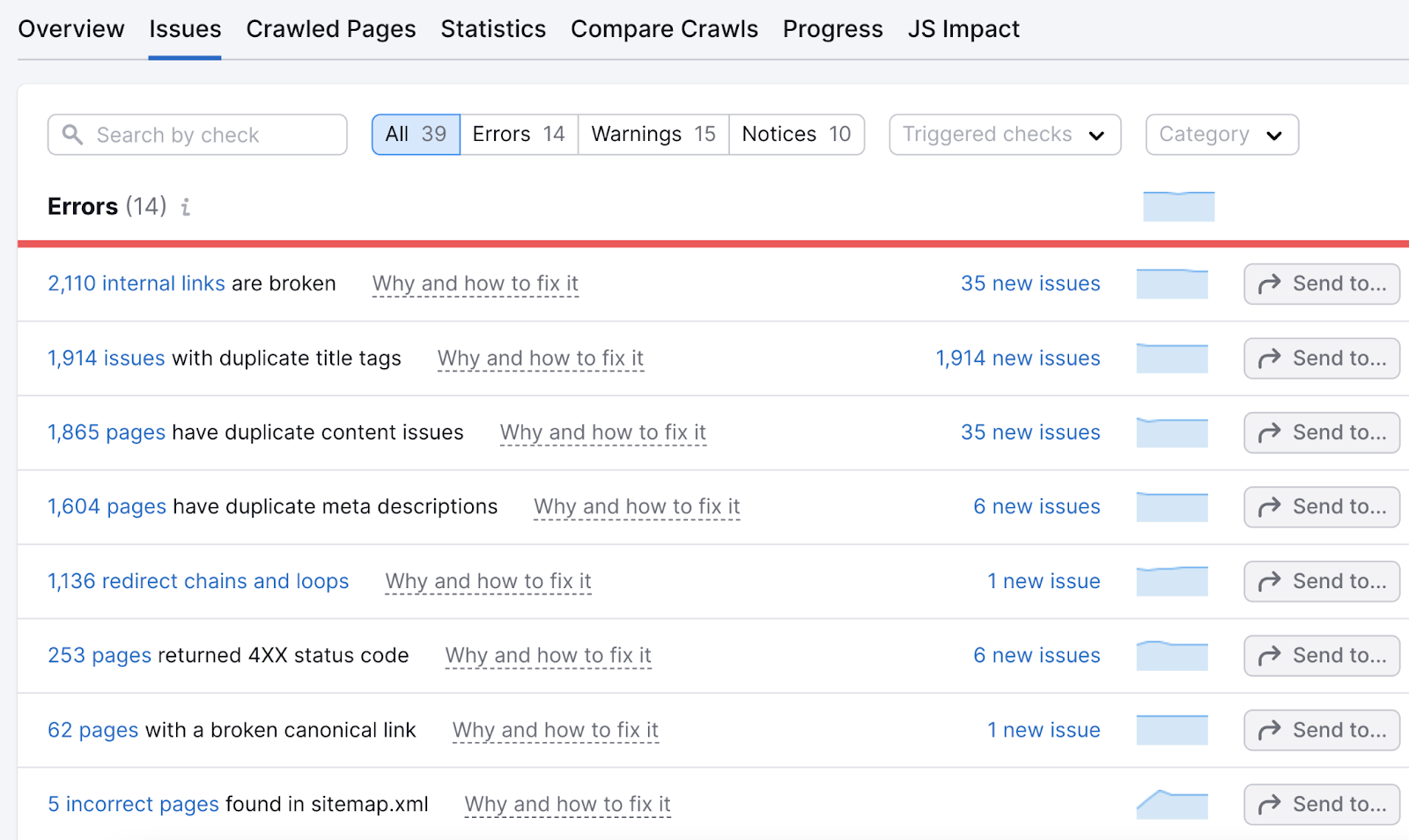
5. Create a Robots.txt File
A robots.txt file tells search engines which pages they can or can't crawl. This is what it can look like:

To see your current file, add “/robots.txt” to your homepage URL. For example:
https://semrush.com/robots.txt
Check your robots.txt file for errors using Semrush’s Site Audit tool.

6. Check Search Console for Manual Actions
Manual actions (penalties) can occur if Google detects spam, hidden text, thin content, or unnatural links.
Make sure to regularly check for any manual actions against your site in Google Search Console.
Scroll down the tool’s sidebar navigation and select “Security & Manual Actions” > “Manual actions.”
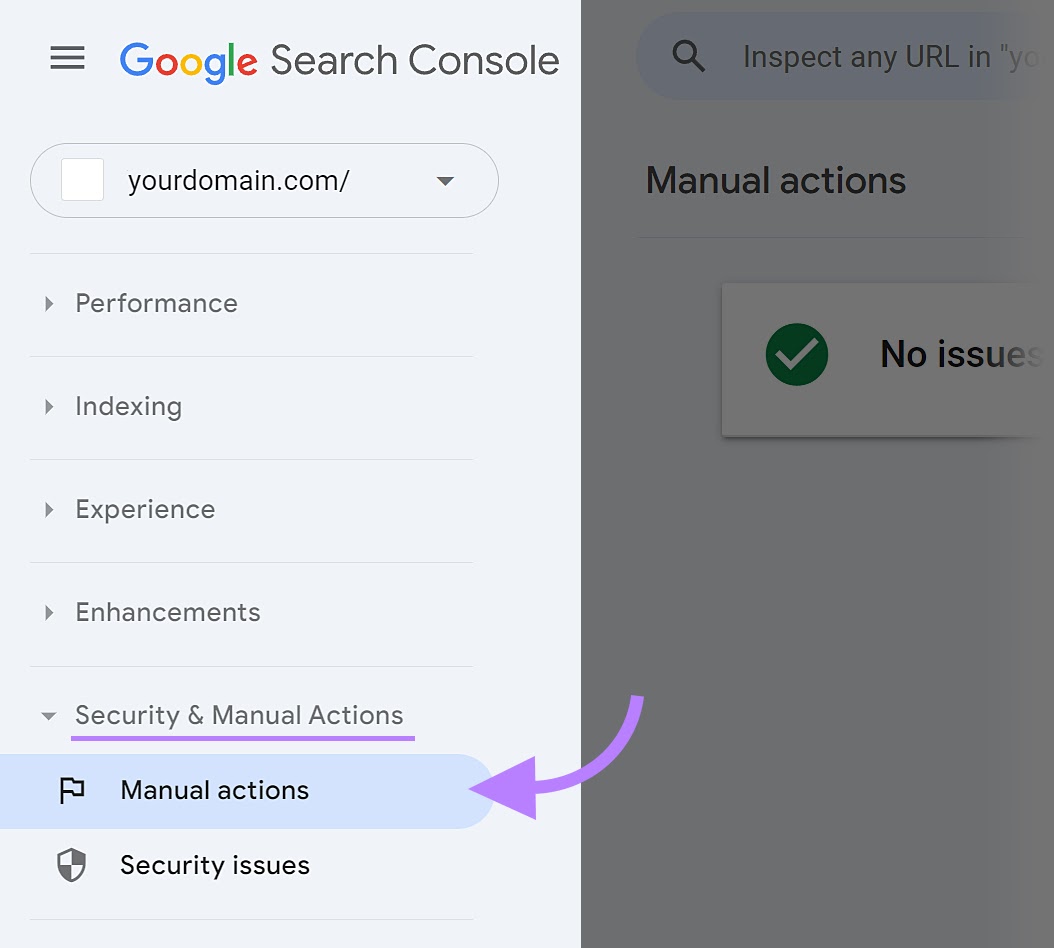
The “Manual actions” tab should pull up a report with detected issues—if there are any.
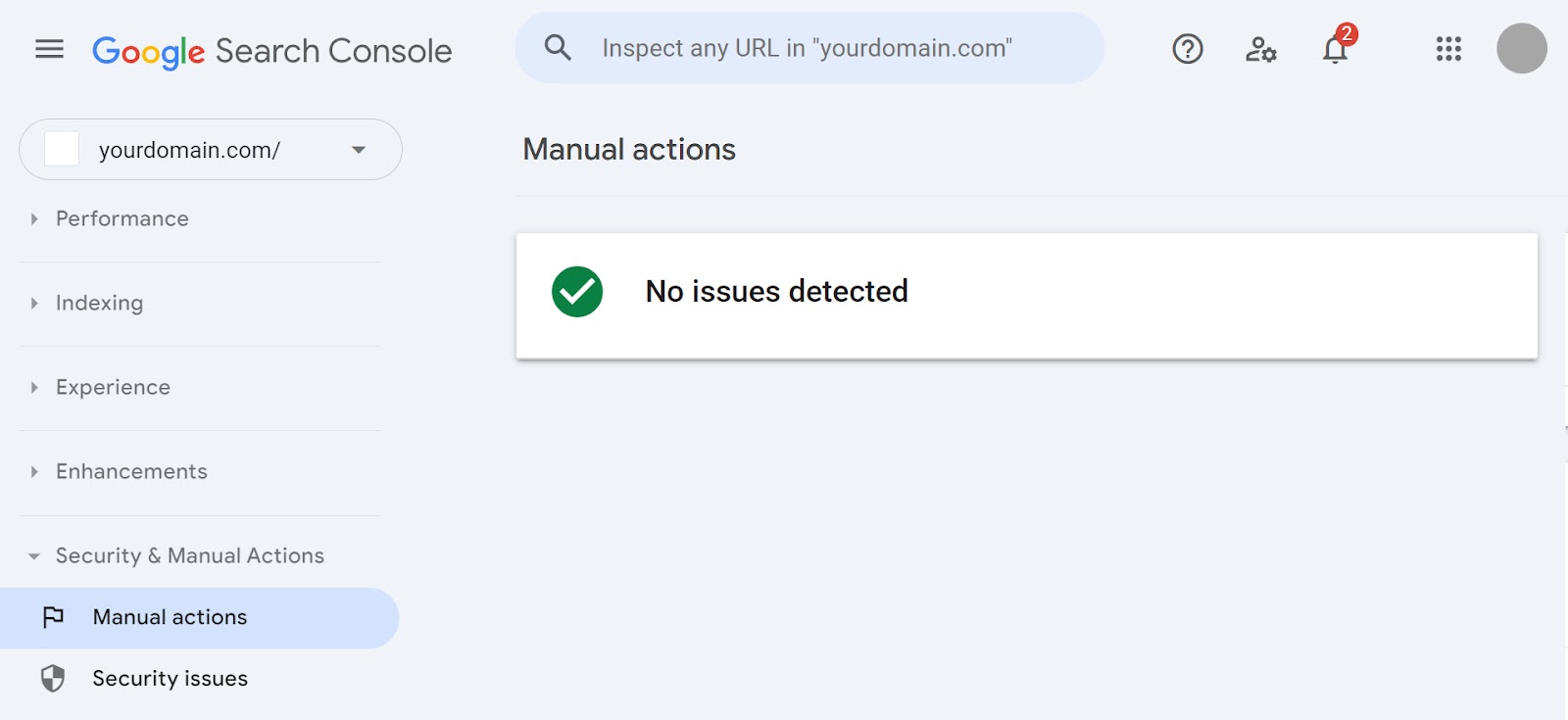
Google will notify you in a GSC report if your site receives a manual action.
7. Make Sure Google Can Index Your Website
Indexability is the ability for search engines to discover and include your pages in search results. If your pages have “noindex” tags or other problems, they won’t appear in Google results.
To make sure search engines can index your site, use our Site Audit tool.
Start by entering your domain and creating a new project.

Select how many pages you want per SEO audit and “Website” as the crawl source.
Click “Start Site Audit.”
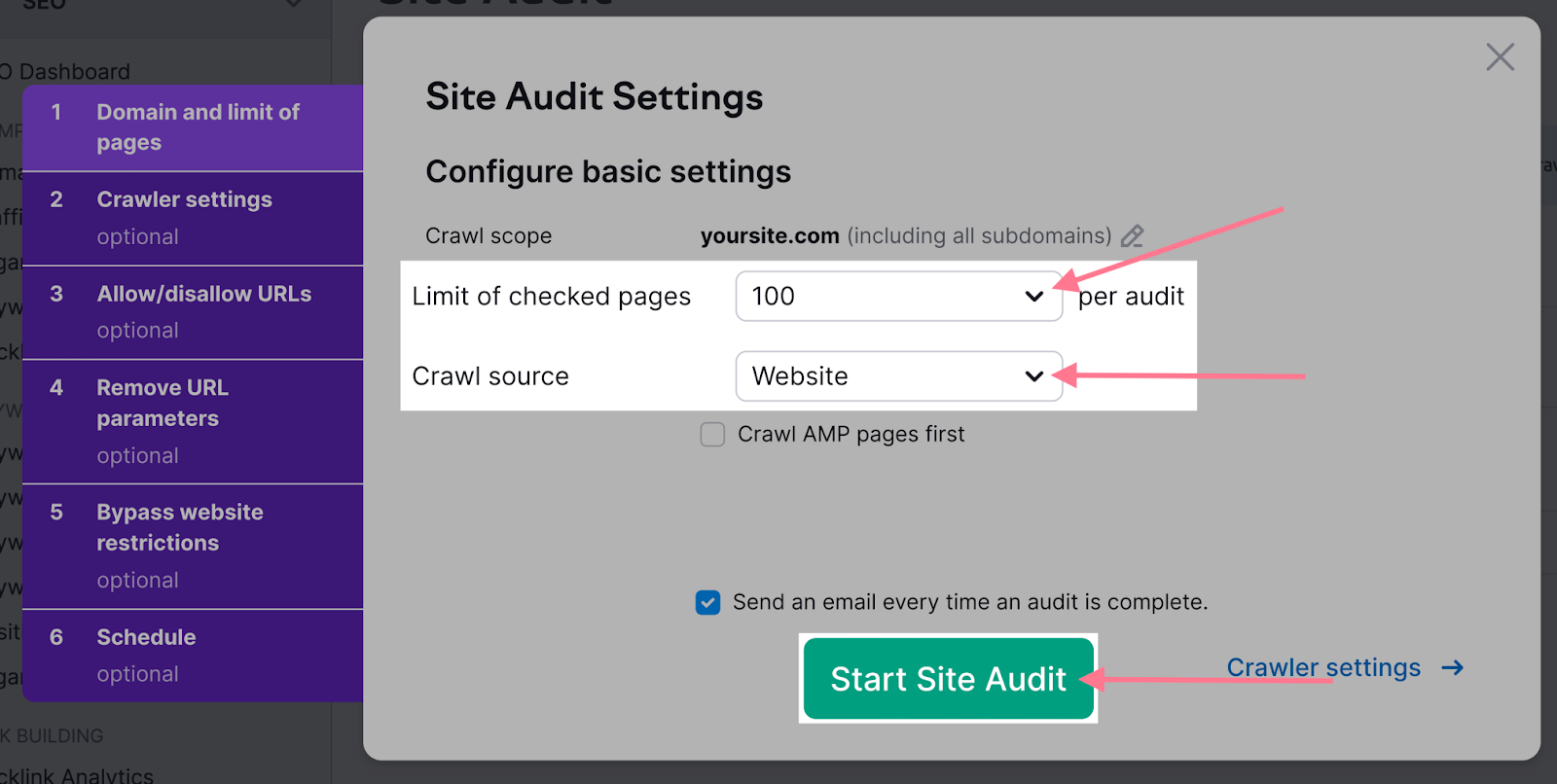
Click “View details” under “Crawlability.”
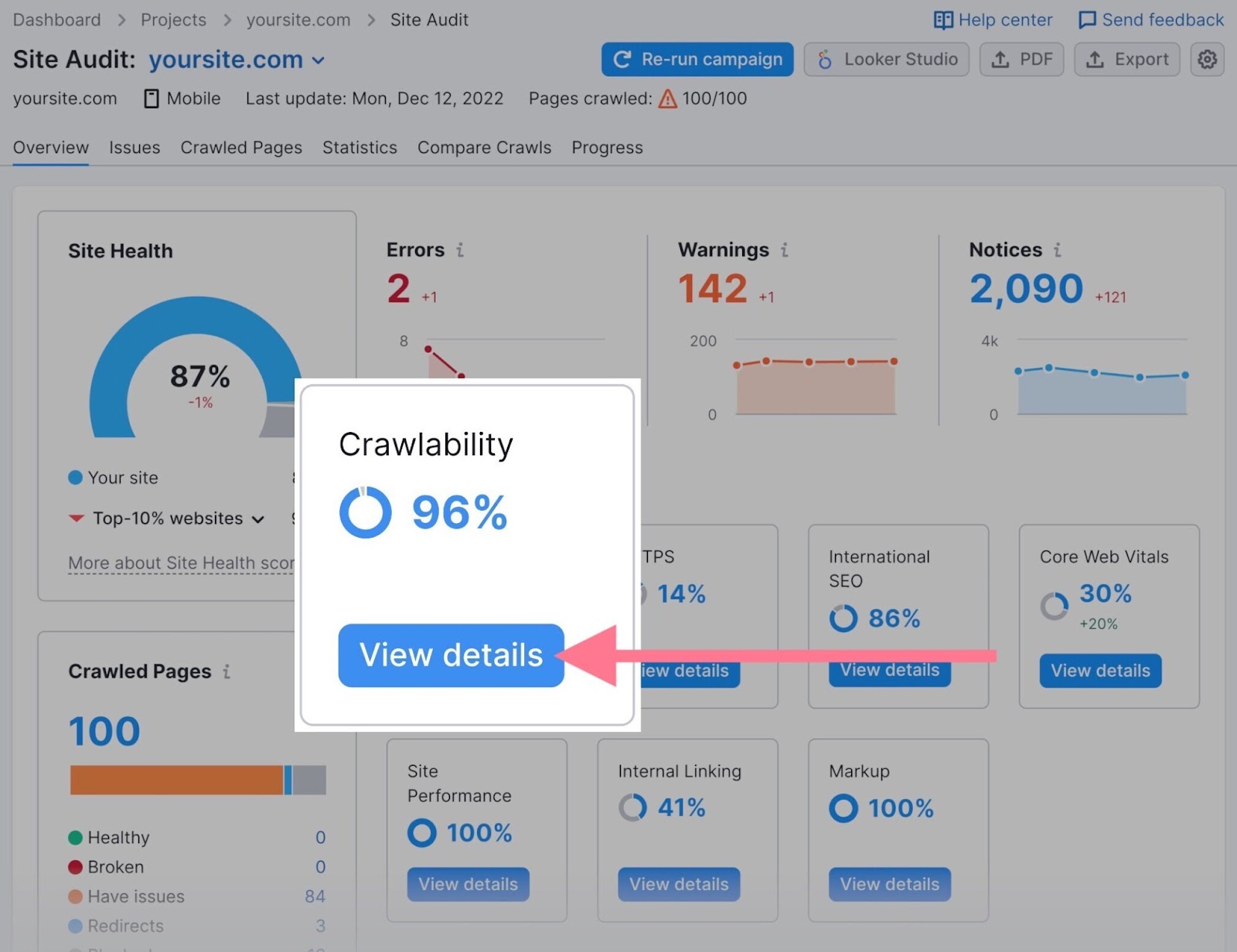
Double-check that your site’s main pages are indexed to save a lot of troubleshooting later.
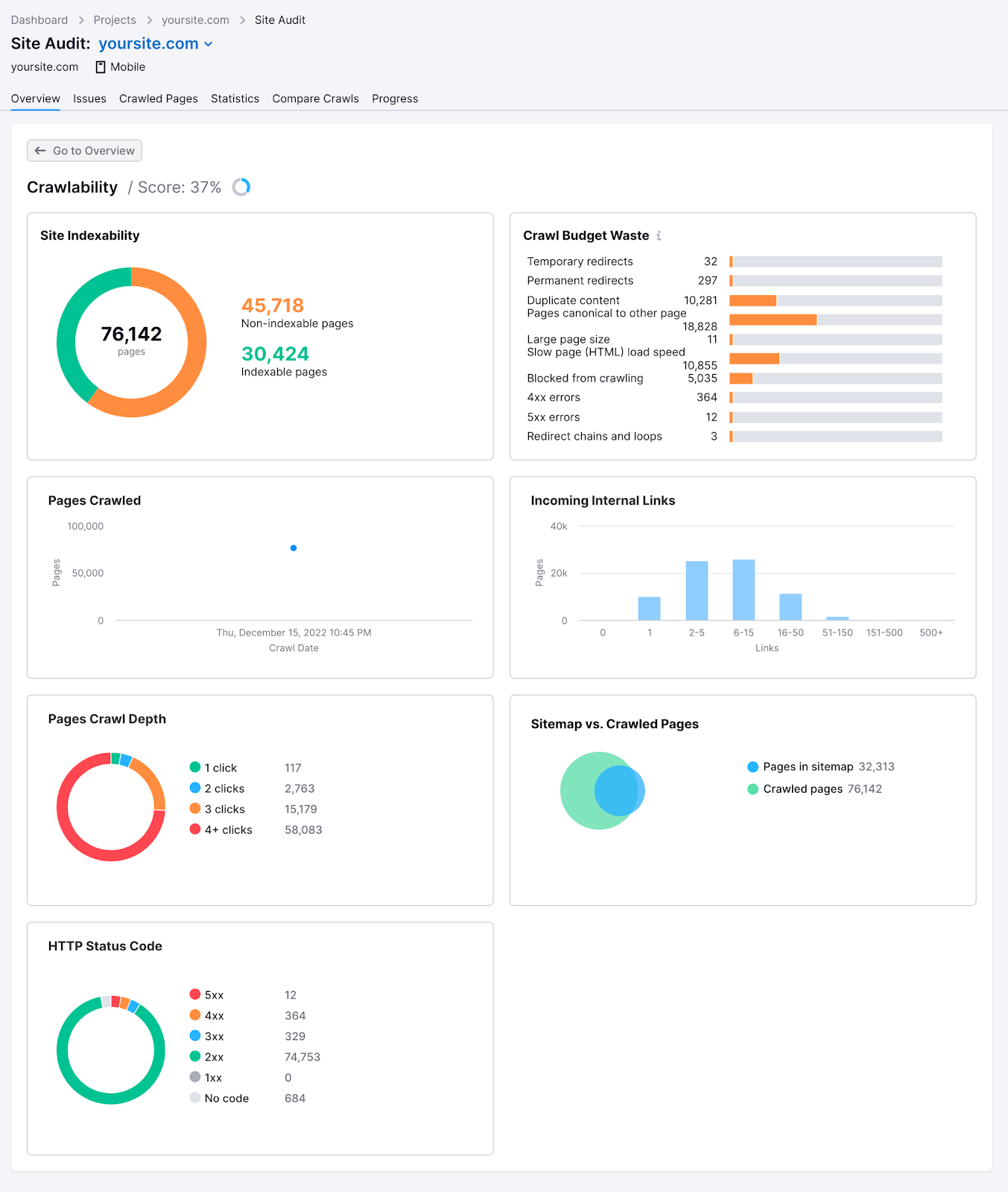
Keyword Research Checklist
Keyword research finds search queries that align with your products or services. Use these steps to prioritize keywords and shape your keyword strategy.
8. Identify Competitor Keywords
Competitor keywords are search queries your competitors are already targeting to improve their rankings and drive traffic.
Use Semrush’s Keyword Gap tool to identify search queries your competitors target.
Enter your domain and up to four of your competitors’ domains.
Then, click “Compare.”
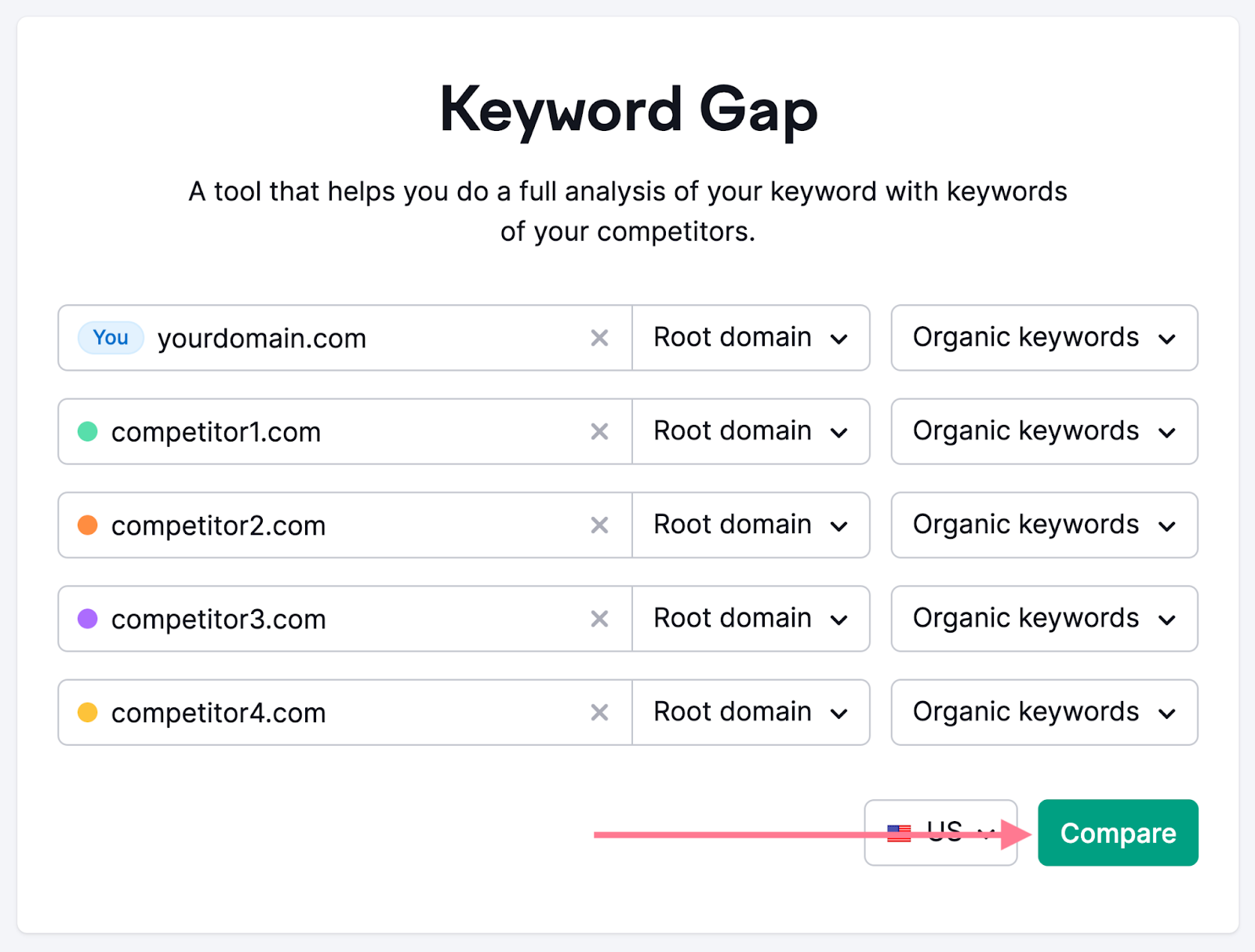
Scroll down to the “Top Opportunities” table and focus on two labels, “Missing” and “Weak.”

Look for keywords labeled “Missing” (competitors rank, you don’t) and “Weak” (competitors rank higher than you). Focus on these gaps.
Further reading: How to Do an SEO Competitor Analysis in 2024 (Free Template)
9. Find Your Main ‘Money’ Keywords
Main “money” keywords have high potential to drive traffic or revenue. They’re usually high-volume, high-competition terms related to your core offerings.
Use Domain Overview to see which keywords drive the most organic traffic for a specific domain. Enter the domain you want to analyze.

Scroll down to see the “Top Organic Keywords” and click on “View details.”
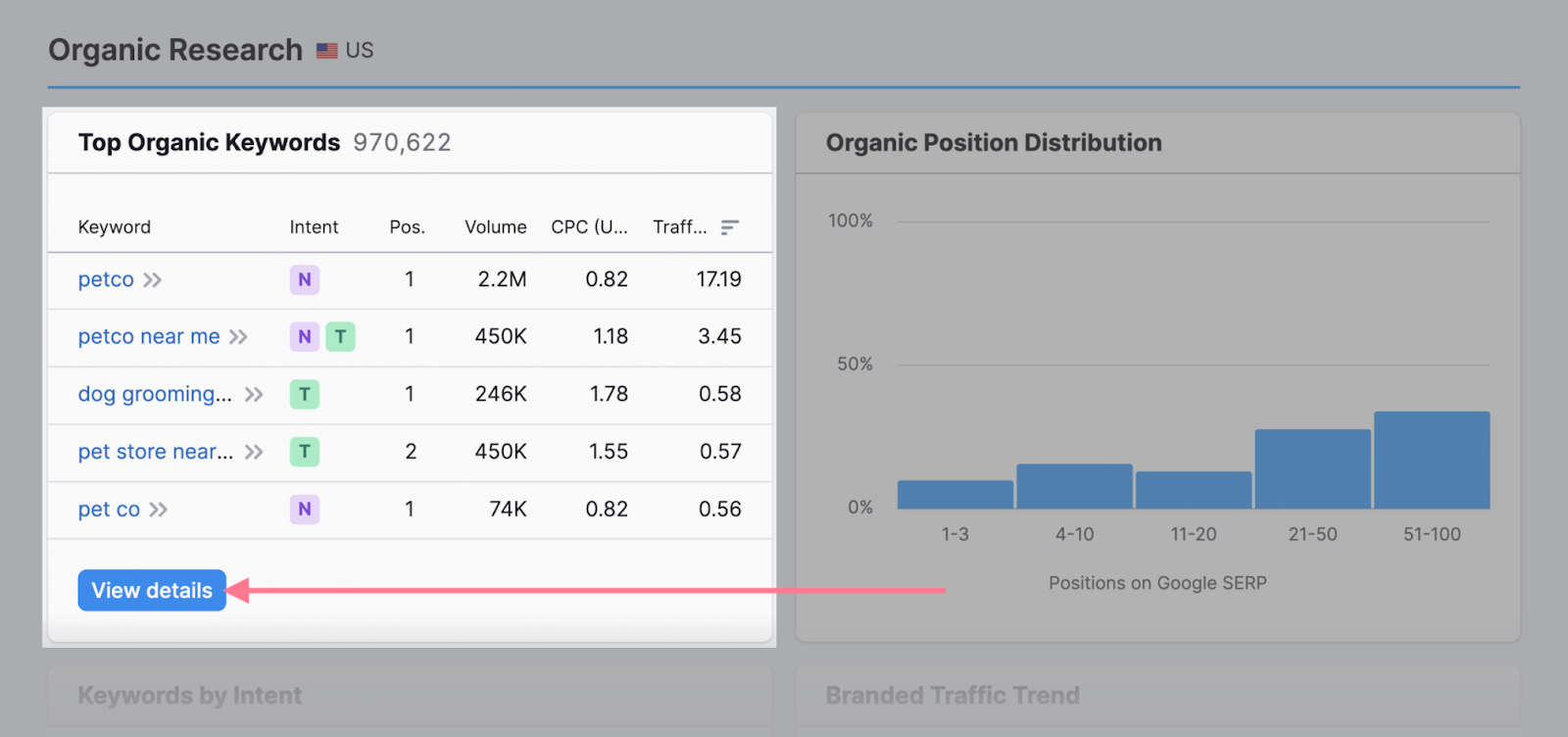
These are the keywords that drive the most organic traffic to the analyzed site.
Pay attention to keywords with commercial and transactional search intent. These tend to lead to more leads and conversions.
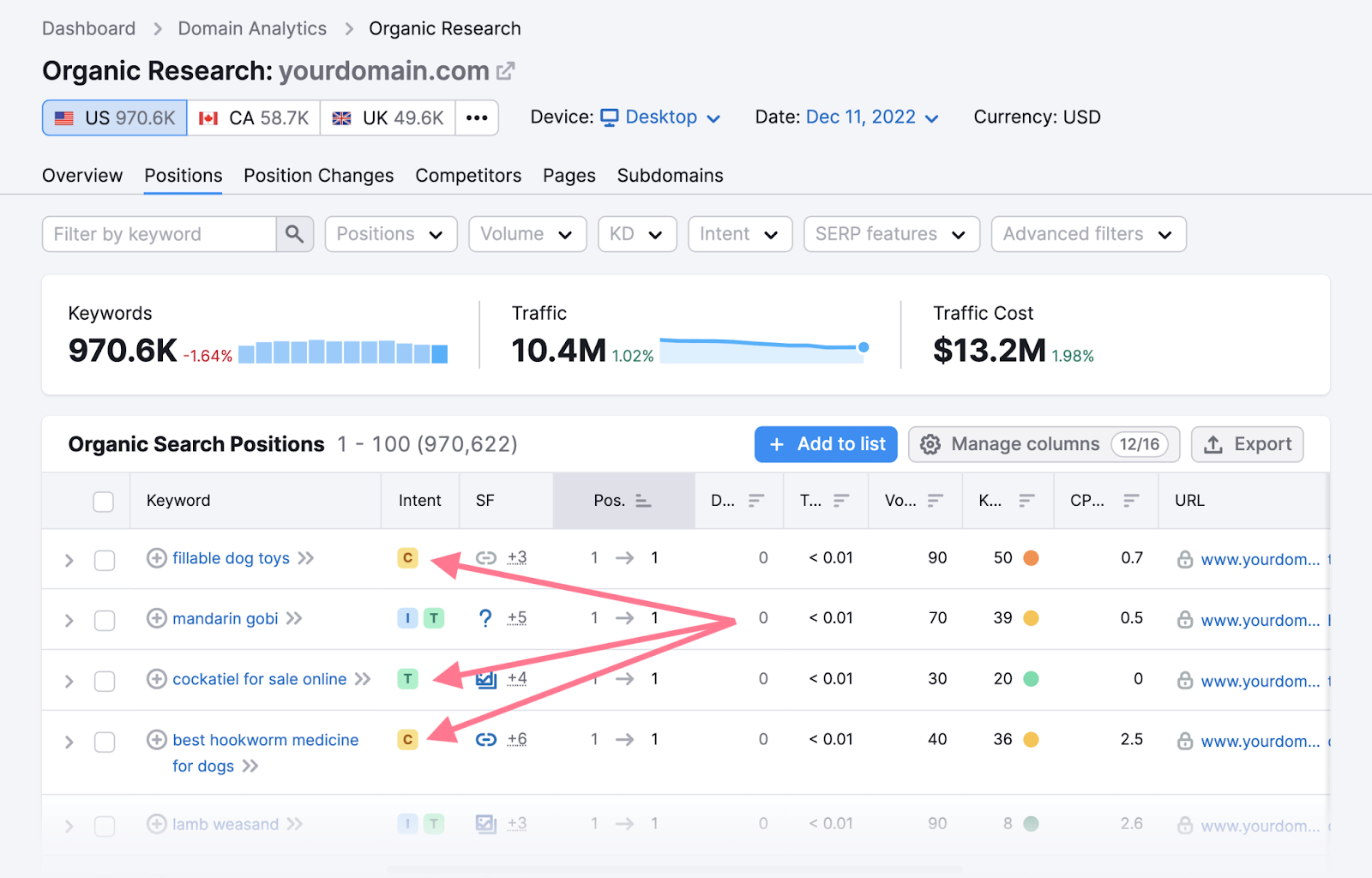
If you’re ranking high, that’s great news. If you aren’t, optimize and improve the content on these pages.
10. Find Long-Tail Keyword Variations
Long-tail keywords have lower search volumes but tend to be more specific and easier to rank for. They also convert better.
Go to Semrush’s Keyword Magic Tool and enter your keyword.
Make sure “Broad Match” is selected. Use the search volume and keyword difficulty filters.
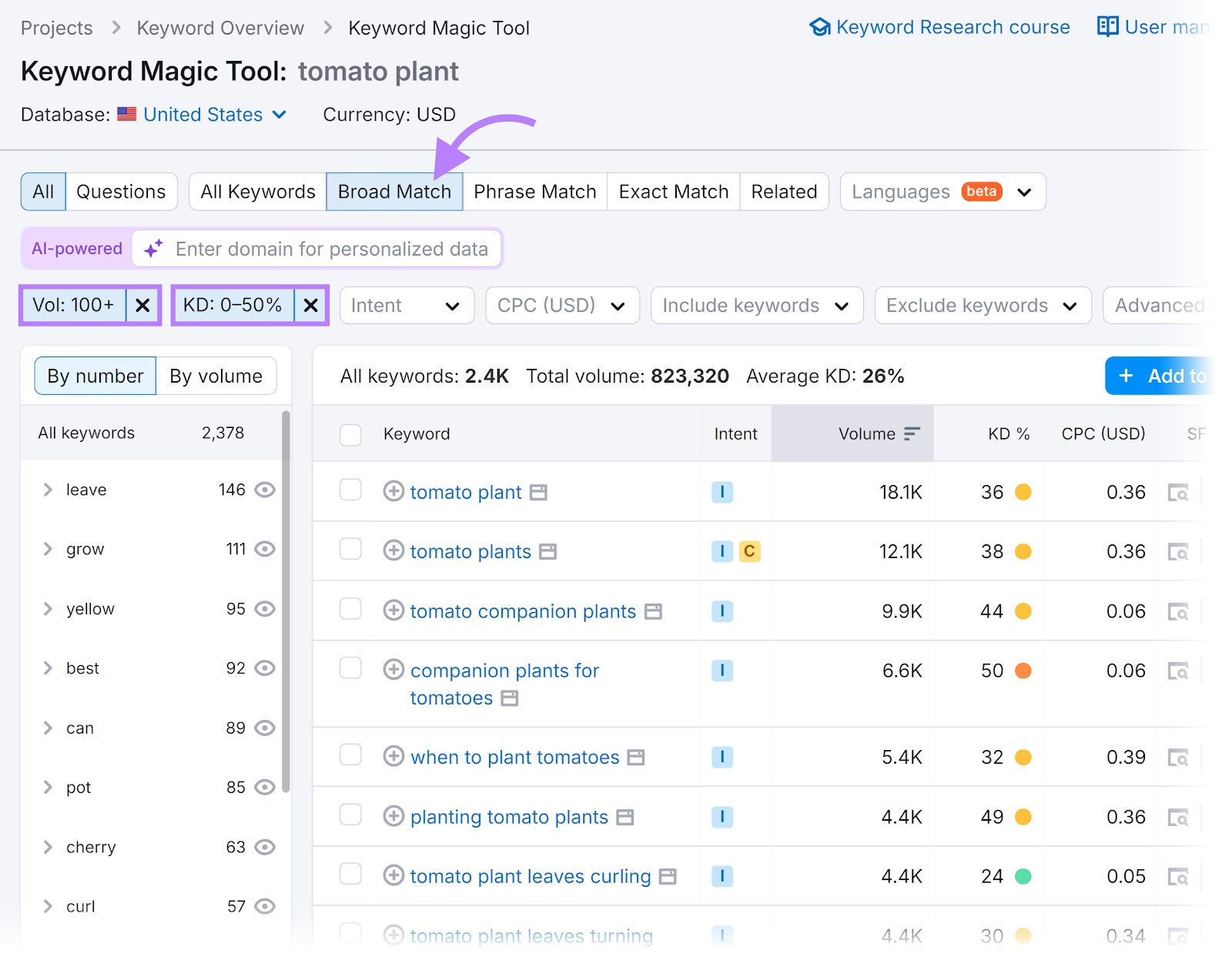
Also, check the “Questions” filter. This filter often returns interesting long-tail keywords phrased as questions.
Like so:
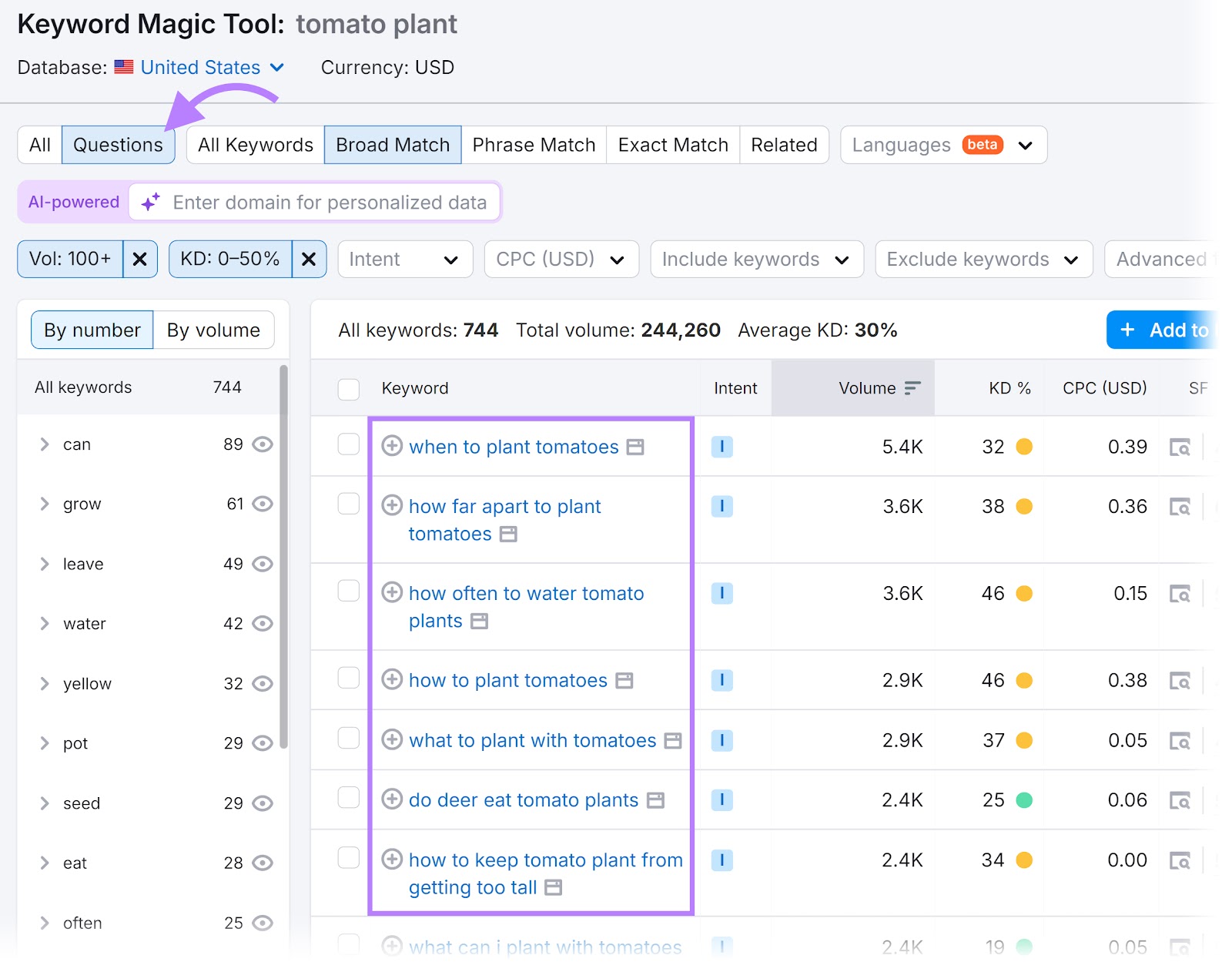
Use these long-tail keywords to create new informational content or incorporate them into existing pages when relevant.
11. Create a Keyword Map
You need to map your target keywords to pages on your site. First, group keywords into distinct clusters. Use one keyword to identify a larger set.
Enter your chosen keyword in the Keyword Magic Tool and go to the “Related” tab.
View the results here and check the boxes next to all the terms that seem relevant.
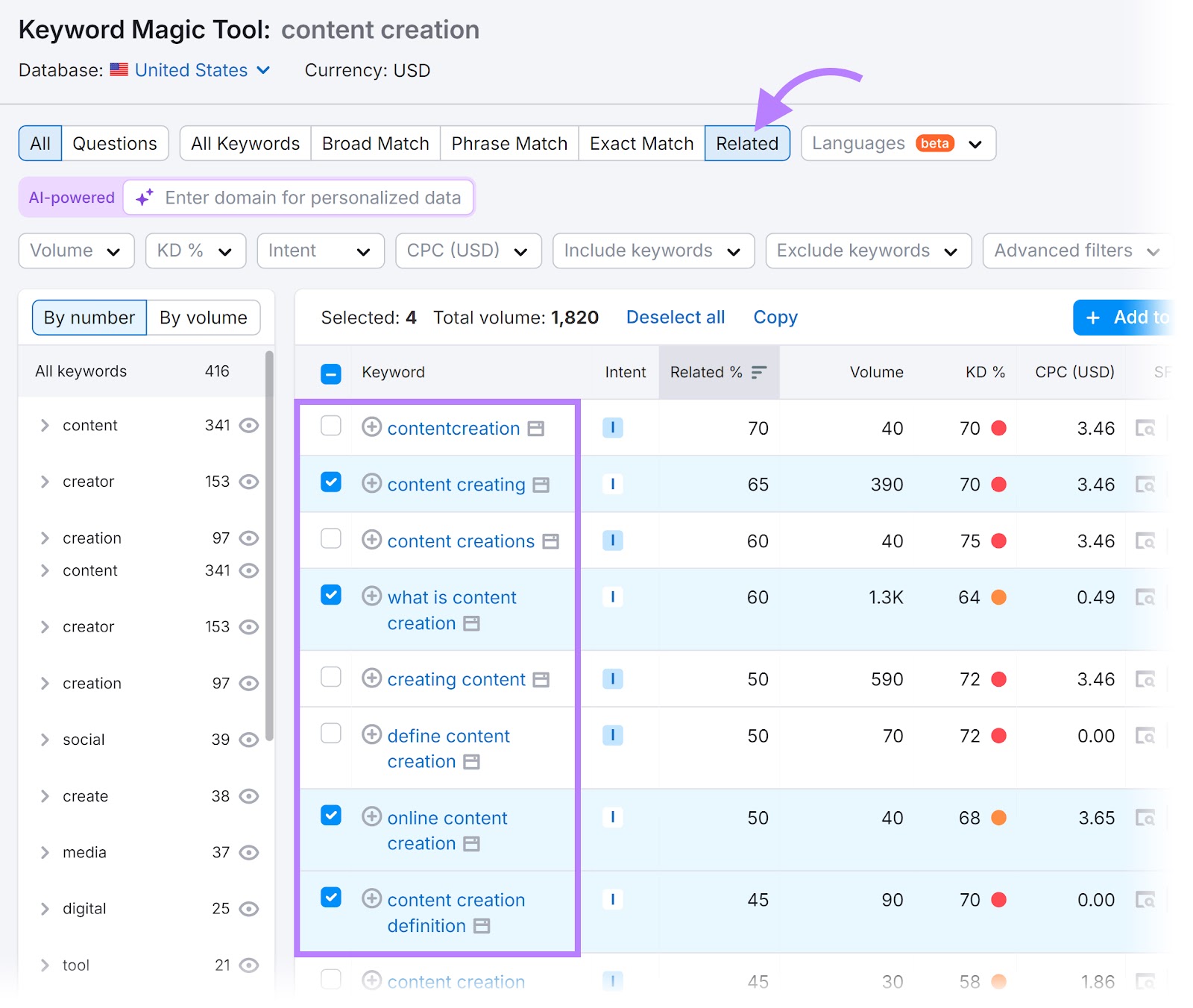
Export those selected keywords onto a spreadsheet and group keywords by intent—grouping keywords that answer the same general question.
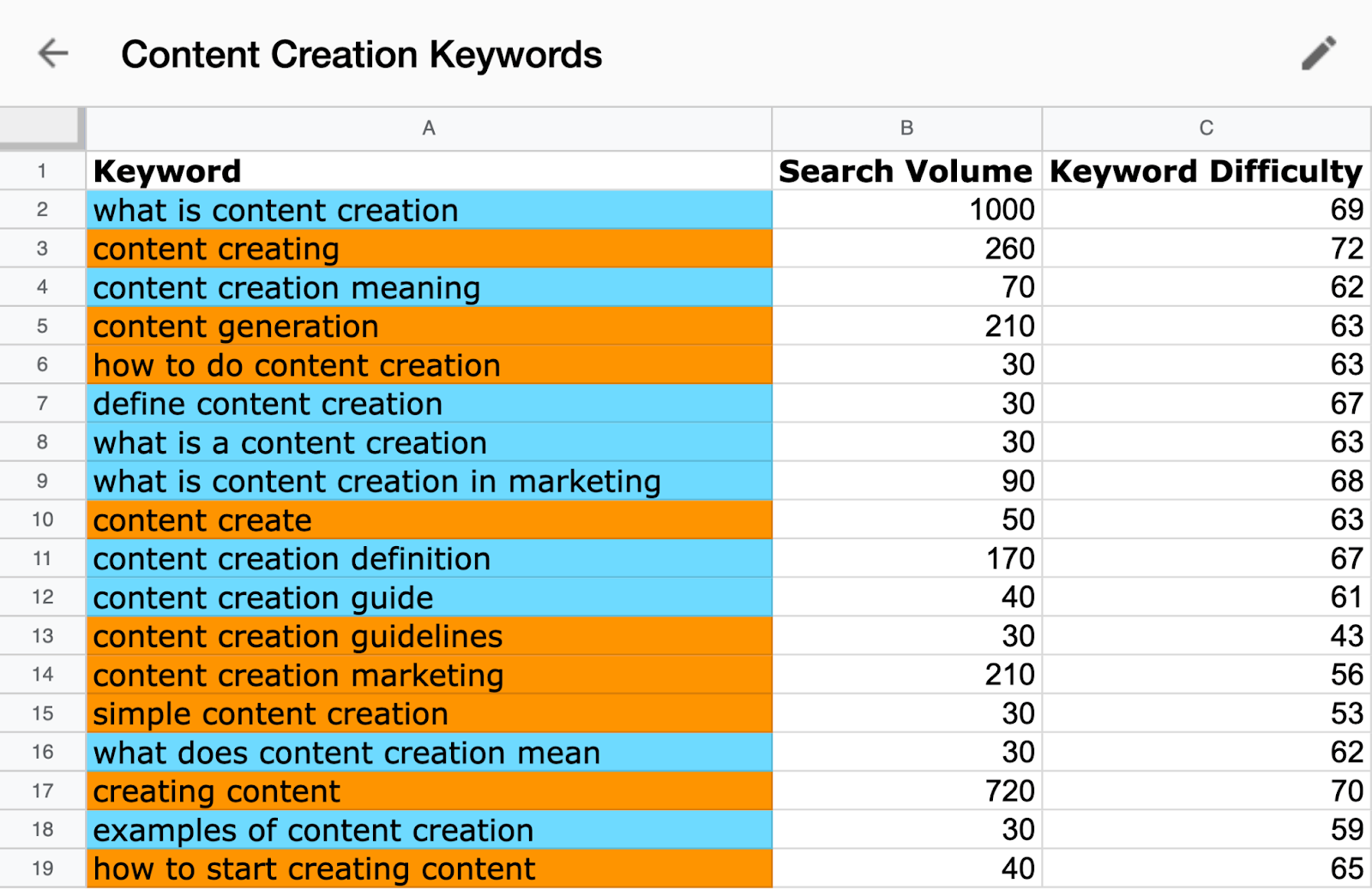
Then, you want to analyze each set to visualize your site’s potential structure and individual pages.
Your last step is to categorize keywords based on the grouping you’ve defined.
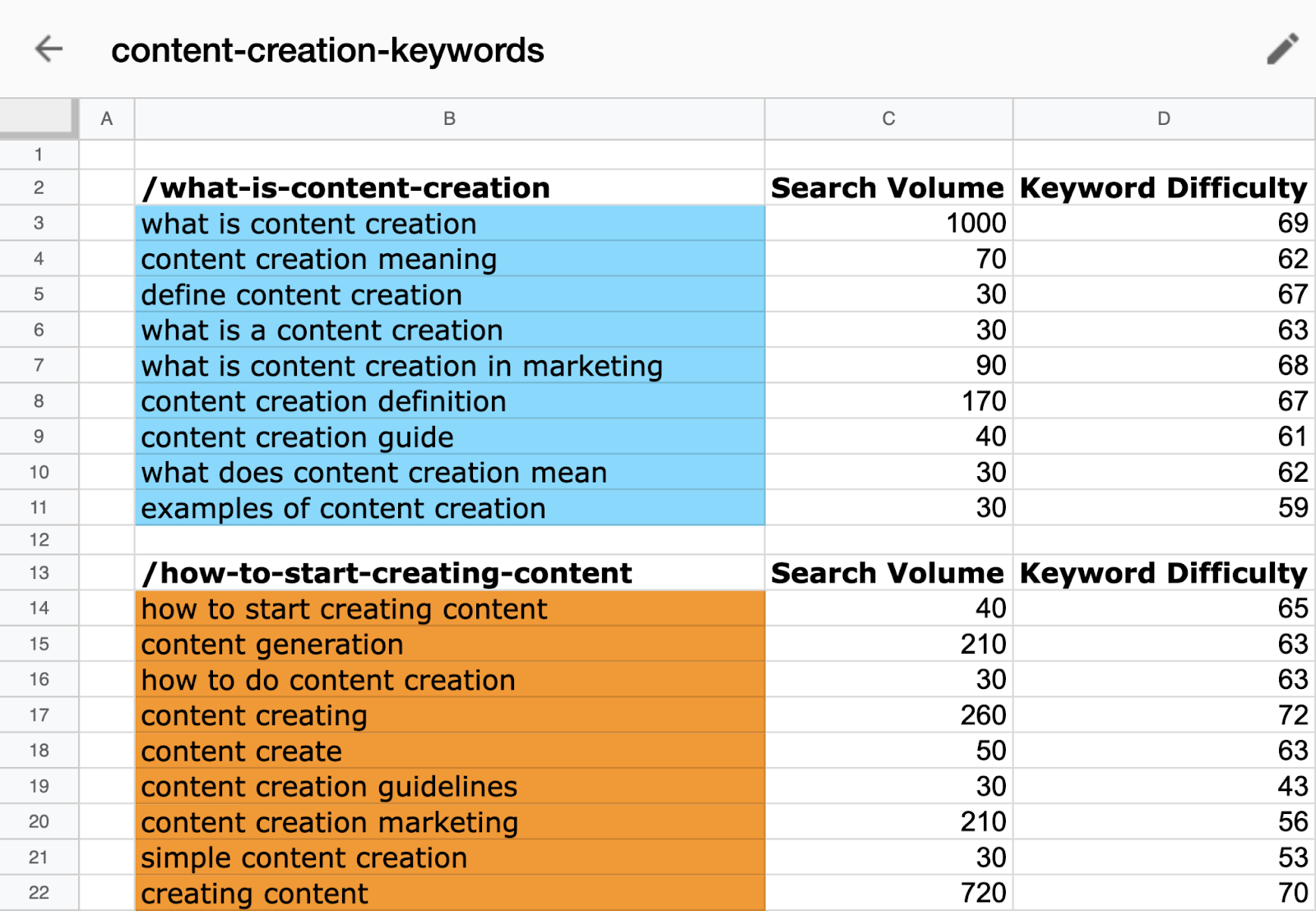
Learn how to map your keywords in just five steps with our keyword mapping guide.
12. Analyze the Search Intent of Pages That Rank
Google prioritizes content that matches search intent. There are four types of search intent:
-
Navigational: Trying to find something
-
Informational: Trying to learn more about something
-
Transactional: Trying to complete a specific action
-
Commercial: Trying to learn more before making a purchase decision
To find a keyword’s intent, use our Keyword Overview tool. Look for the “Intent” box.
If your content matches the search intent of the keyword, you’ll likely see more traffic and higher rankings. If it doesn’t, you’ll need to adjust.
13. Identify Questions People Ask
Answering queries that appear as questions can help you rank in rich SERP features like People Also Ask boxes.
Use our Keyword Magic Tool to find a list of related questions for any keyword.
Start by entering a keyword, hitting “Search,” and clicking the “Questions” filter.
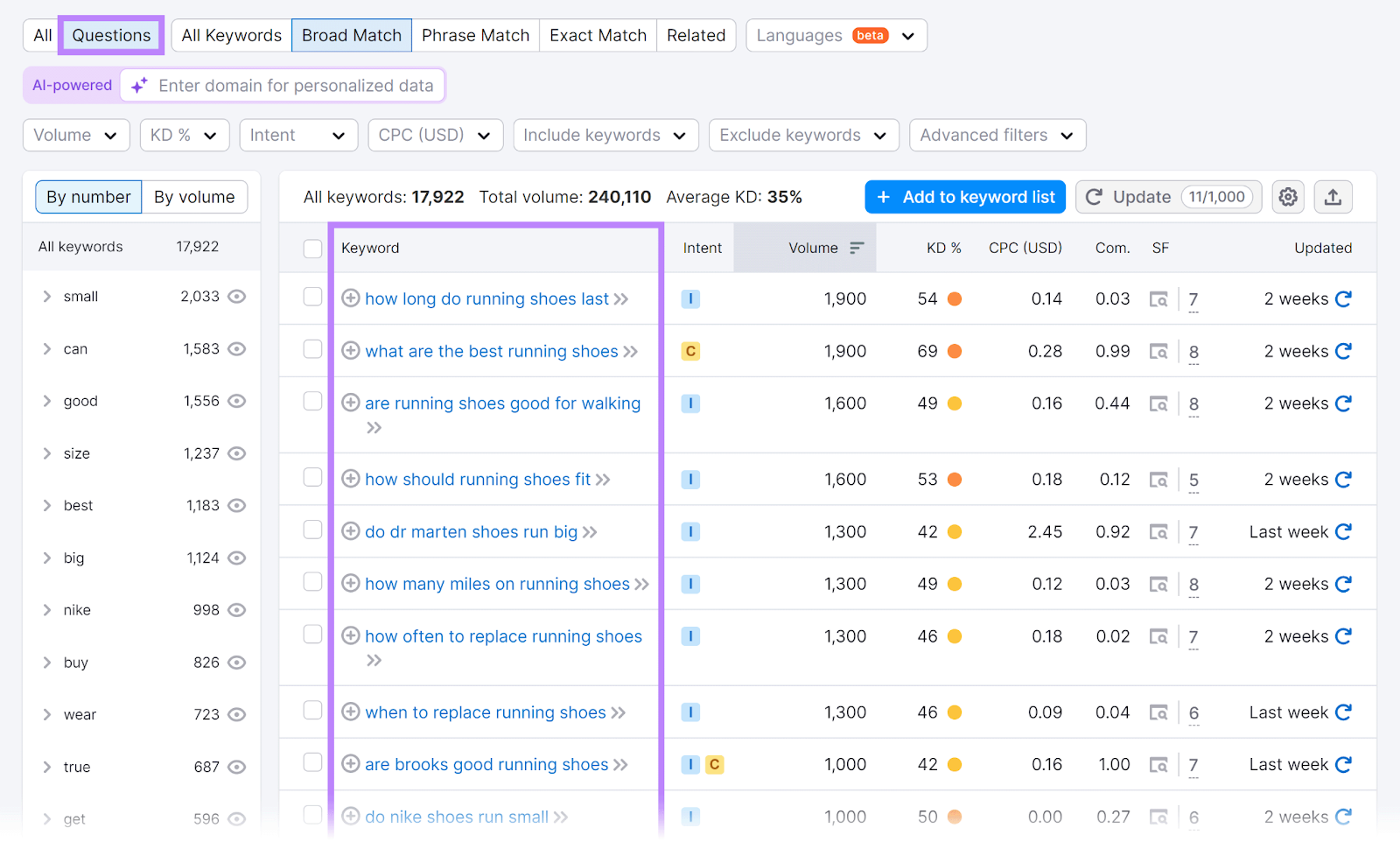
This is a great starting point, especially if you enter more specific keywords.
You can also filter the keywords by particular SERP features, including People Also Ask.
That’ll show you keywords that trigger a People Also Ask box in the SERP. Like this one:
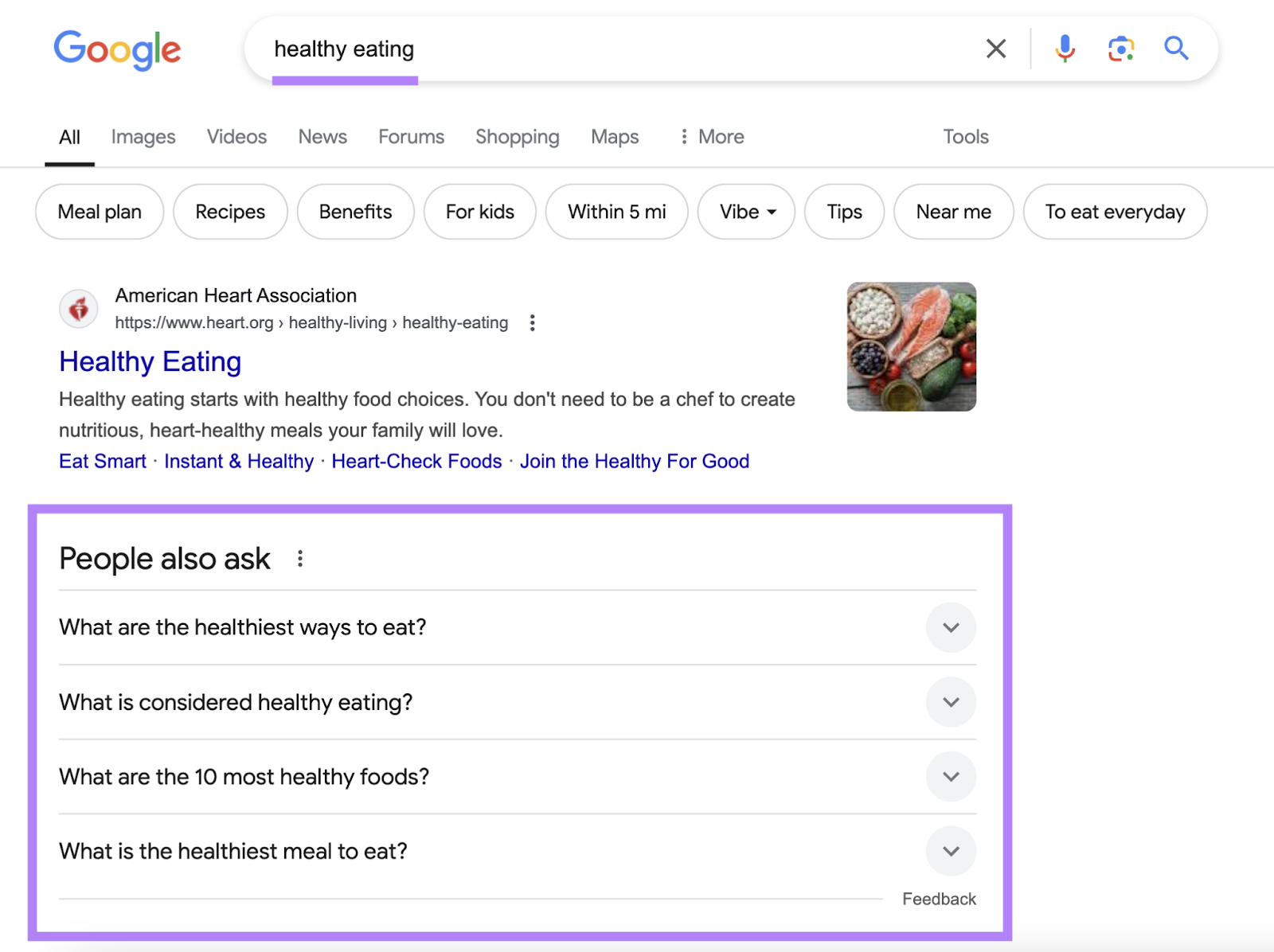
These filters will help you understand which keywords to plug into tools like AlsoAsked. To find additional question keywords.
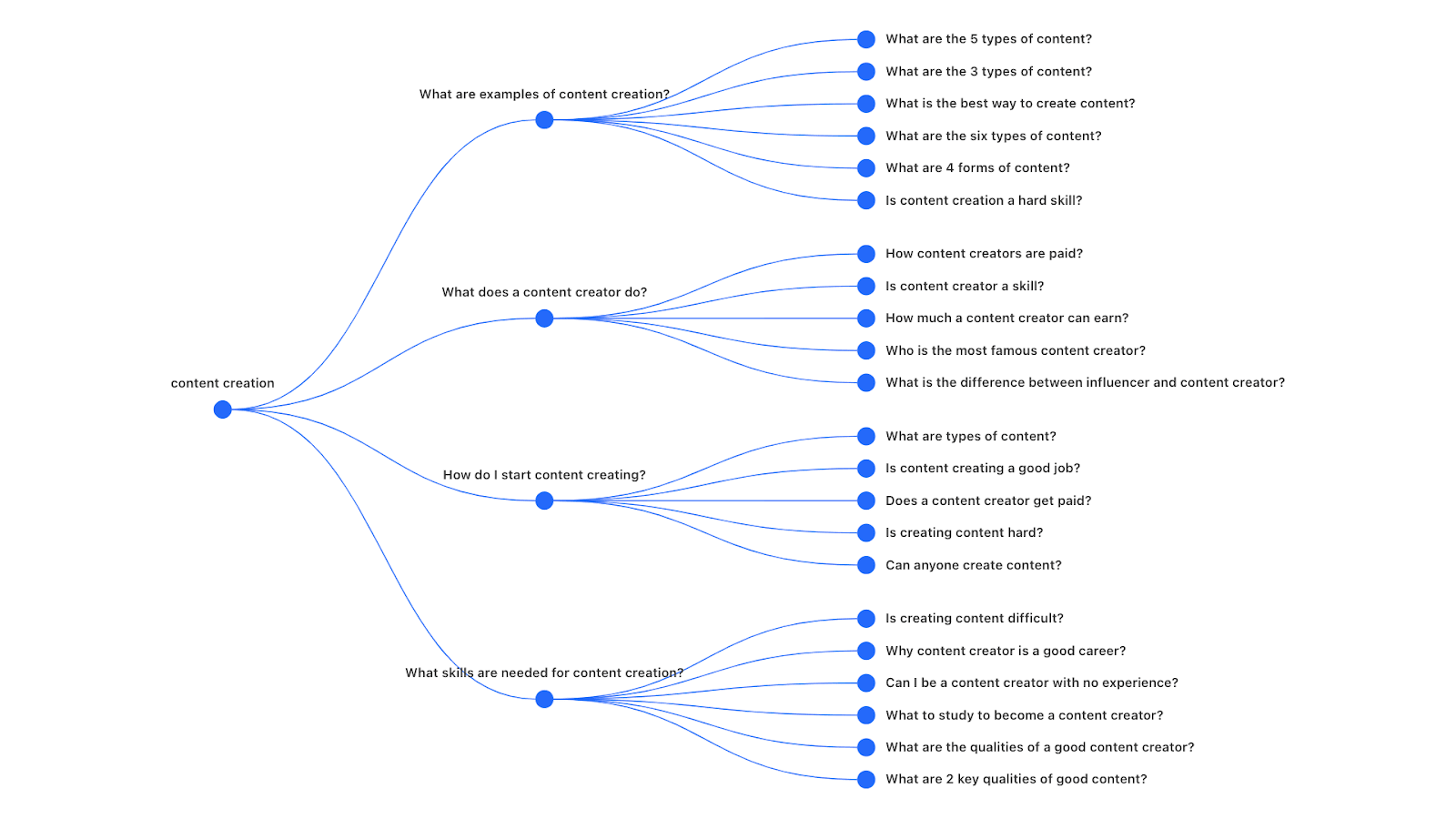
Here’s where you can use these questions:
-
FAQ pages: Create FAQ pages that answer common questions (or include FAQ sections at the bottom of your core website pages)
-
Blog posts: Use these questions as titles or subheadings in blog posts
-
Product pages: Include relevant questions and answers on product pages to address objections and improve conversion rates
-
Customer support section: Add FAQs to customer-facing documentation to resolve common issues
14. Understand Your Ranking Potential
To understand your ranking potential, use our Keyword Overview tool. Enter your term and domain to get a Personal Keyword Difficulty score.
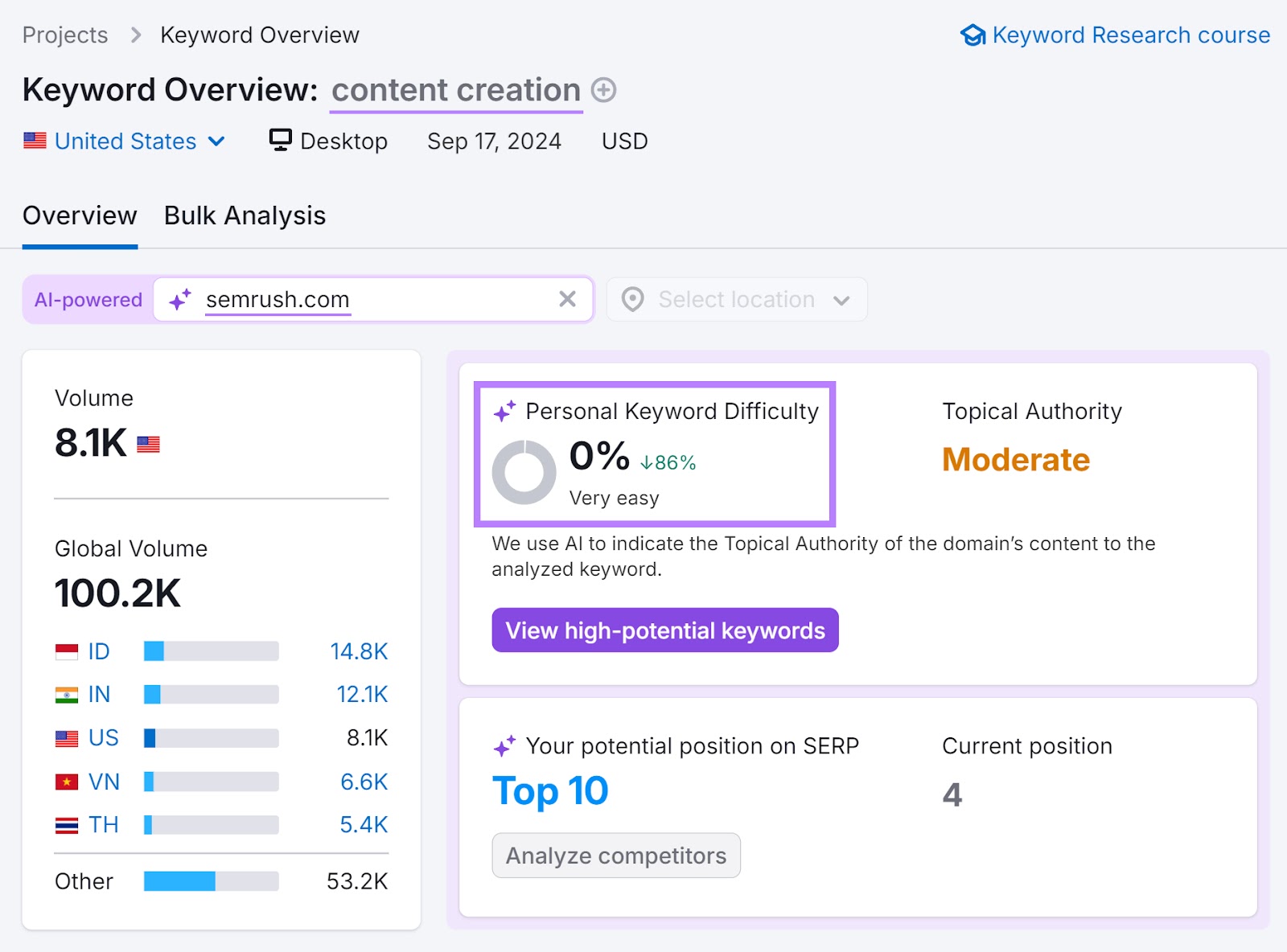
Keyword difficulty (KD) is a general estimate of the difficulty for a website to rank in Google’s top 10 results for that term. "Personal Keyword Difficulty" shows the difficulty for your specific site to rank highly for that term.
High percentages mean tougher competition. Balance difficulty with search volume to find feasible opportunities.
Technical SEO Checklist
Technical SEO ensures your site is crawlable and indexable. Follow these best practices for a stable site foundation.
15. Make Sure You’re Using HTTPS
Whether your website uses HTTPS (secure protocol) is a ranking signal.
Confirm your site is HTTPS by checking for a padlock icon in your browser’s address bar.
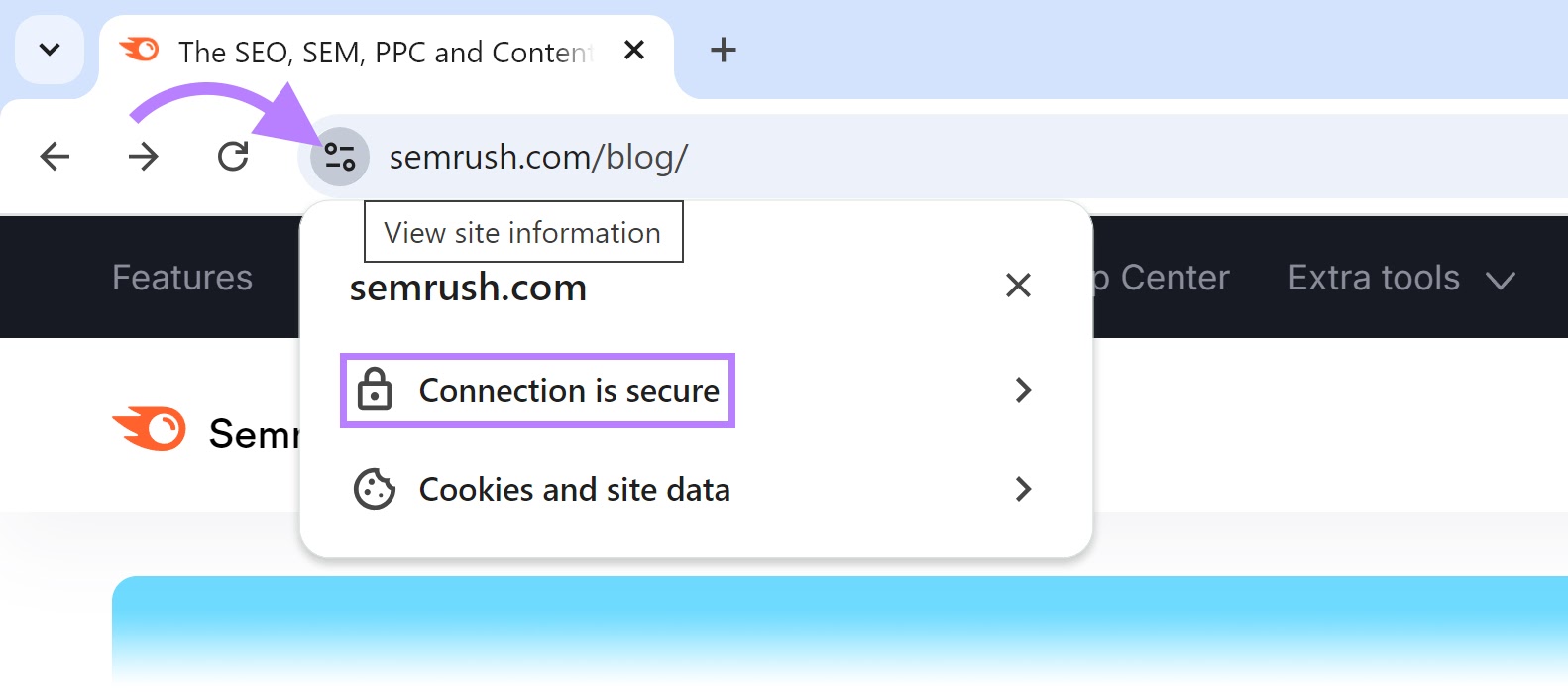
For a more detailed report on possible issues, use our Site Audit tool.
Start by adding a new project, entering your domain, and clicking “Start Audit.”
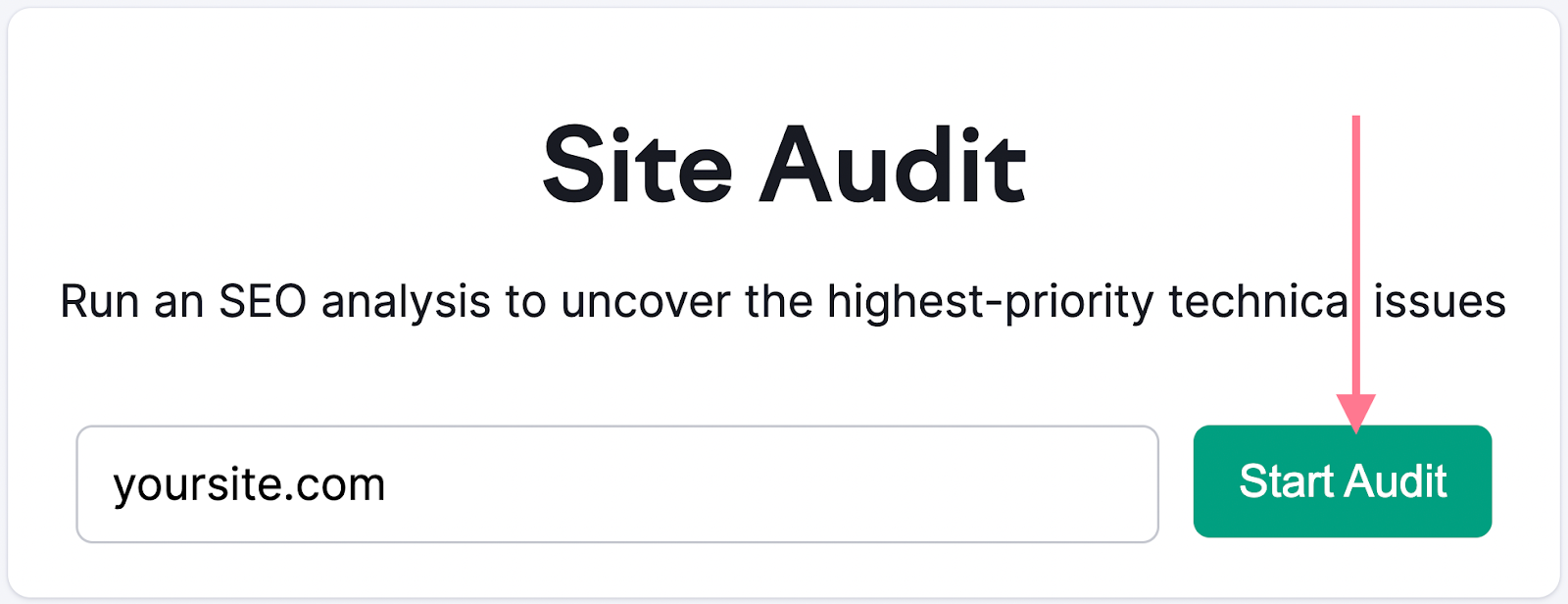
Once in the dashboard, go to the HTTPS section and click “View details.”
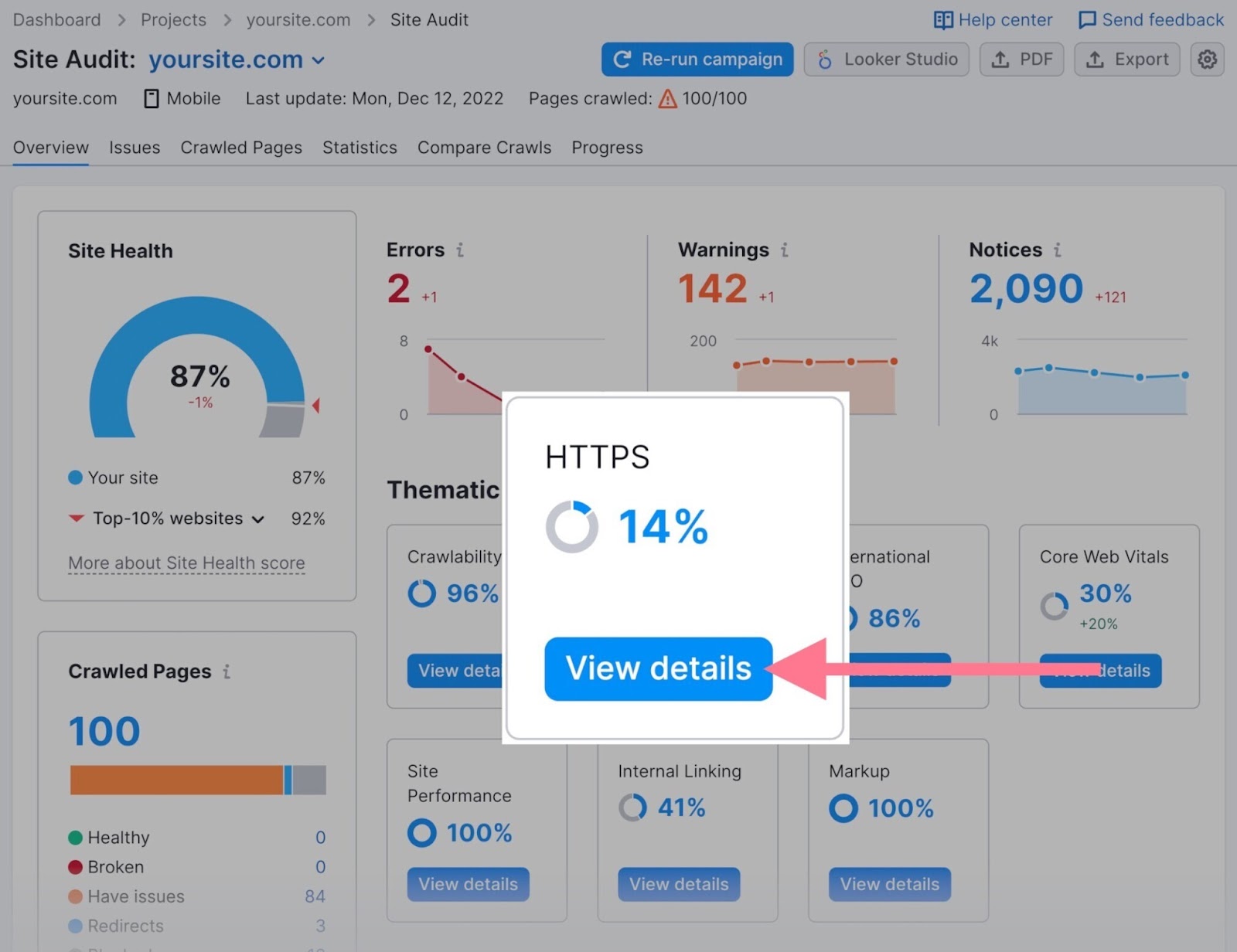
You’ll see a dashboard with information about your site’s HTTPS status, such as security certificates, server protocols, and website architecture.

Address all issues in this section.
16. Check for Duplicate Versions of Your Site in Google’s Index
Check for duplicate versions of your site to ensure you don’t experience crawling, indexing, and security issues.
Domains can appear as:
-
https://www.domain.com -
https://domain.com -
http://www.domain.com -
http://domain.com/
All versions except one should 301 redirect to your primary domain. Enter each variant in your browser to confirm redirects are set up correctly.
17. Find and Fix Crawl Errors
Crawl errors occur when search engines fail to access certain pages or encounter improper canonical tags. You can quickly identify any crawl errors through Google Search Console.
Head to the “Pages” report under “Indexing:”
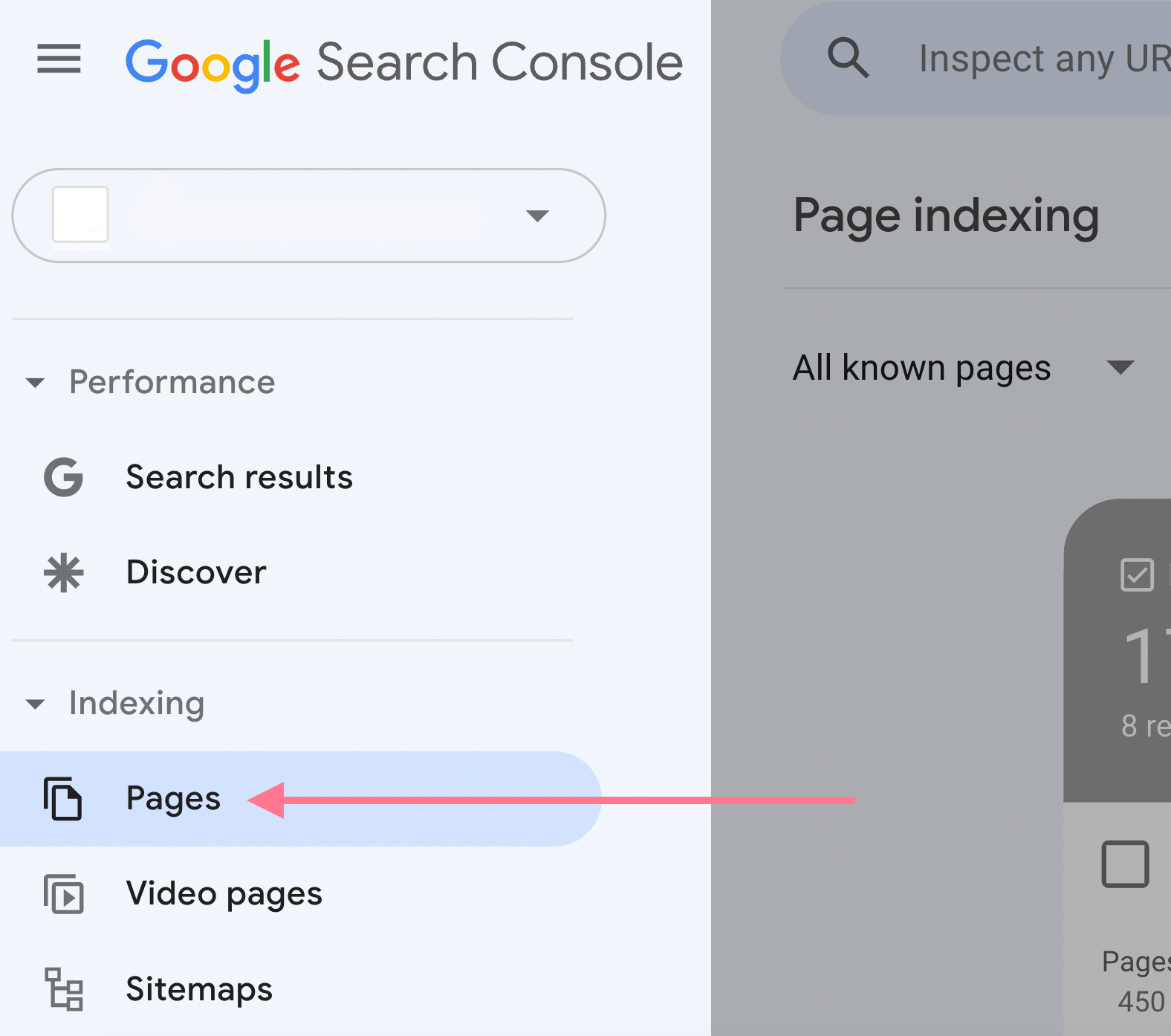
You’ll see two categories, “Indexed” and “Not indexed.”
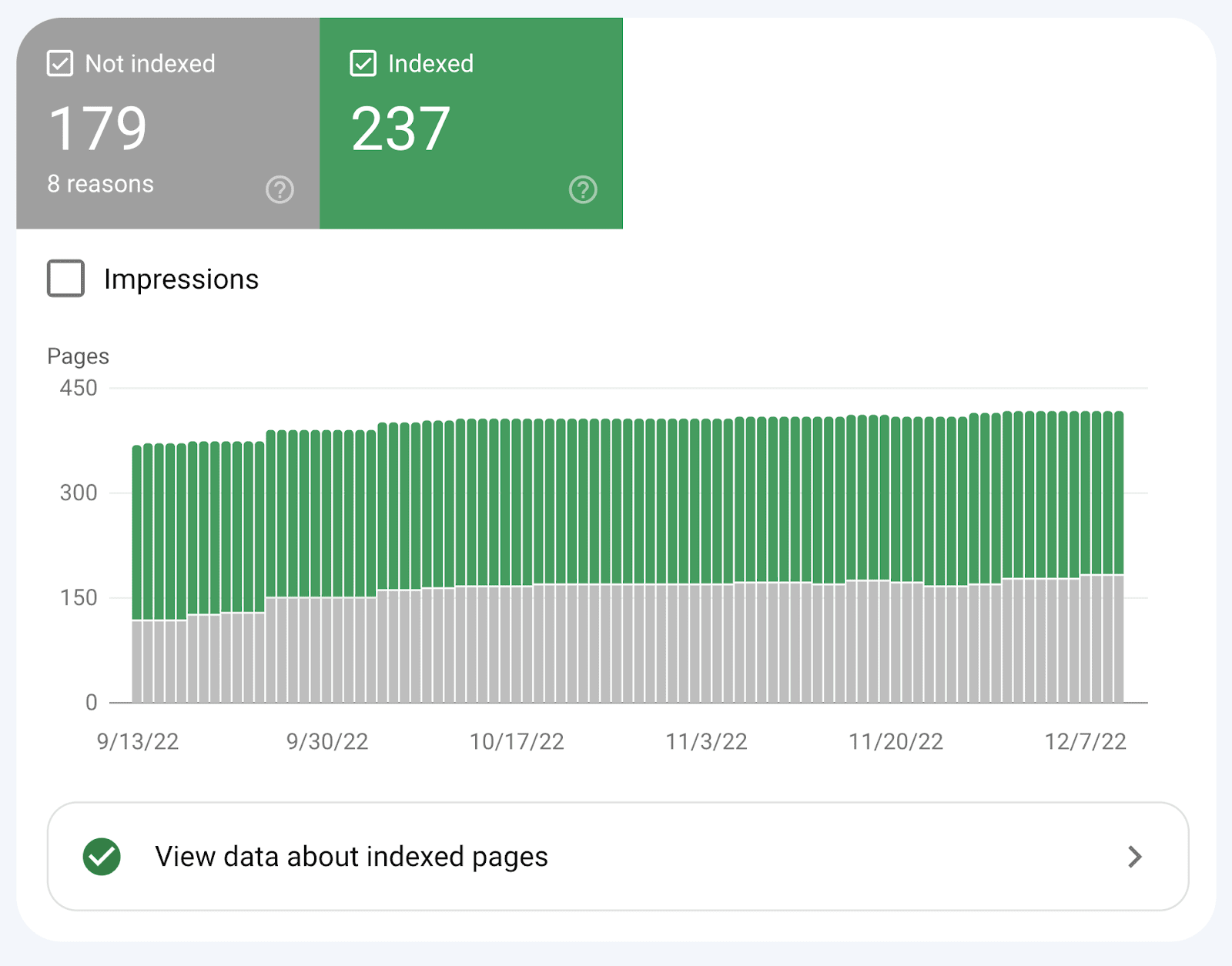
Crawl errors will be under the “Not indexed” category.
Take the time to resolve any errors you find and explore the cause of excluded URLs in more detail.
18. Improve Your Site Speed
Work on improving your site speed, because slow sites create poor user experiences. Google uses Core Web Vitals metrics to measure page speed:
-
Largest Contentful Paint (LCP): Measures the time needed for the main content of a page to load
-
Interaction to Next Paint (INP): Tracks the time from when a user interacts with the page to when the visual response is observed. In Semrush tools, we approximate this with a metric called Total Blocking Time (TBT).
-
Cumulative Layout Shift (CLS): Assesses the extent of unexpected layout shifts during page loading
You can use Google’s PageSpeed Insights tool to gauge Core Web Vitals information for individual pages.
Enter a URL, click “Analyze,” and scroll to see the page’s performance score and a list of recommendations.

For a more detailed report that covers your entire site, head over to Site Audit and click “Core Web Vitals.”
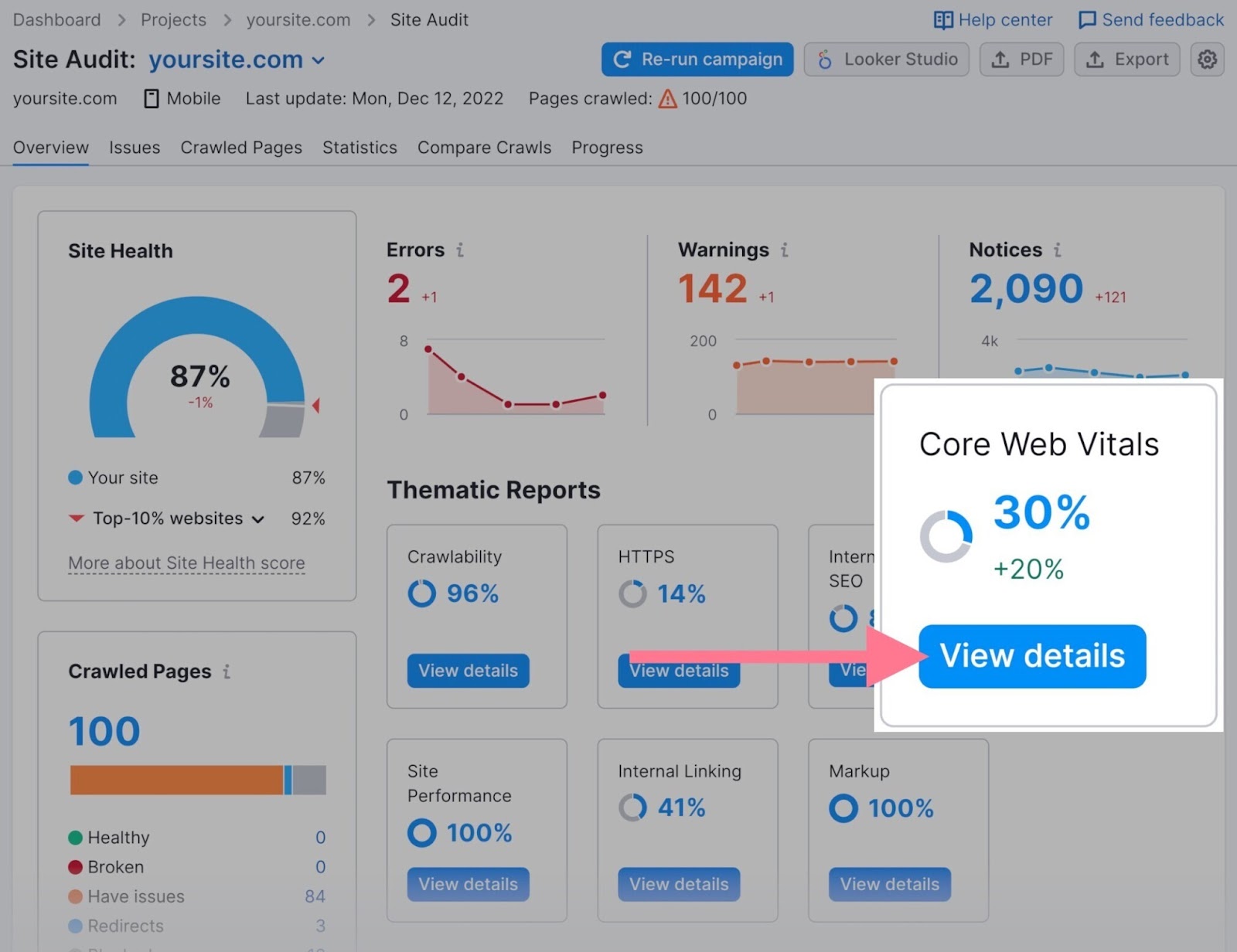
You’ll see a snapshot of your Core Web Vitals and recommendations for improvement.
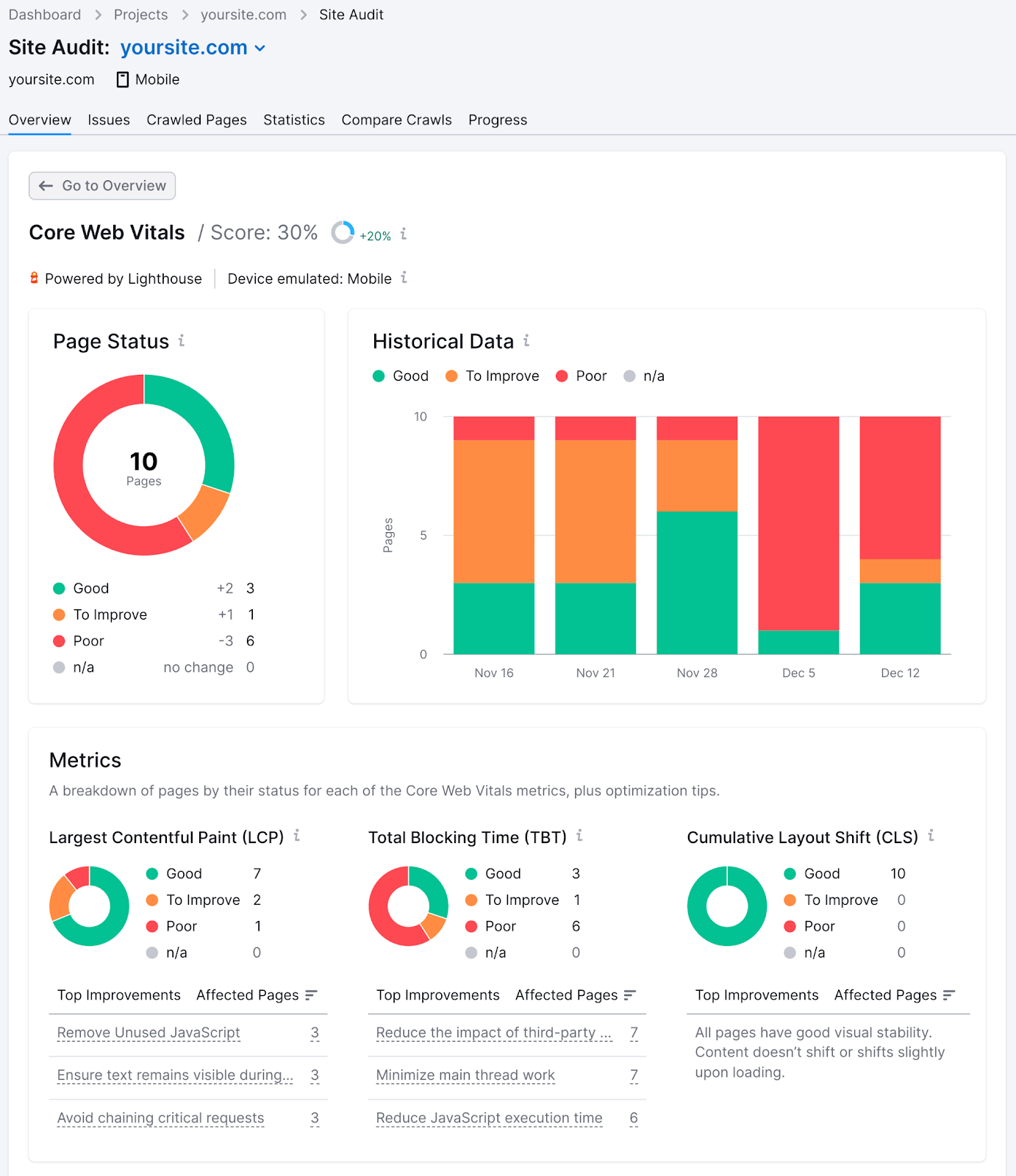
You can then focus your efforts on improving the pages flagged in this report.
19. Fix Broken Internal and Outbound Links
Broken links (404 errors) disrupt user experience. To quickly find (and fix) broken links, head to Site Audit.
Look for the “Internal Linking” box and click “View details.”
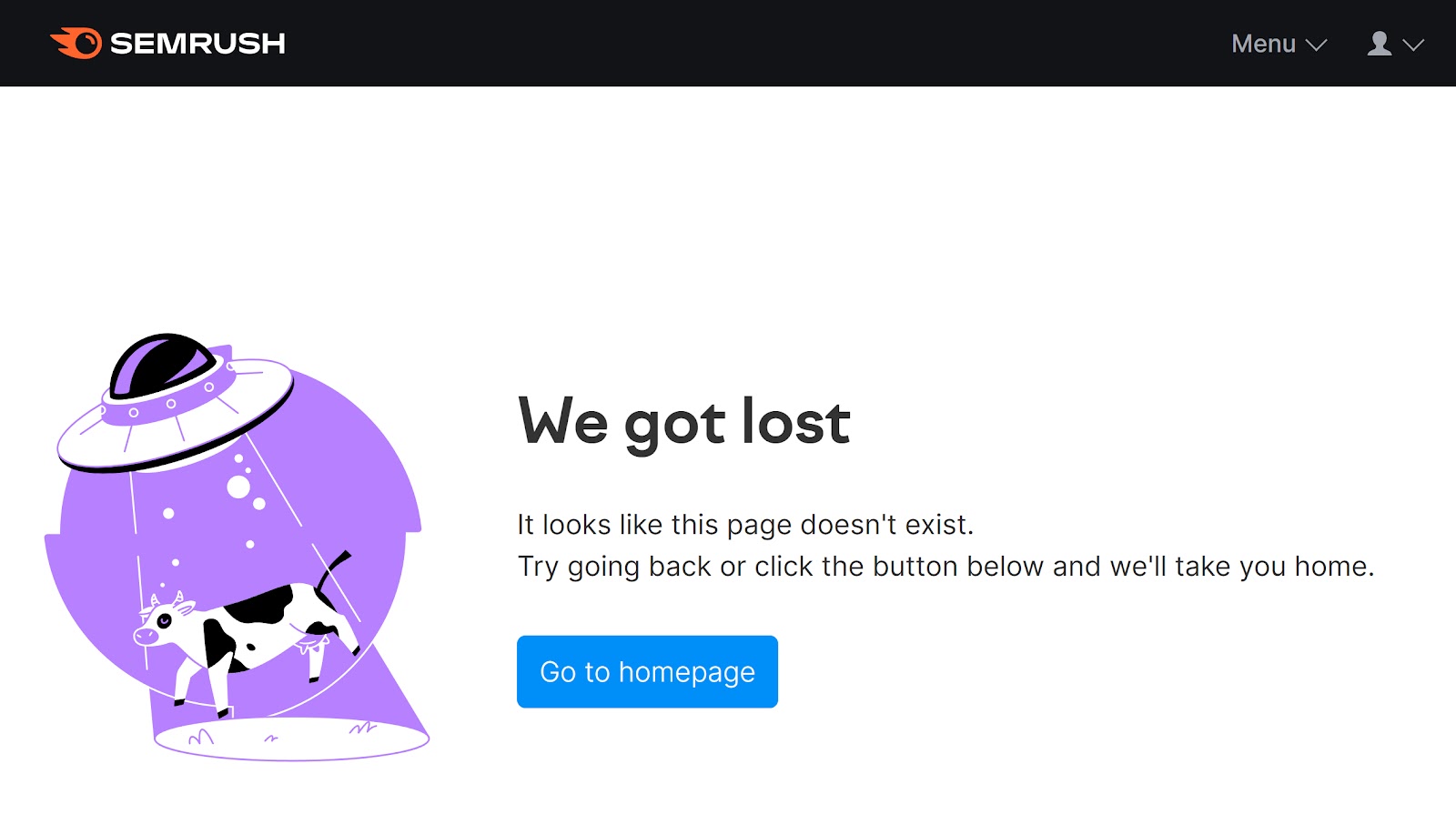
You’ll see a list of broken internal and external links.
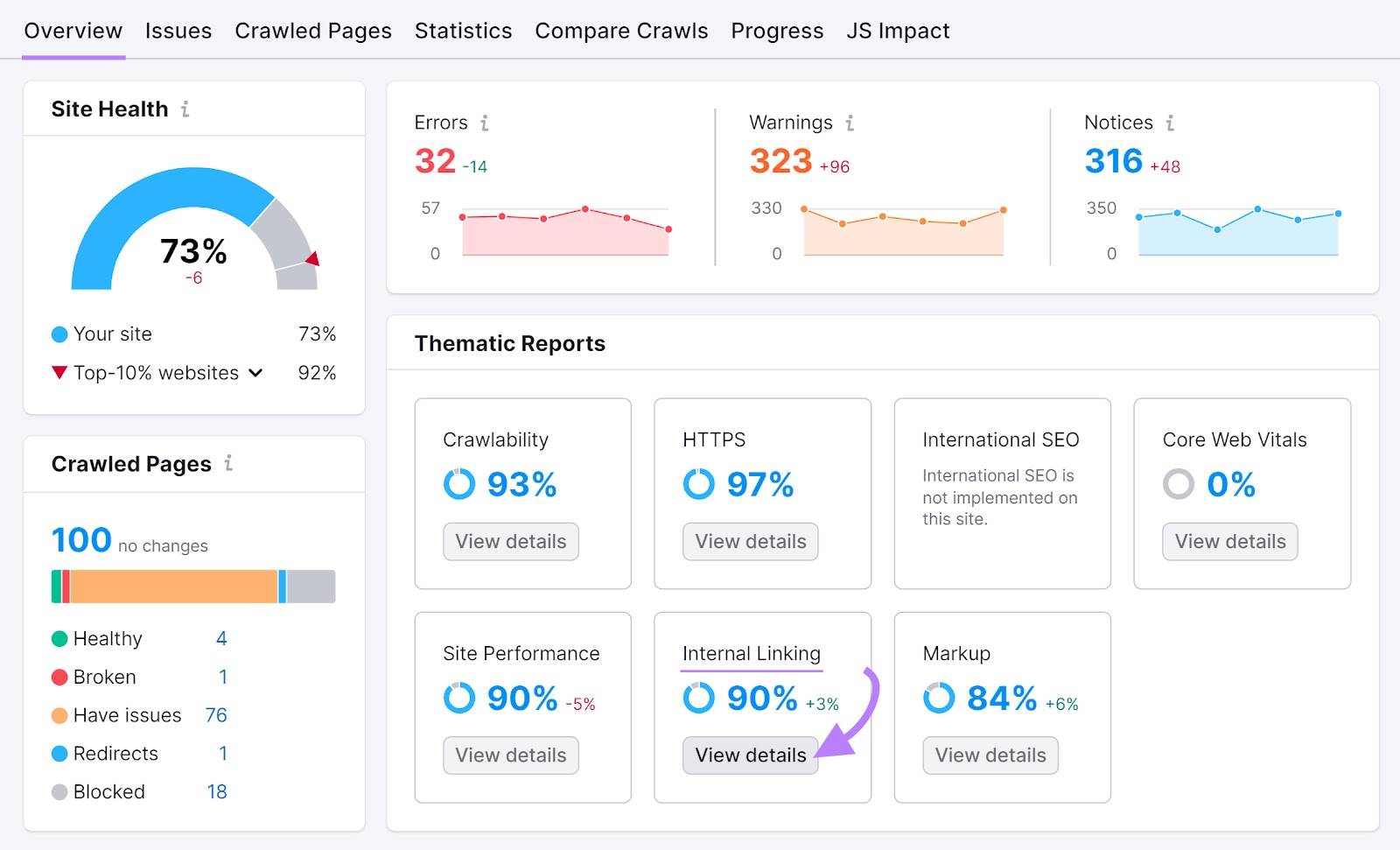
You’ll see a list of broken internal and external links.
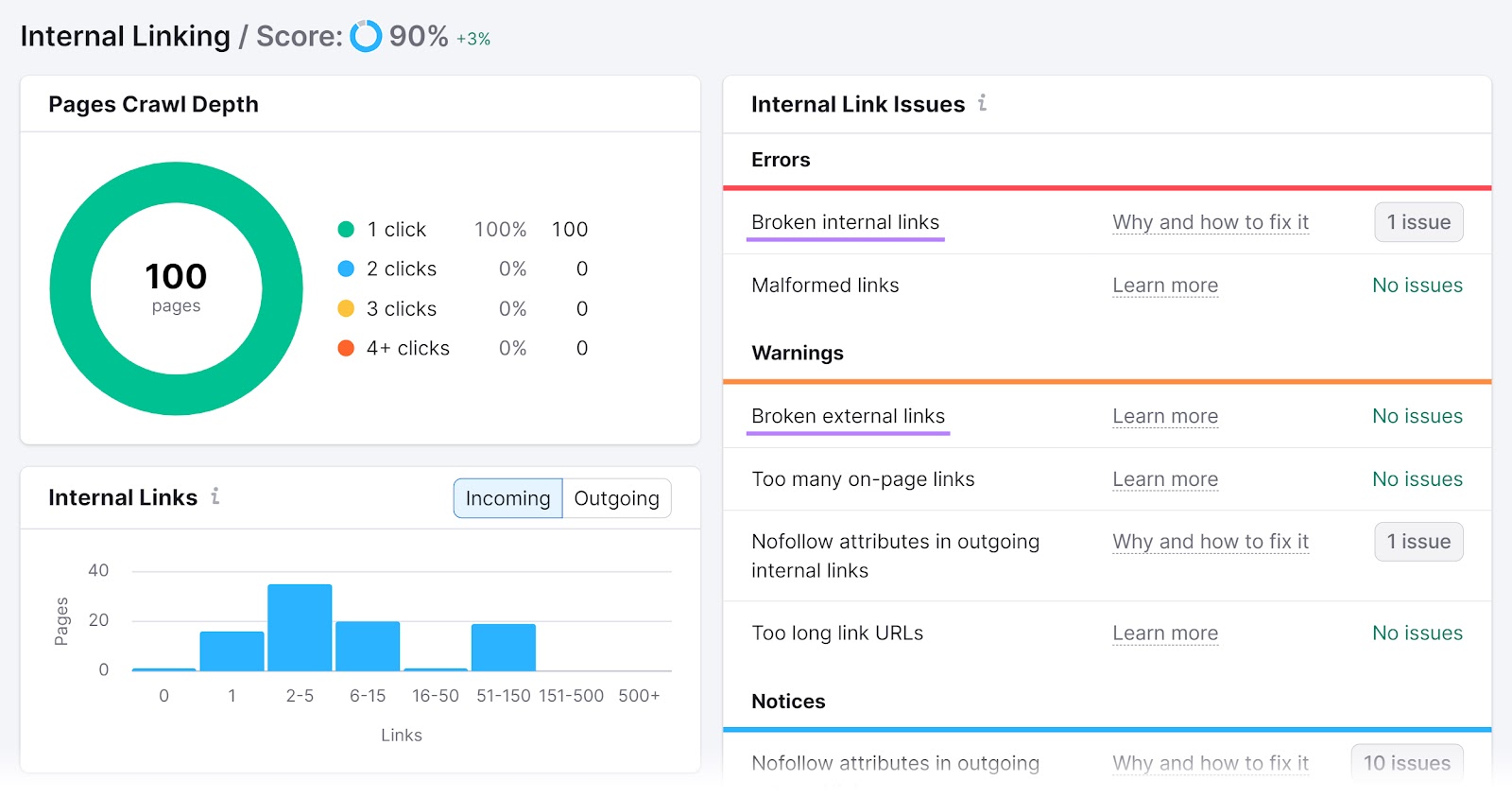
Fix broken links by either updating the target URL, setting up a redirect, or removing the link altogether.
20. Find and Fix HTTP Links on HTTPS Pages
Using HTTPS but linking internally to HTTP pages triggers unnecessary redirects. Unnecessary redirects can slow down your website.
Head to the “HTTPS Report” inSite Audit to reveal any HTTP link issues and discover how to fix them.
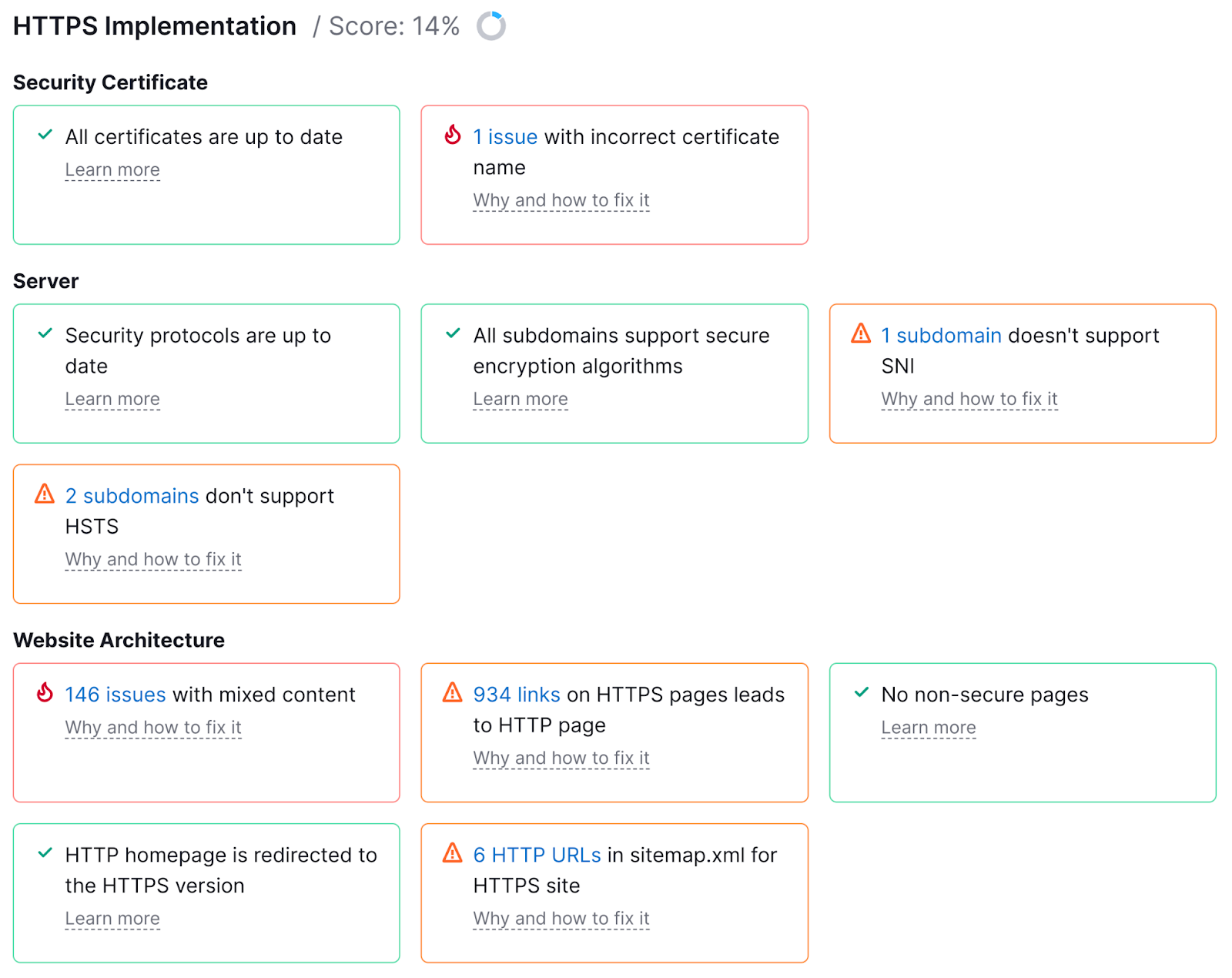
21. Make Sure Your Website Is Mobile-Friendly
Google moved from mobile-first indexing to mobile-only indexing, which means Google will no longer index websites that aren’t accessible via mobile devices.
You can use Google Chrome to test your site’s mobile-friendliness.
Simply launch a website on Chrome and right-click on any page you want to test. Then, select “Inspect.”
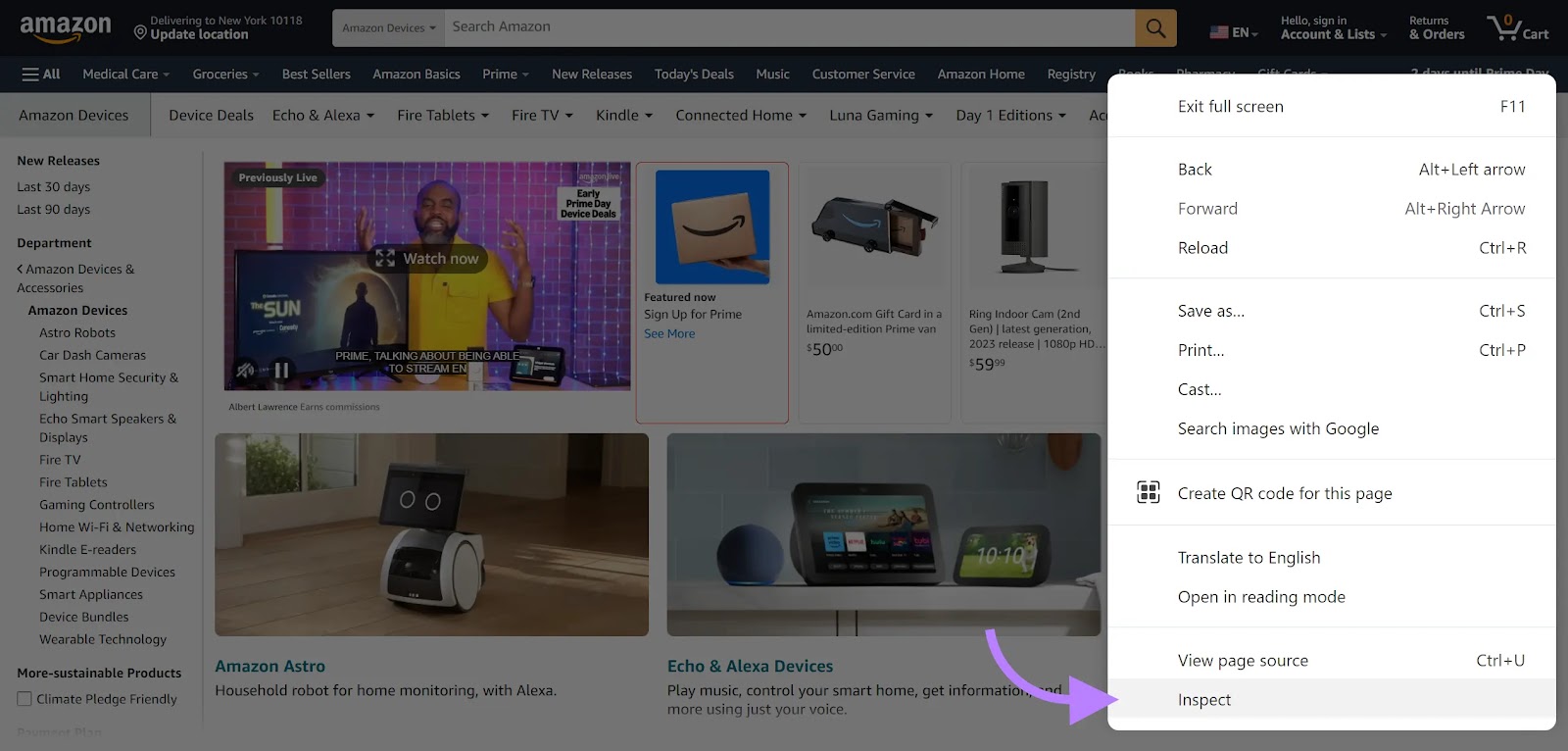
Here, you can test how your site looks on different devices.
Select the device icon on the right-hand side to switch between desktop and mobile.

Next, you can select your preferred device to test how your site looks across each.
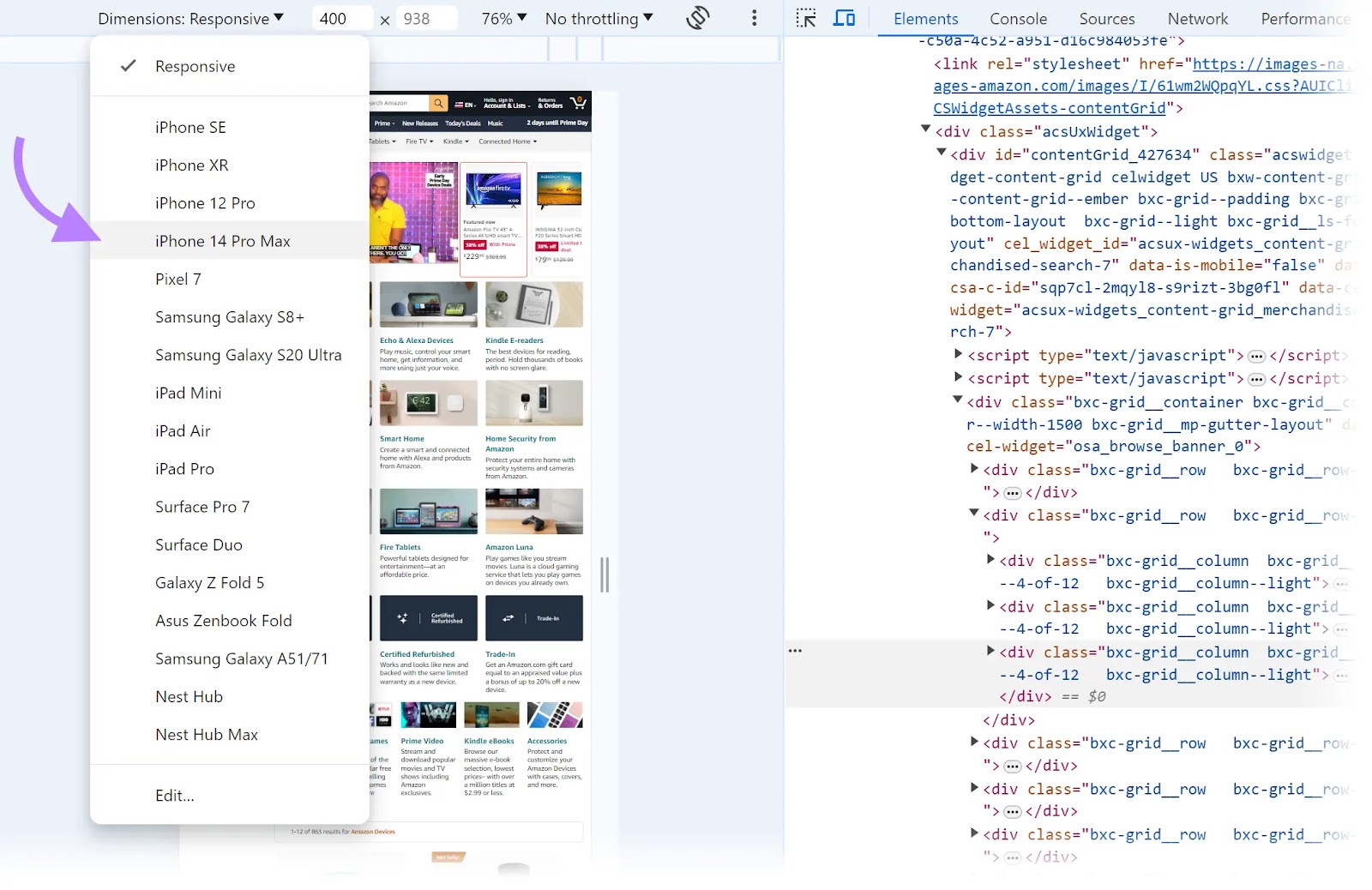
Check to make sure everything looks right and is easy to use on mobile devices, and make sure key elements like text and buttons are big enough to read and click.
22. Use an SEO-Friendly URL Structure
An SEO-friendly URL structure should be short, descriptive, and use hyphens to separate words. Like:
https://www.comain.com/red-shoes/
As opposed to a query string that isn’t descriptive:
https://www.comain.com/category.pjp?id=32
Do use hyphens in your URLs to separate words. Don’t use underscores.
Do keep URLs as short as possible. So they’re easier to read.
23. Add Structured Data
Structured data (schema markup) highlights page information for search engines. It can enable rich snippets for reviews, recipes, products, and event.
Schema markup can look like this for reviews:
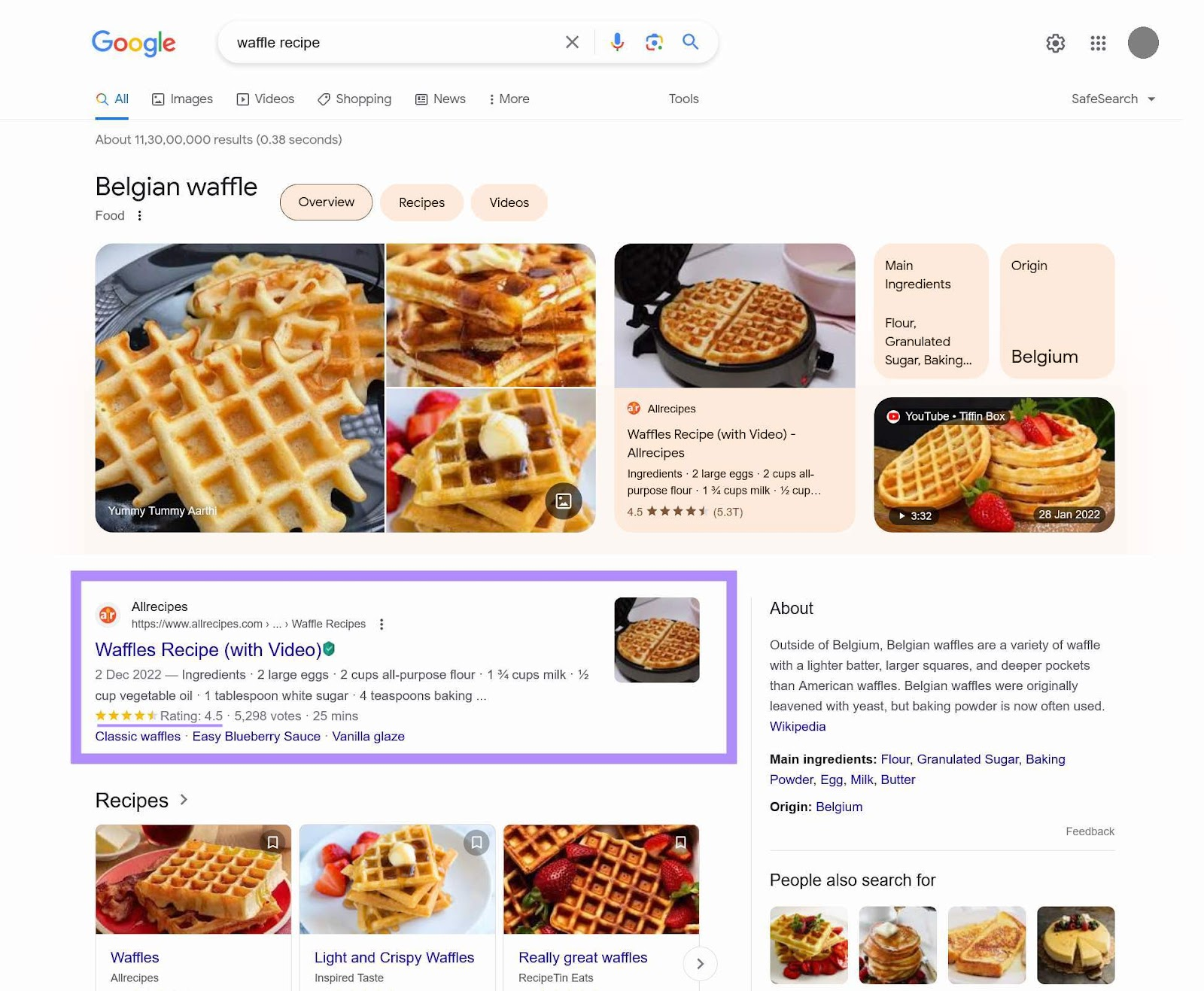
See our structured data guide for best practices.
24. Check Your Site’s Crawl Depth
Check that important pages are within three clicks of the homepage. You can quickly find your site’s crawl depth in Site Audit under “Internal Linking.”
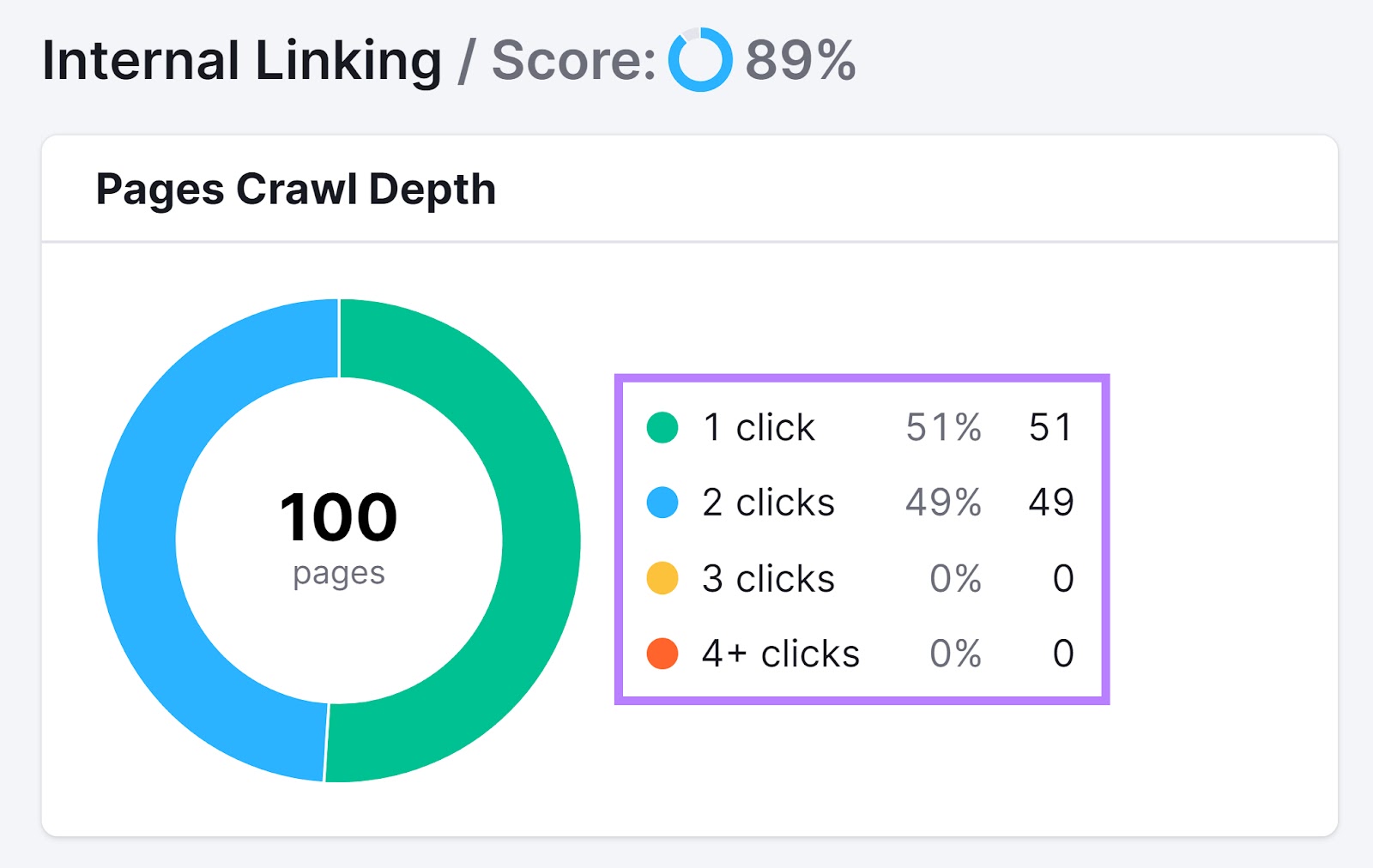
If your site has a lot of pages that are more than three clicks away from the homepage, consider simplifying your main navigation and working to incorporate more internal links.
25. Check Temporary 302 Redirects
302 redirects are temporary, while 301 redirects are permanent.
302 redirects are sometimes mistakenly used instead of 301s.
Google has confirmed that 302 redirects can pass ranking authority, but a 302 should be updated to a 301 when you know the move will stay in place permanently.
You can find your site’s 302 redirects using Site Audit.
Go to the “Issues” tab and search for “temporary redirects.”
Like this:
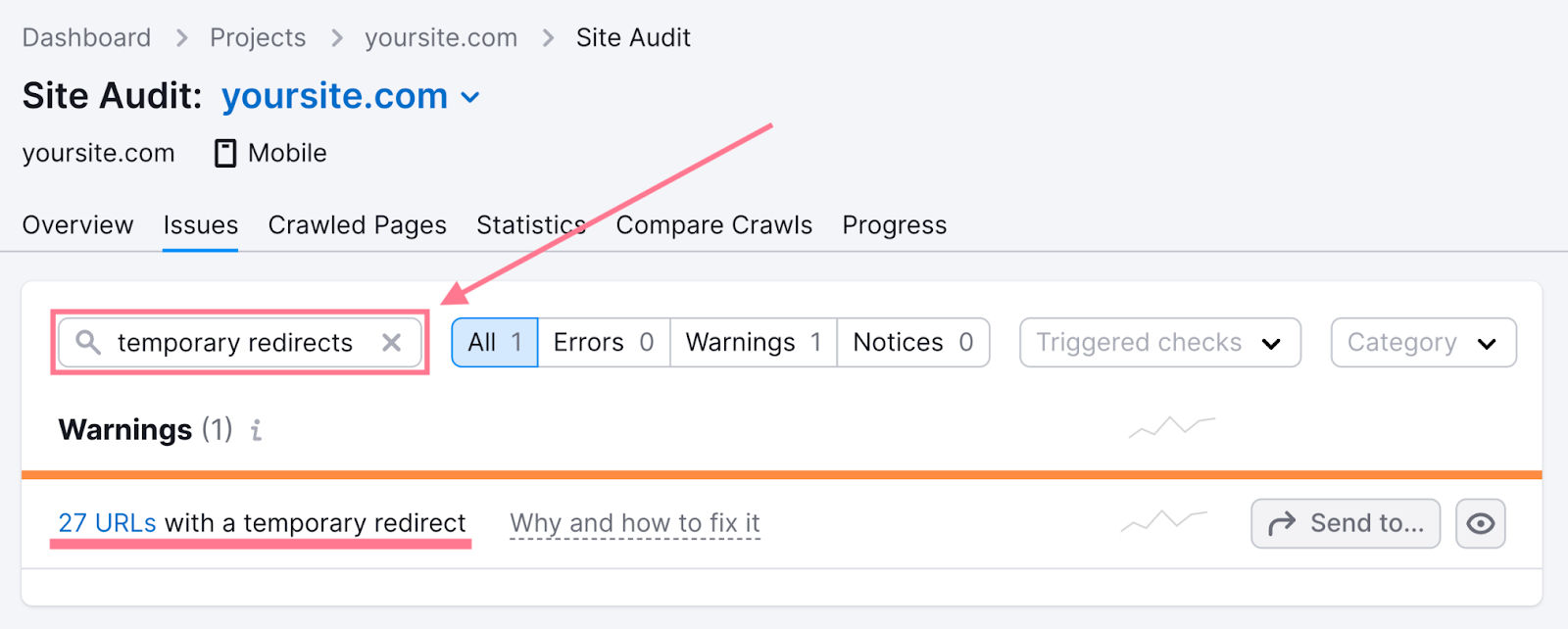
26. Find and Fix Redirect Chains and Loops
A redirect chain sends users through multiple redirects, which slows page loading.
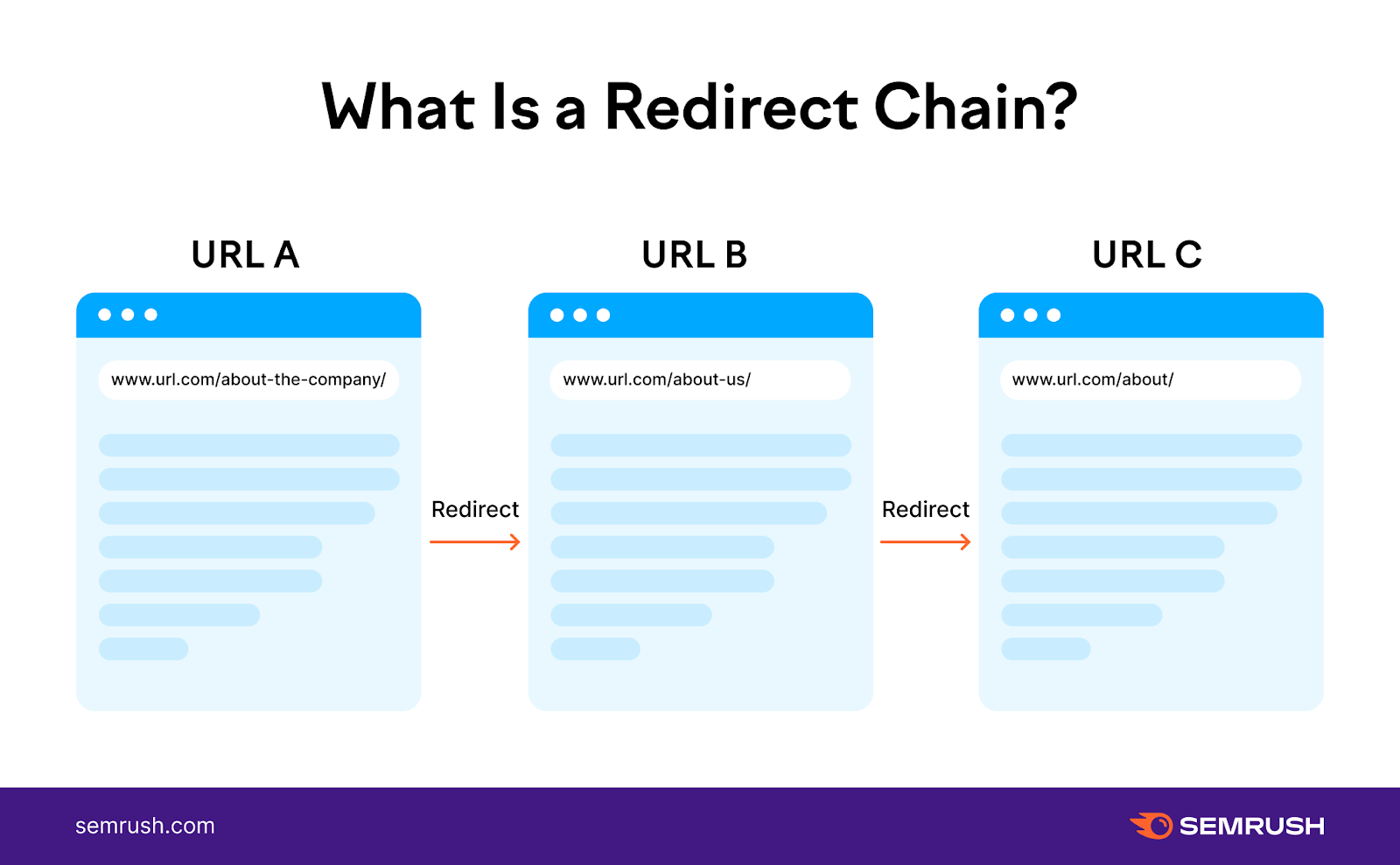
A redirect loop sends a page back to itself. This results in an endless loop that never lands on a page.
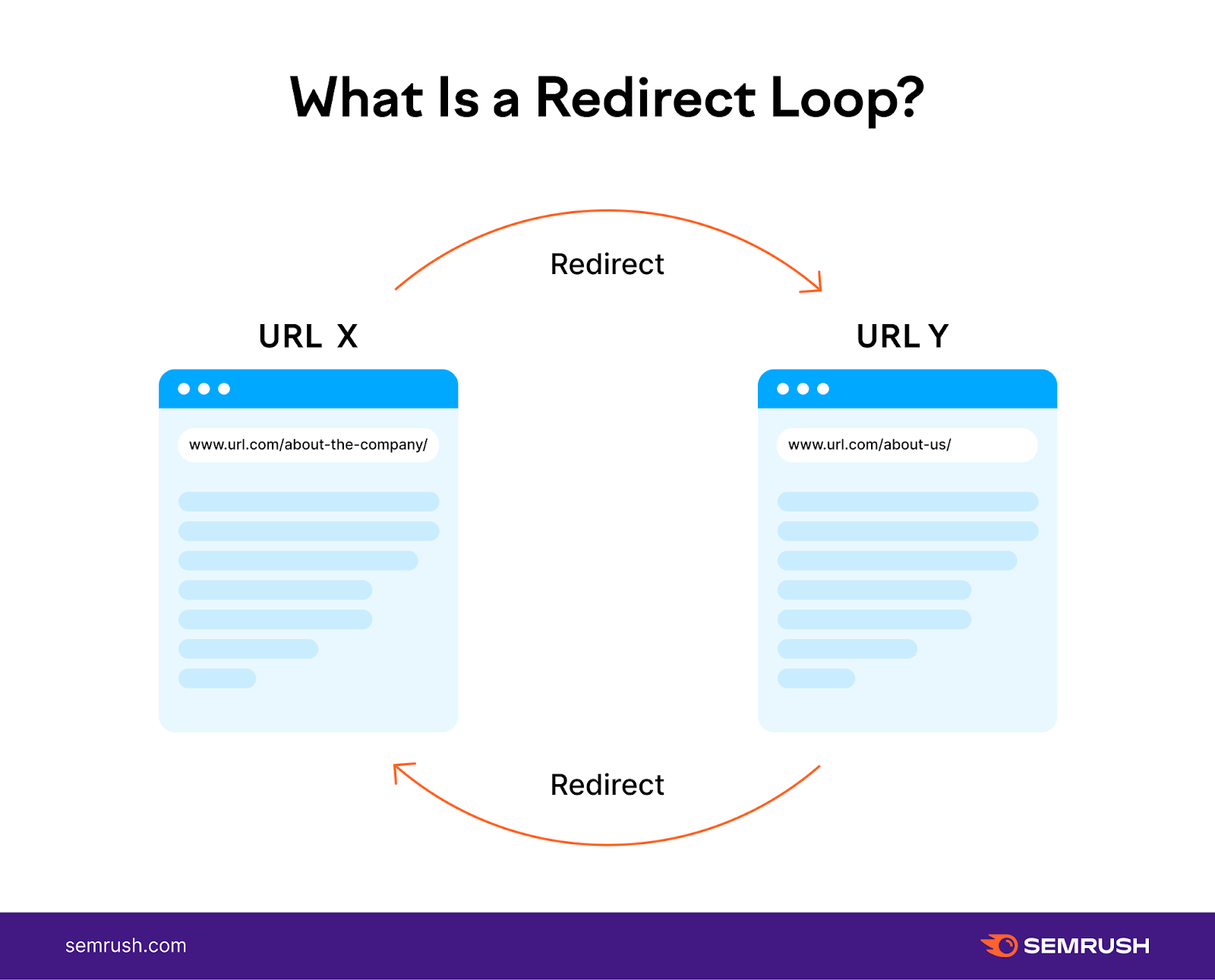
The “Issues” tab in Site Audit will highlight any redirect chain or loop issues. Just search for “redirect chain.”
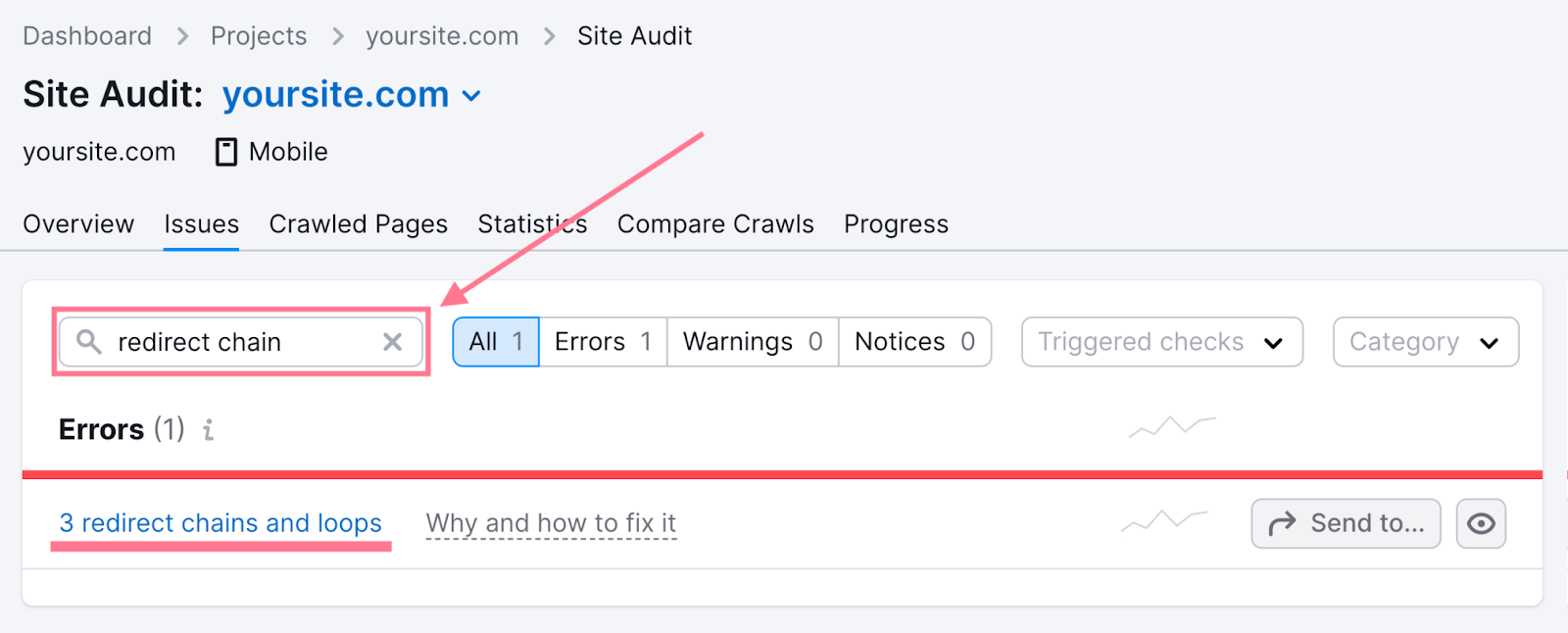
You can resolve these issues by updating all redirects in a chain to point to the end target or by updating the redirect causing the loop.
Content & On-Page SEO Checklist
Great content and on-page optimizations engage users and improve rankings. Use these tips to keep your content strong and relevant.
27. Find and Fix Duplicate, Missing, and Truncated Title Tags
Title tags communicate a page’s topic to search engines and users. You can see a page’s title tag in its source code:

For the best title tags, avoid:
-
Duplicates
-
Missing tags
-
Overly long tags (Google truncates after ~60 characters)
You can quickly audit your title tags in Site Audit under the “Issues'' tab. There, search for “title tags.”
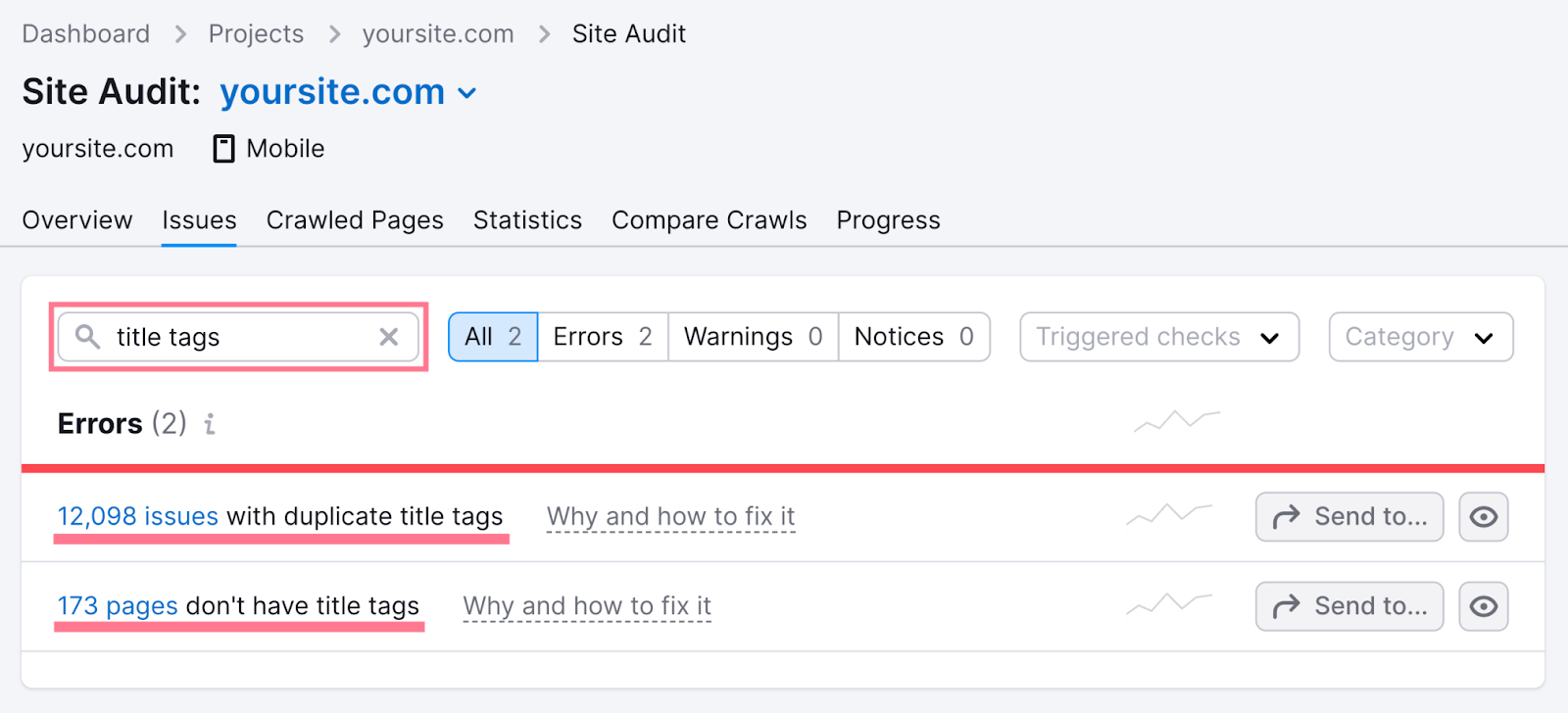
You can click on “Why and how to fix it” to read more about each issue and get tips on how to address it.
28. Find and Fix Duplicate and Missing Meta Descriptions
Meta descriptions aren’t a ranking factor, but they influence click-through rates. They should be unique, concise, and relevant.
You can audit your meta descriptions in Site Audit under the “Issues” tab. There, search for “meta descriptions.”
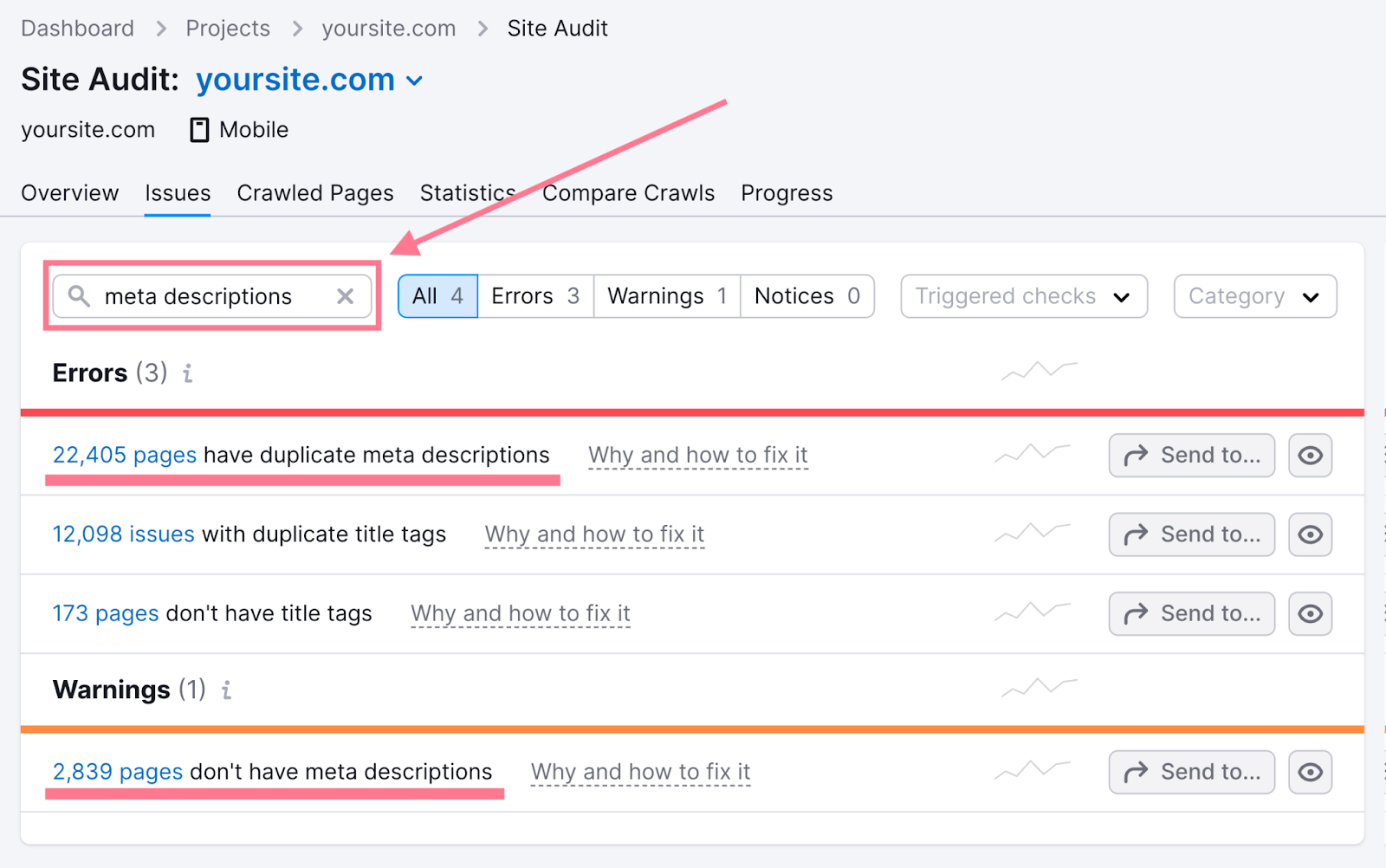
29. Find and Fix Multiple H1 Tags
Each page needs a single H1 tag that describes the main topic. Multiple H1s can confuse users and search engines.
Site Audit’s “Issues” tab flags pages with H1 tag errors. Just search for “h1.”
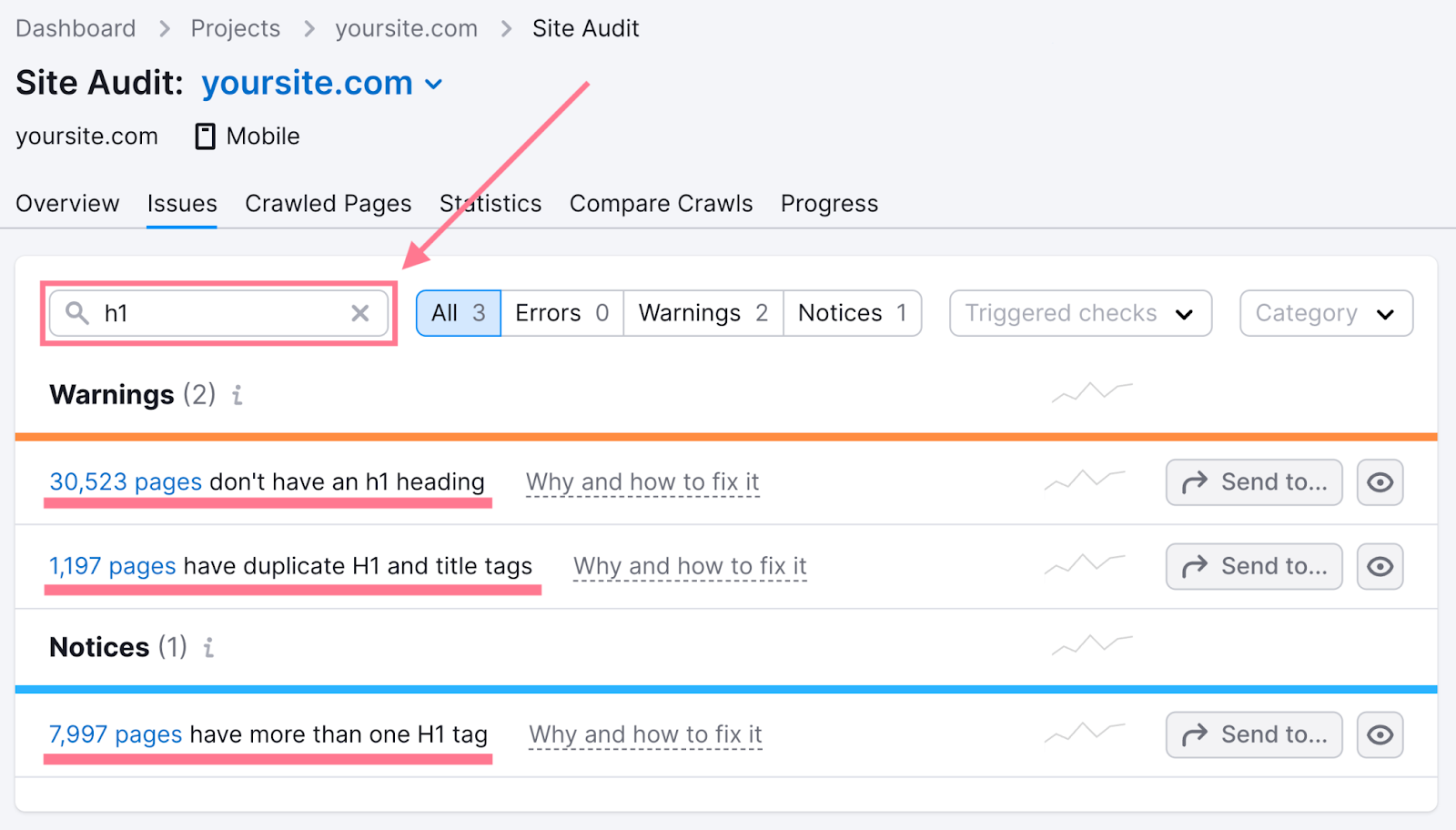
Then, take the time to resolve any issues regarding your H1s.
30. Optimize Title Tags, Meta Tags, and Page Content
To optimize title tags, meta tags, and page content, head to Google Search Console and go to “Search results” under “Performance.”
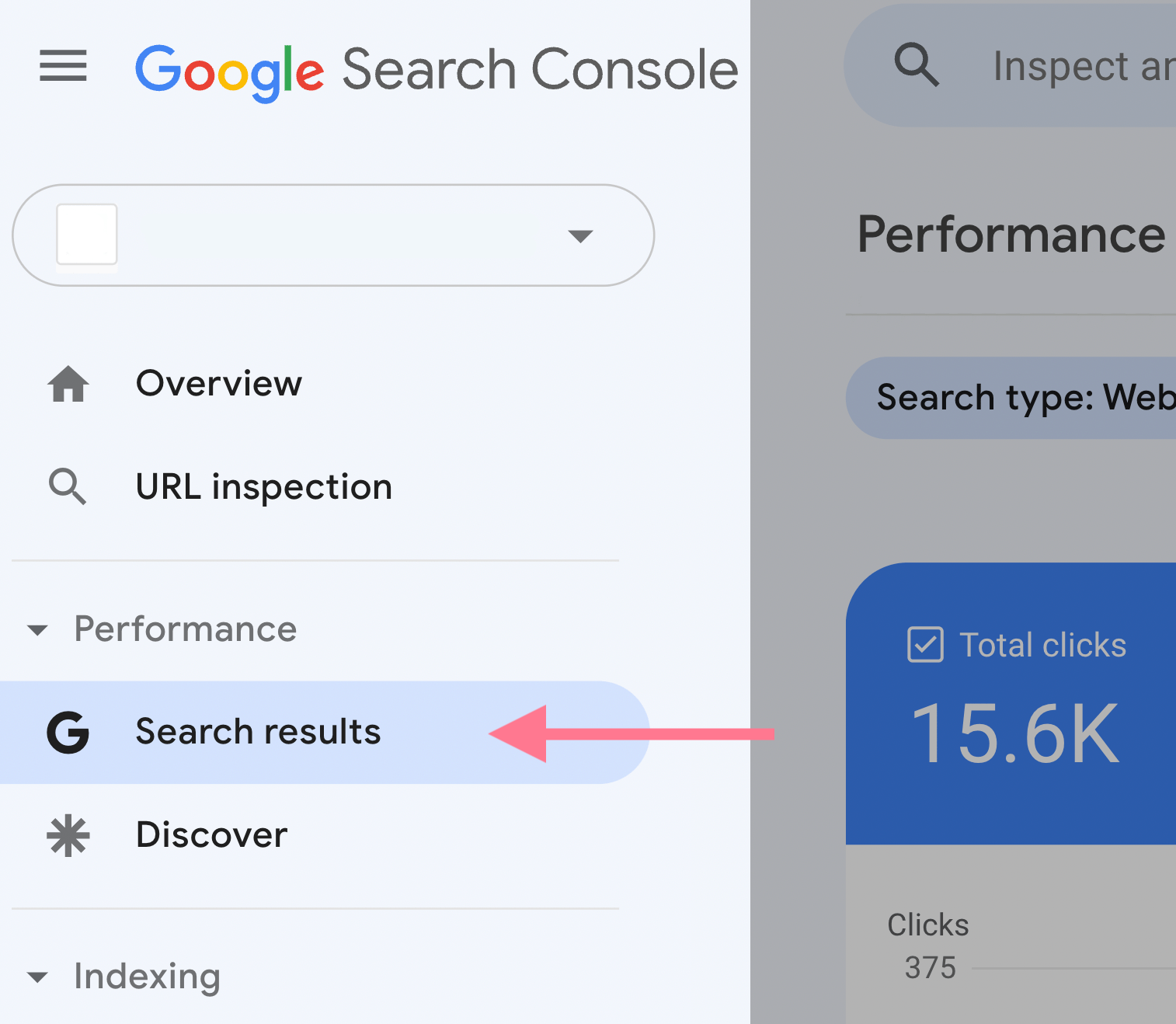
Make sure “Average CTR” and “Average position” are checked.
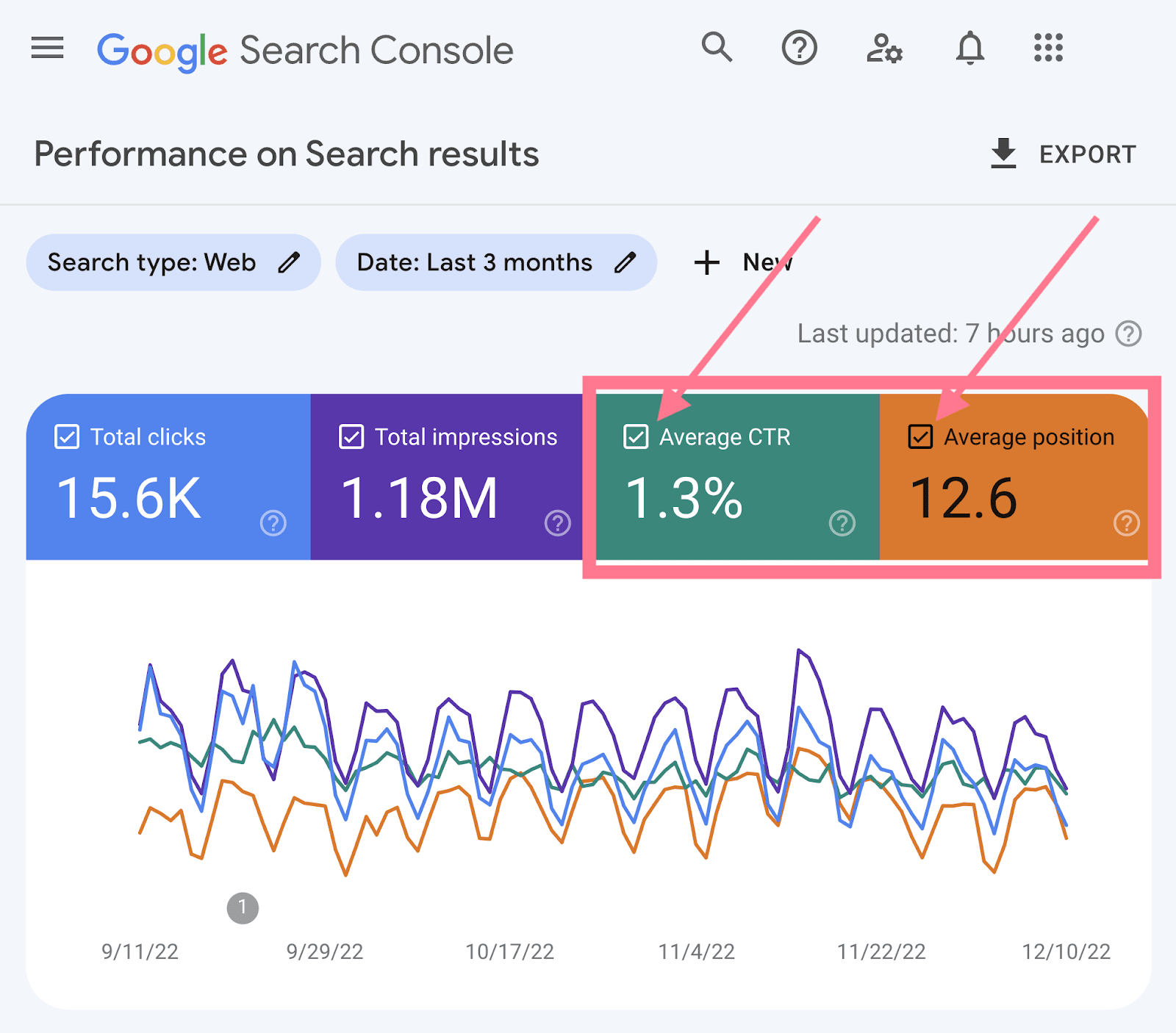
Scroll down and look for keywords with a significant number of impressions but few clicks and a low average position.
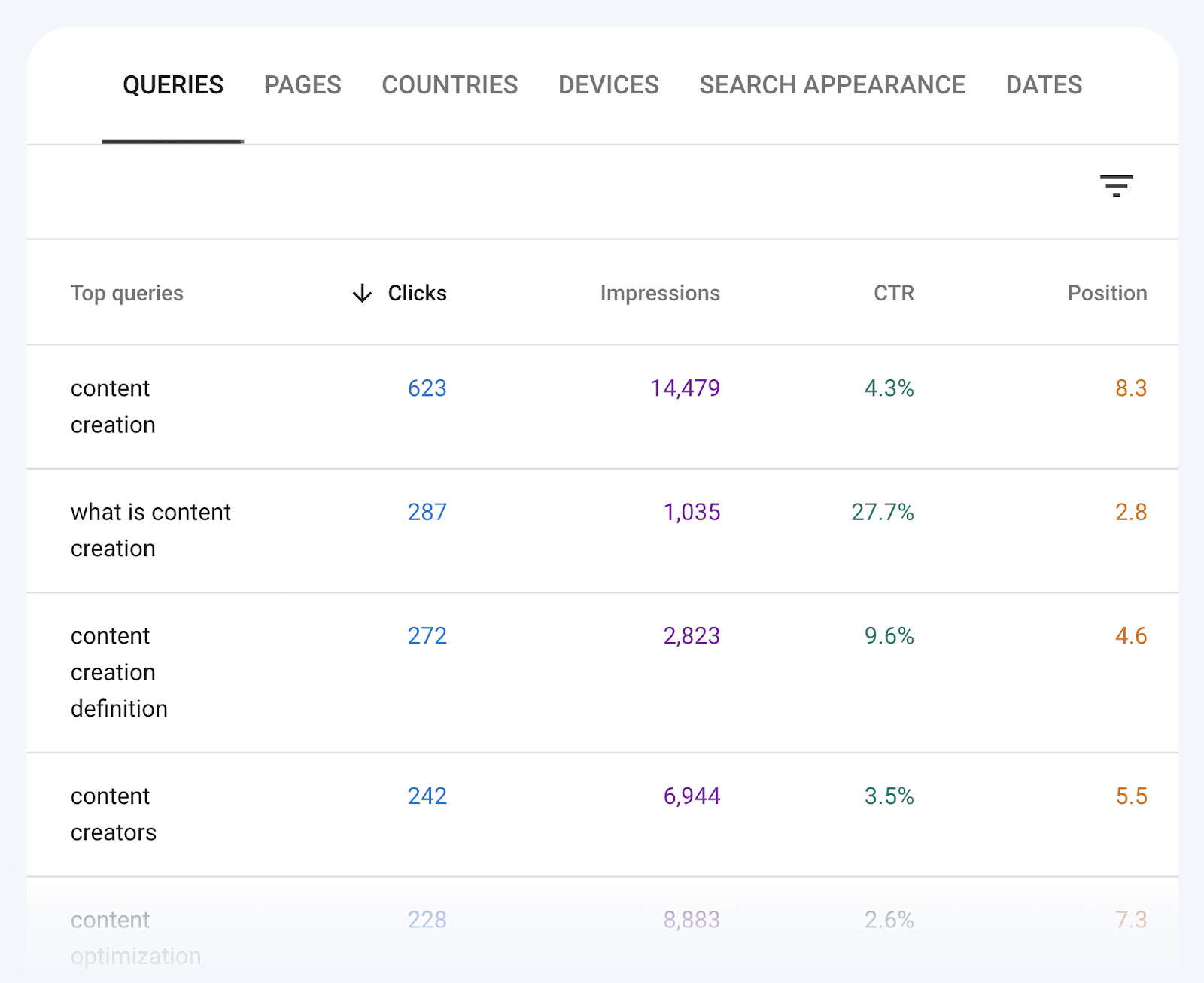
This usually means that your page is relevant for the queries and is ranking, but few clicks and low ranking signal that you haven’t optimized it by including keyword variations in your content or meta tags.
Simply adding keyword mentions won’t do much without substance.
Think of these additional keywords as topics for additional H2s or subsections.
Rework your page, and you’ll likely see an uplift in clicks and ranking position.
31. Audit Your Site’s Existing Content
A content audit checks for pages that underperform in traffic or engagement.
You can audit your content by using tools like Google Analytics and Semrush’s On Page SEO Checker to get optimization ideas.
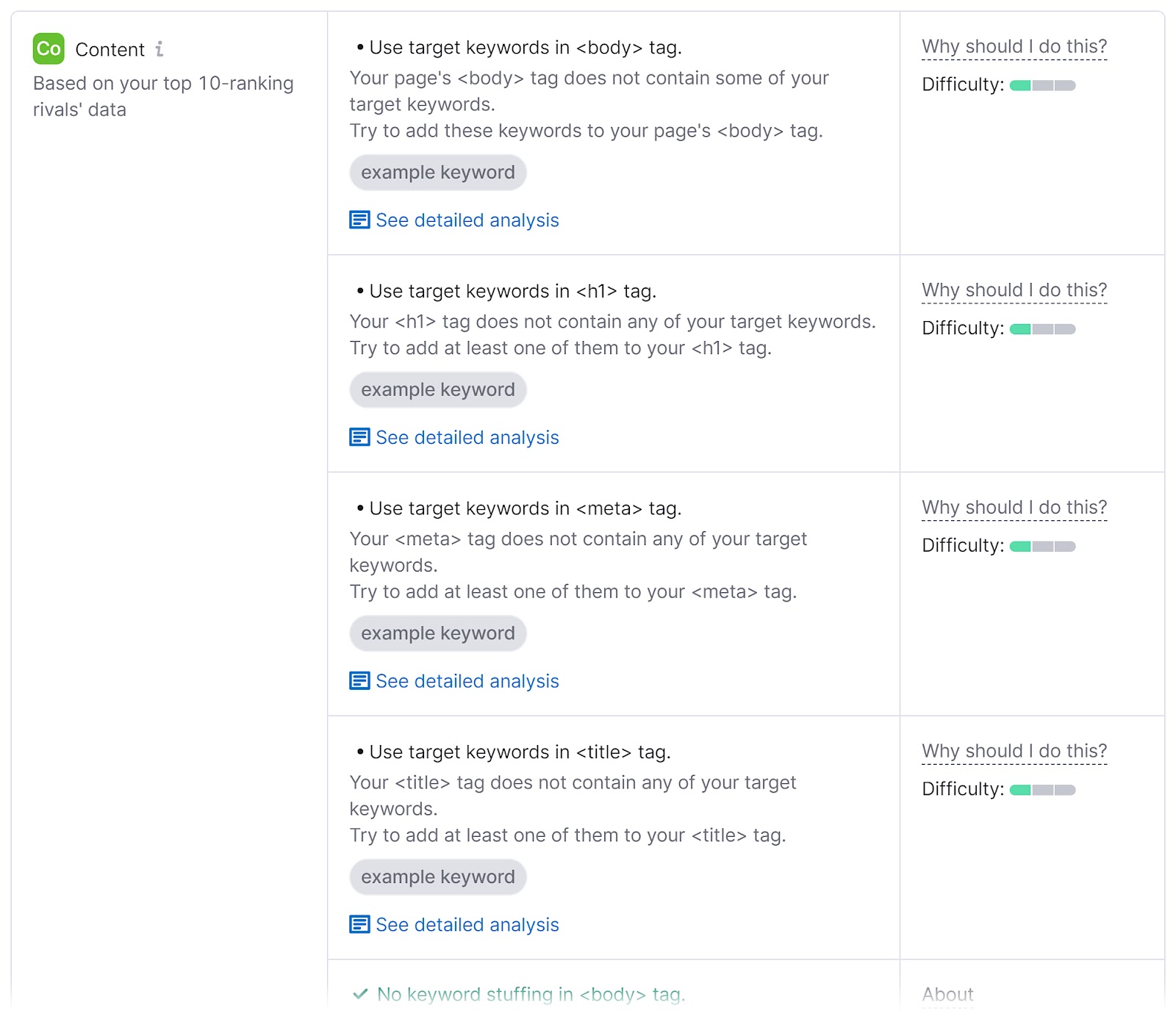
Start by regularly tracking traffic and engagement metrics on your pages.
Then, dig into the pages that aren’t faring well. Compare them to high-performing pages to determine what may be going wrong.
32. Ensure Images Use Alt Text
Alt text describes images to search engines and visually impaired users. Missing alt text can reduce accessibility and limit image-based traffic.
You can quickly find images that are missing alt text using Site Audit.
Go to the “Issues” tab and manually search for “alt attributes.” The tool will quickly show how many images don’t have alt text.
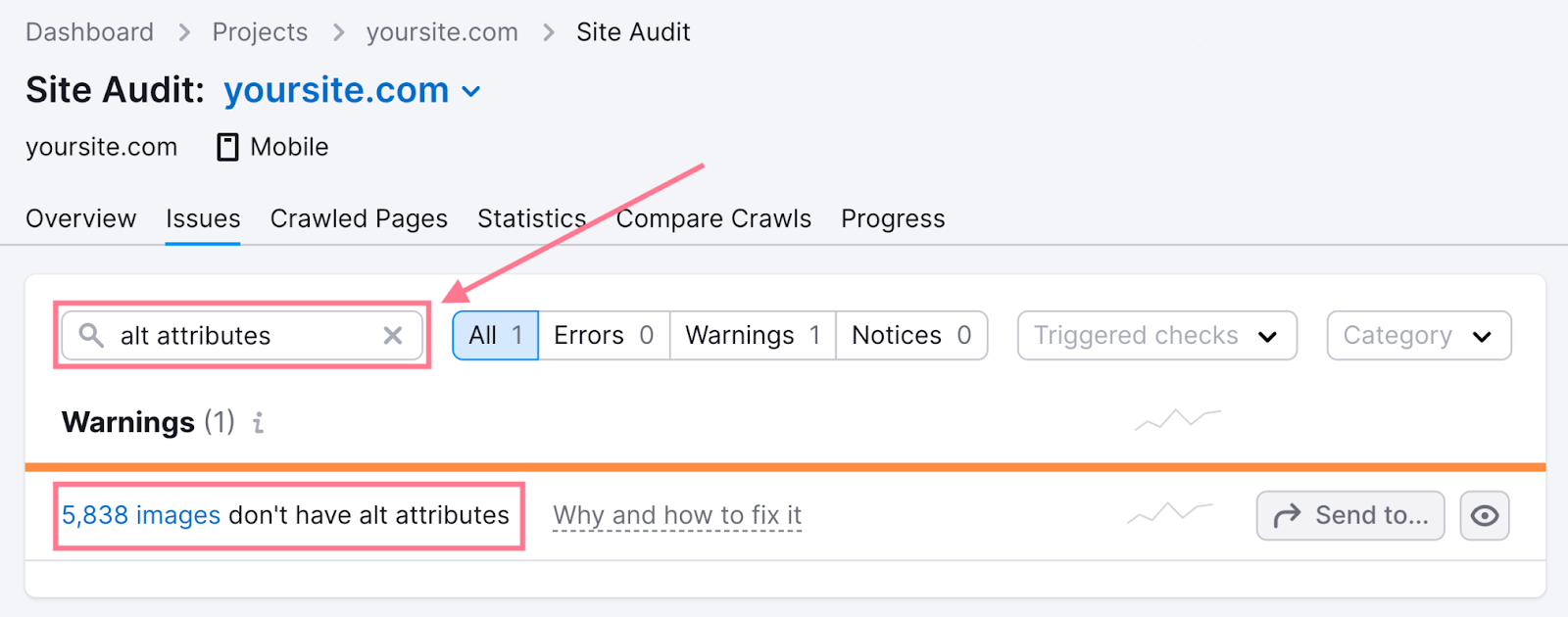
Periodically checking the alt text of older images to ensure that the information is still relevant and accurate is also a good idea.
For example, if your website features an old image of running shoes with the alt text "latest model of running shoes for marathon training," you’ll want to update it to reflect the precise model.
33. Improve Internal Linking
Internal links help search engines and users navigate your site. Linking from high-authority pages to relevant pages can boost rankings.
Site Audit’s “Internal Linking” report shows which pages have only one internal link.
Look for them in the “Notices” section.
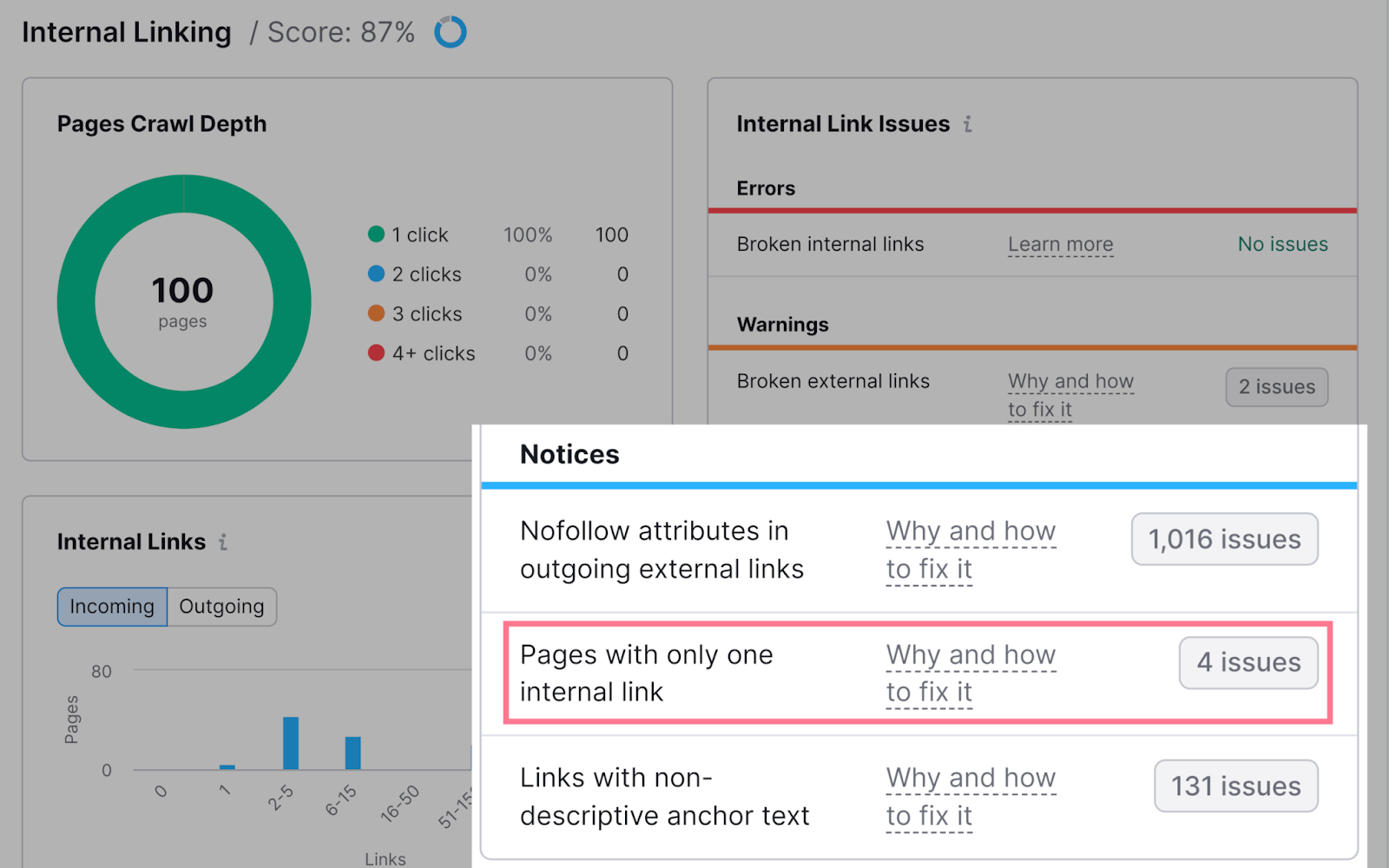
Add more internal links to these pages if applicable.
Learn more about identifying which pages need internal links with our internal linking guide.
34. Find and Fix Keyword Cannibalization Issues
Keyword cannibalization occurs when multiple pages compete for the same keyword intent.
To find out if your site has keyword cannibalization issues, use the Position Tracking tool.
Start by entering your domain and clicking “Set up tracking.”
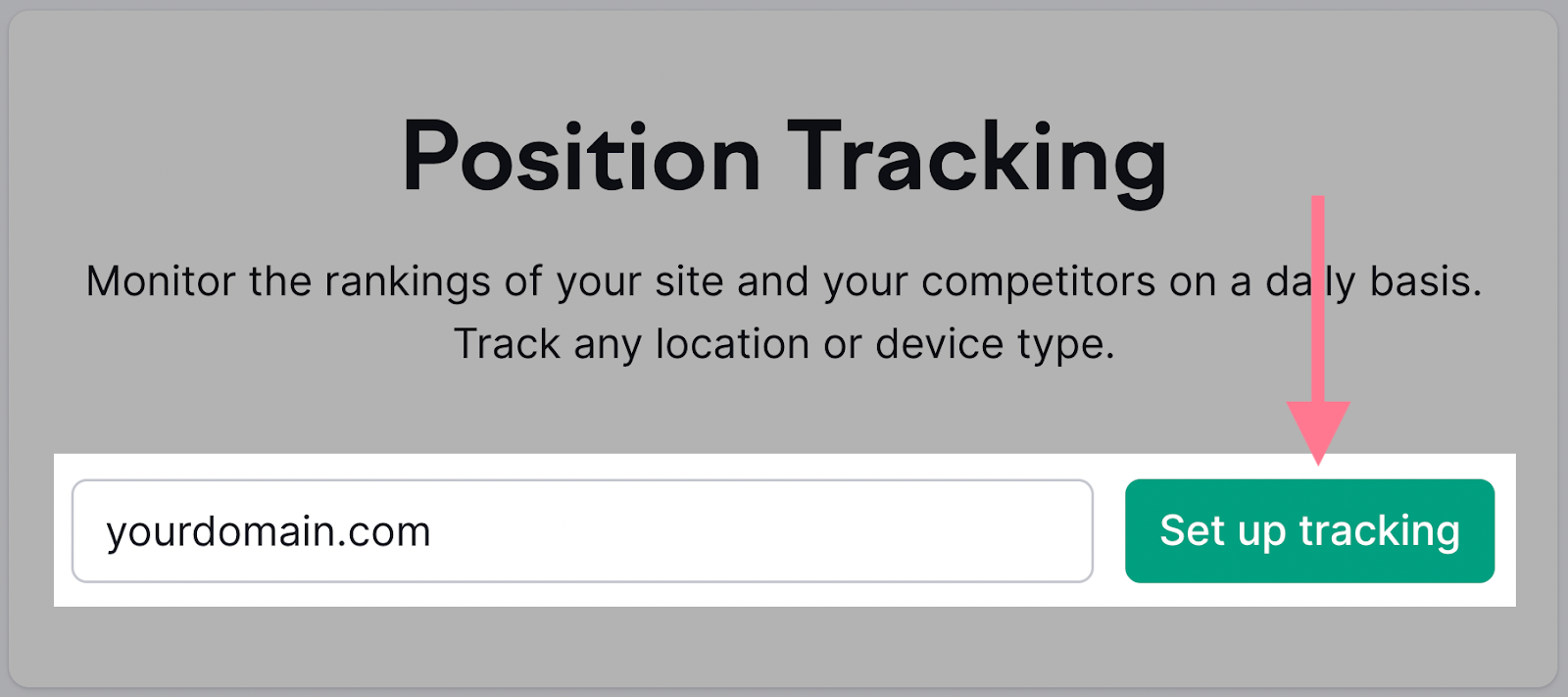
Then, select the search engine, device, and country you want to check.
Like this:

Next, enter the keywords you want to track. Click “Add keywords to campaign” and then “Start Tracking.”
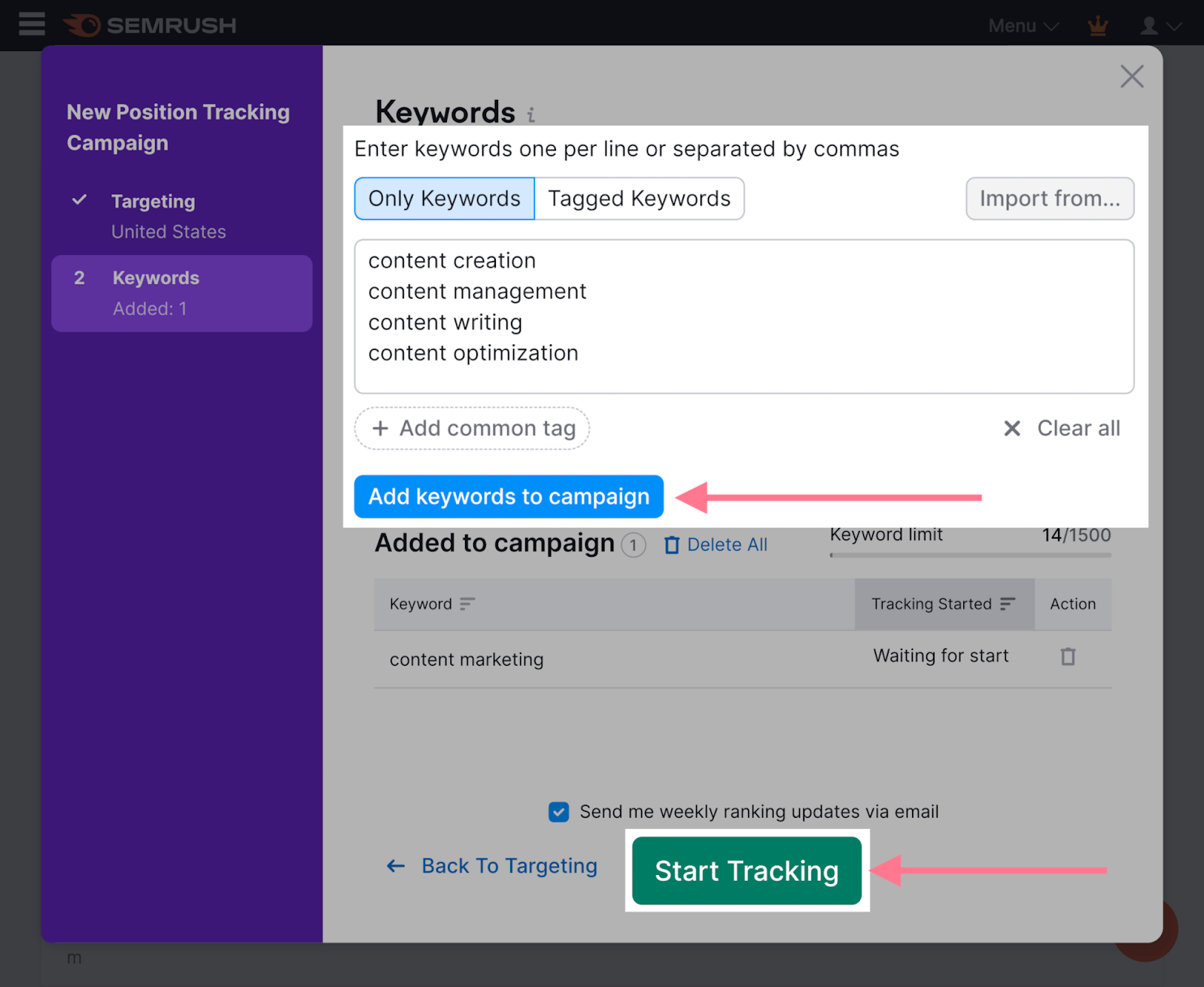
The “Cannibalization” tab shows which keywords and pages are affected.
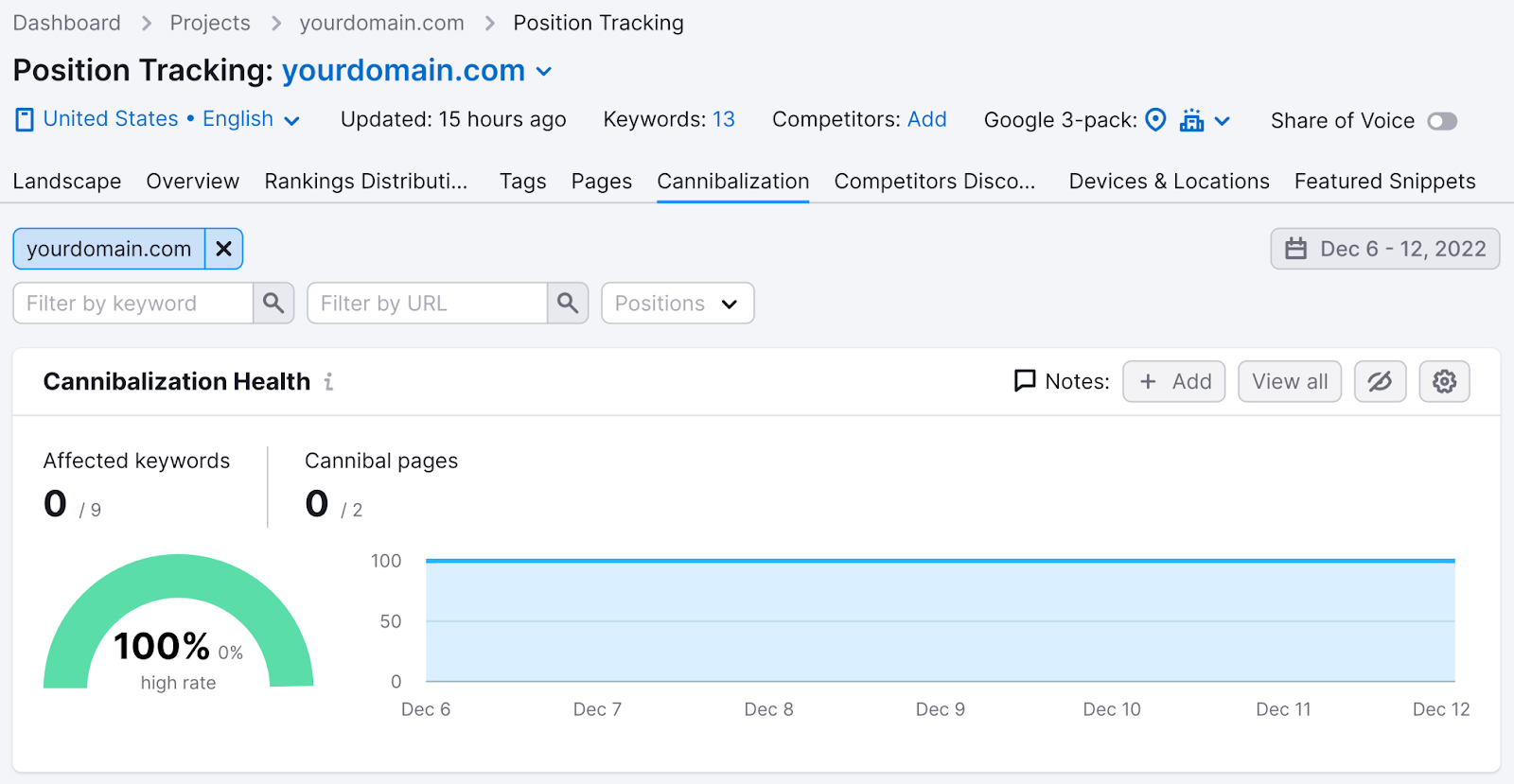
Resolve keyword cannibalization by redirecting or merging content, or by targeting different keywords on each page.
35. Find and Fix Orphaned Pages
Orphaned pages have no internal links pointing to them, making them hard for users and search engines to find.
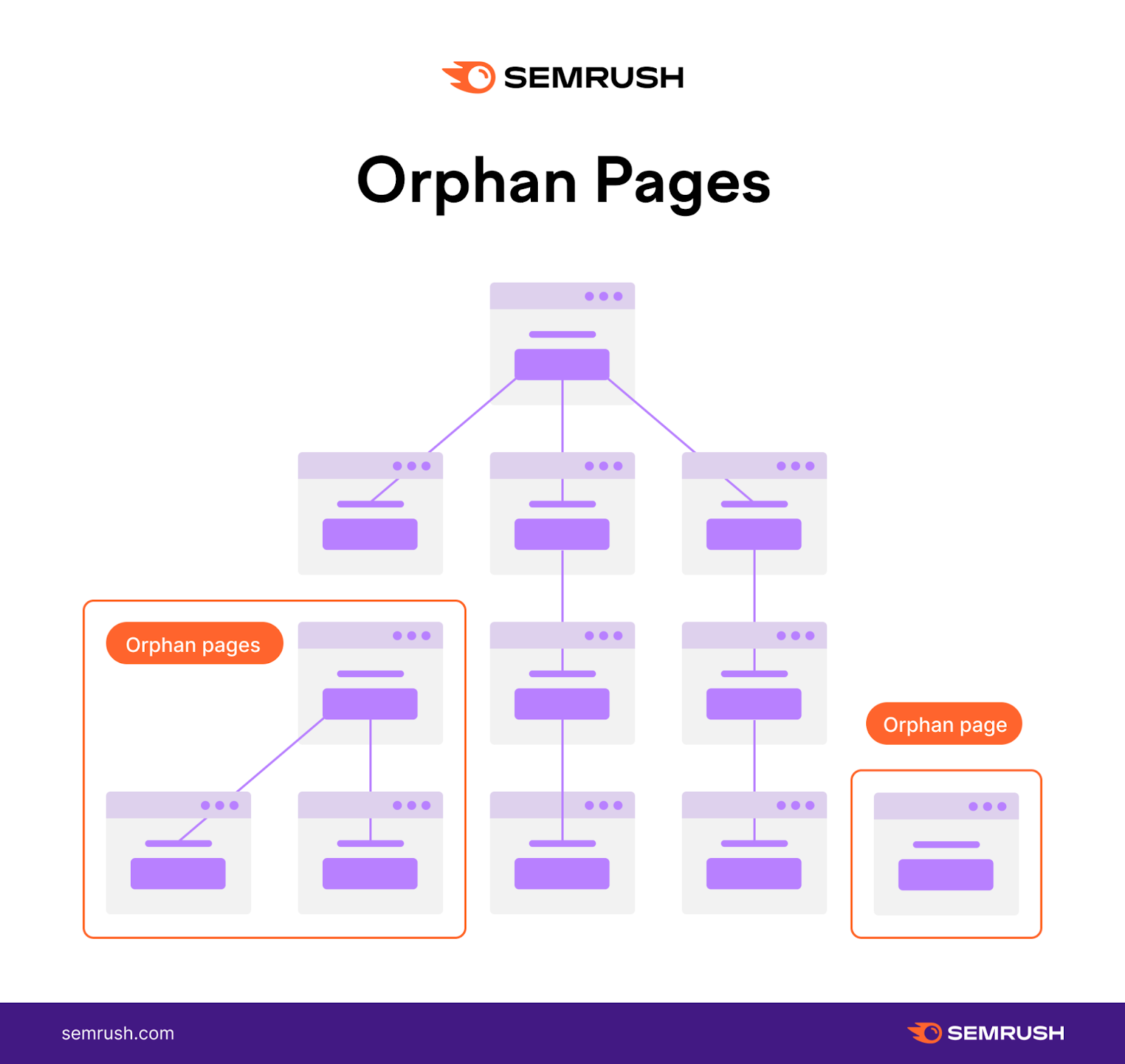
These pages tend to have very little value for SEO because search engines can only discover pages from the sitemap file or links (from your website or from other websites).
All pages on your site should have a link from at least one other page.
To find orphaned pages, open Site Audit, go to the “Issues” tab, and search for “orphaned pages.”
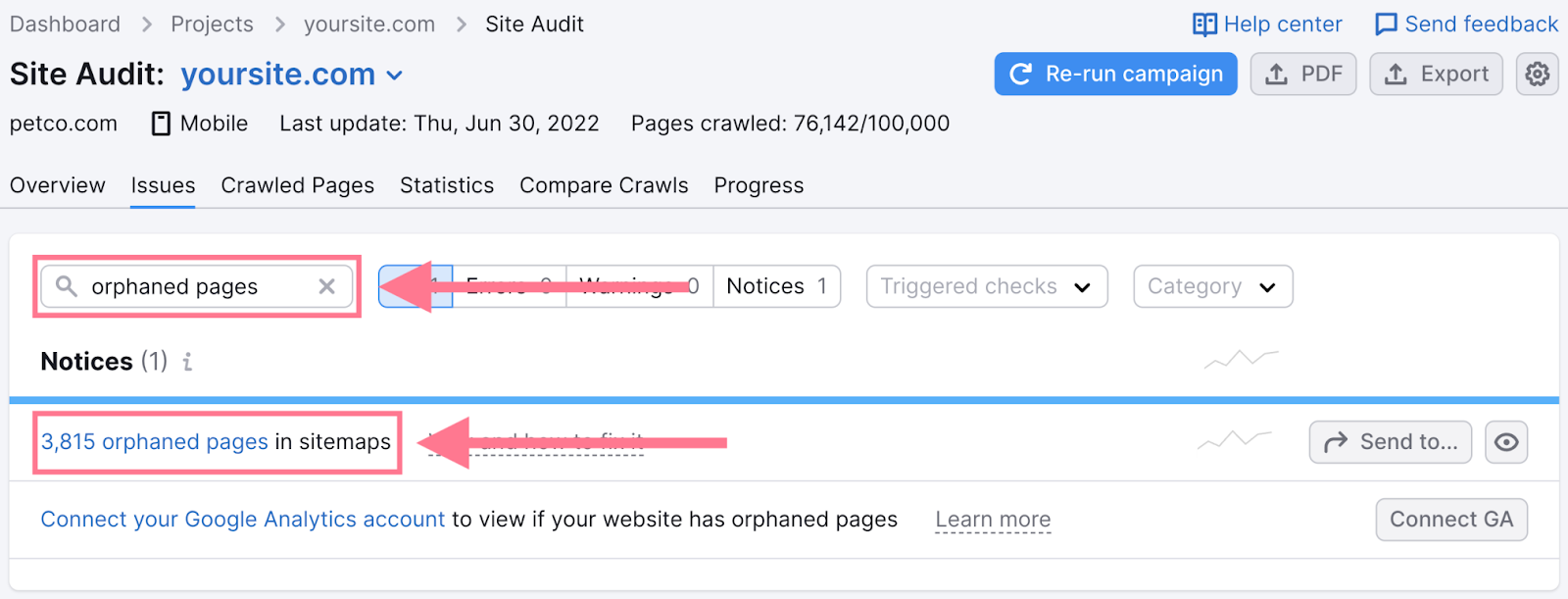
Link to all orphaned pages from at least one other relevant page on your site.
36. Ensure Your Site’s Content Is Up to Date
Outdated content can reduce your site’s value. Keep your core information current with a tool like Semrush’s On Page SEO Checker to find opportunities to update your existing content.
After configuring your project’s settings, the tool will give you optimization ideas to help you improve your pages’ Google rankings.
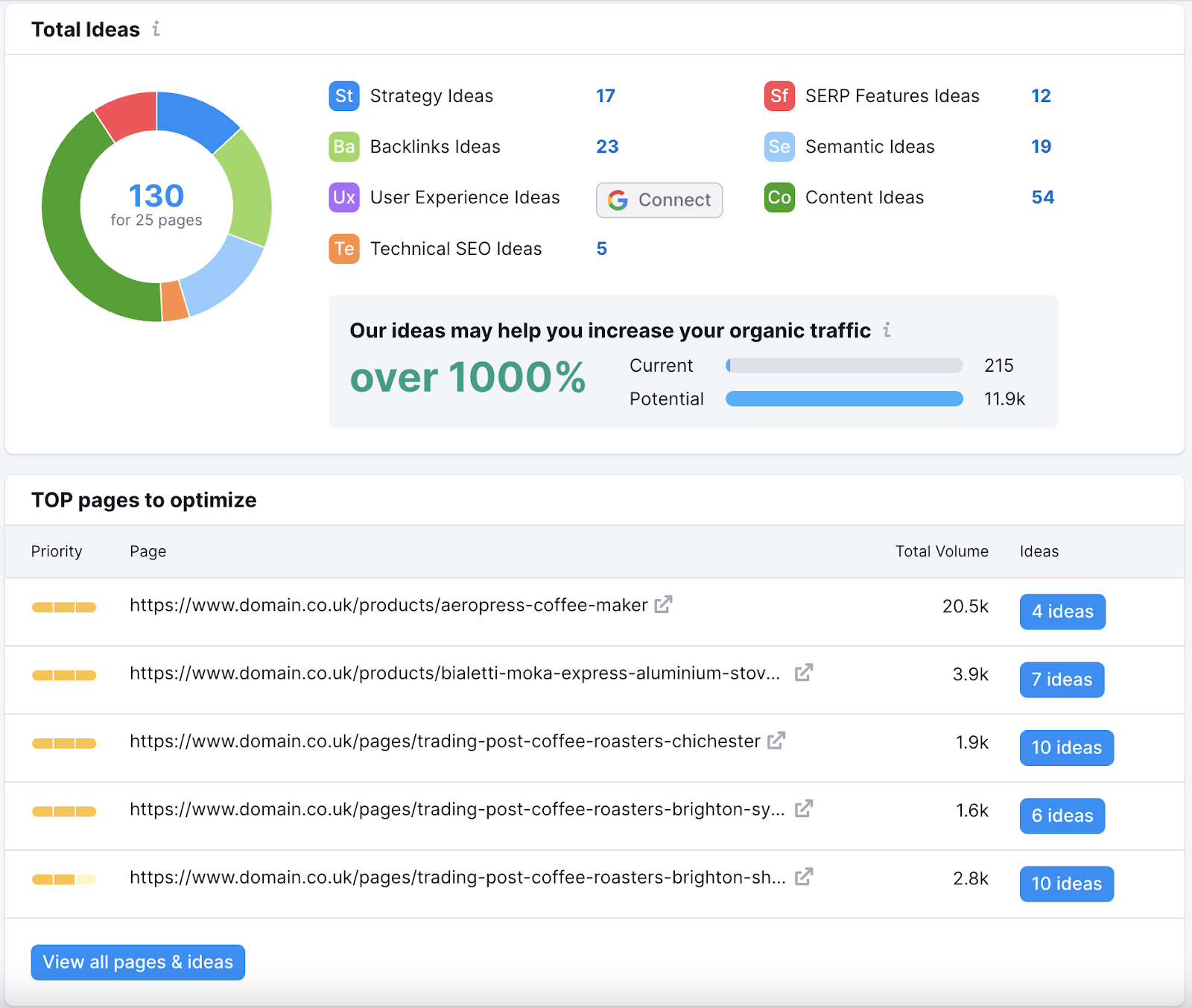
You’ll see the “TOP pages to optimize” organized by total search volume.
Click the “#ideas” button next to any page.
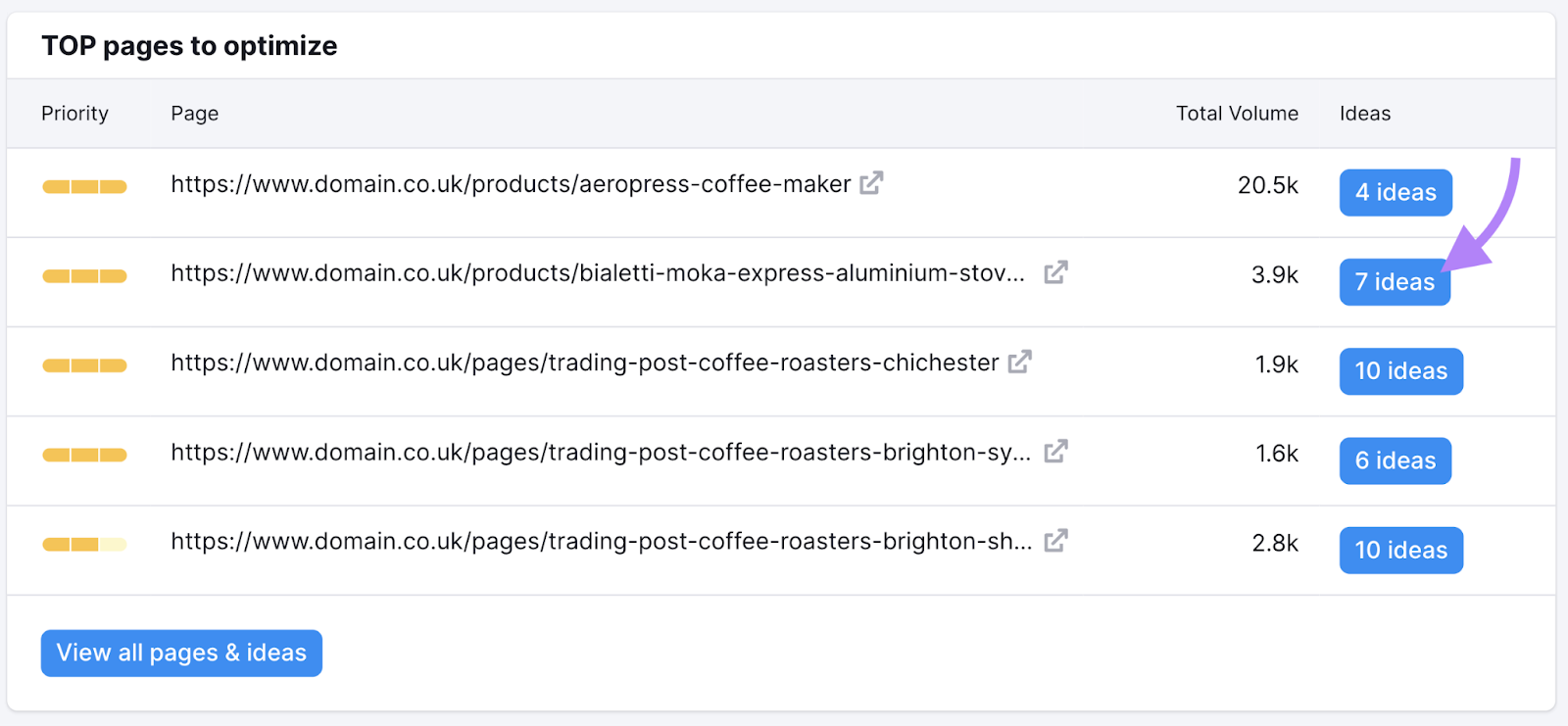
And you’ll see ideas to improve that page based on the target keyword’s search engine results page.
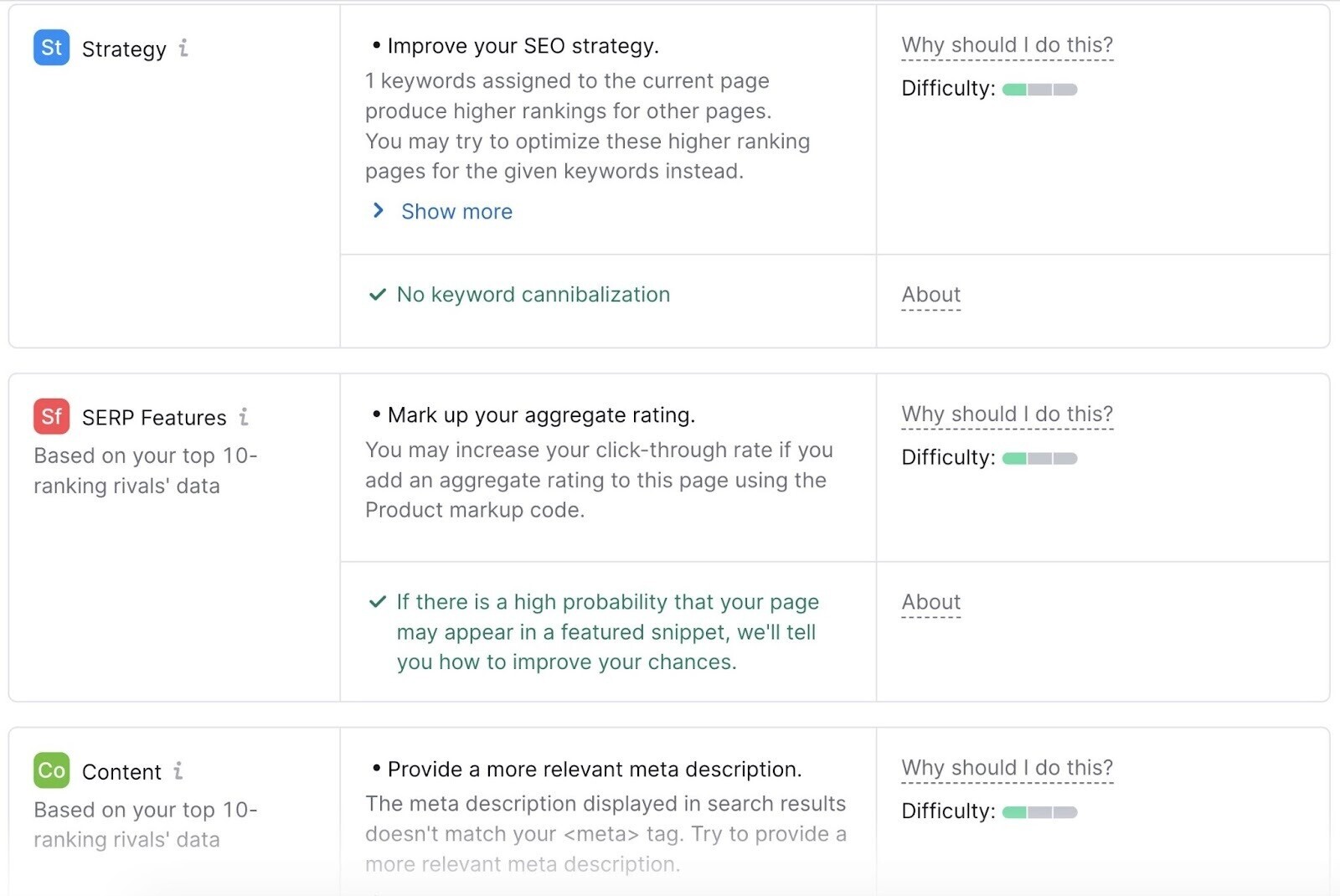
Link Building & Off-Page SEO Checklist
Off-page SEO focuses on signals outside your site, like backlinks. Strong backlink profiles often lead to higher rankings. Check out our off-page SEO checklist.
37. Analyze Your Competitors’ Link Profiles
Just as analyzing your competitors’ content is important, you should dig deep into their link profiles as well.
Enter any competitor’s URL into Backlink Analytics, click “Analyze,” and go to the “Backlinks” tab.

This list can give you a good idea of the overall quality and authority of the links that point to their site. The list can also give you ideas for domains you can contact to ask for backlinks.
38. Conduct a Link Intersect Analysis
Conduct a backlink gap audit to find websites linking to your competitors but not to you.
Use the Backlink Gap tool to find sites that link to your competitors but not to you. These domains may be good link prospects if they already link to similar content.
Start by going to our Backlink Gap tool, adding your domain and your competitors’ domains, and then clicking “Find prospects.”
The table lists all the different domains that send backlinks to the sites you entered.
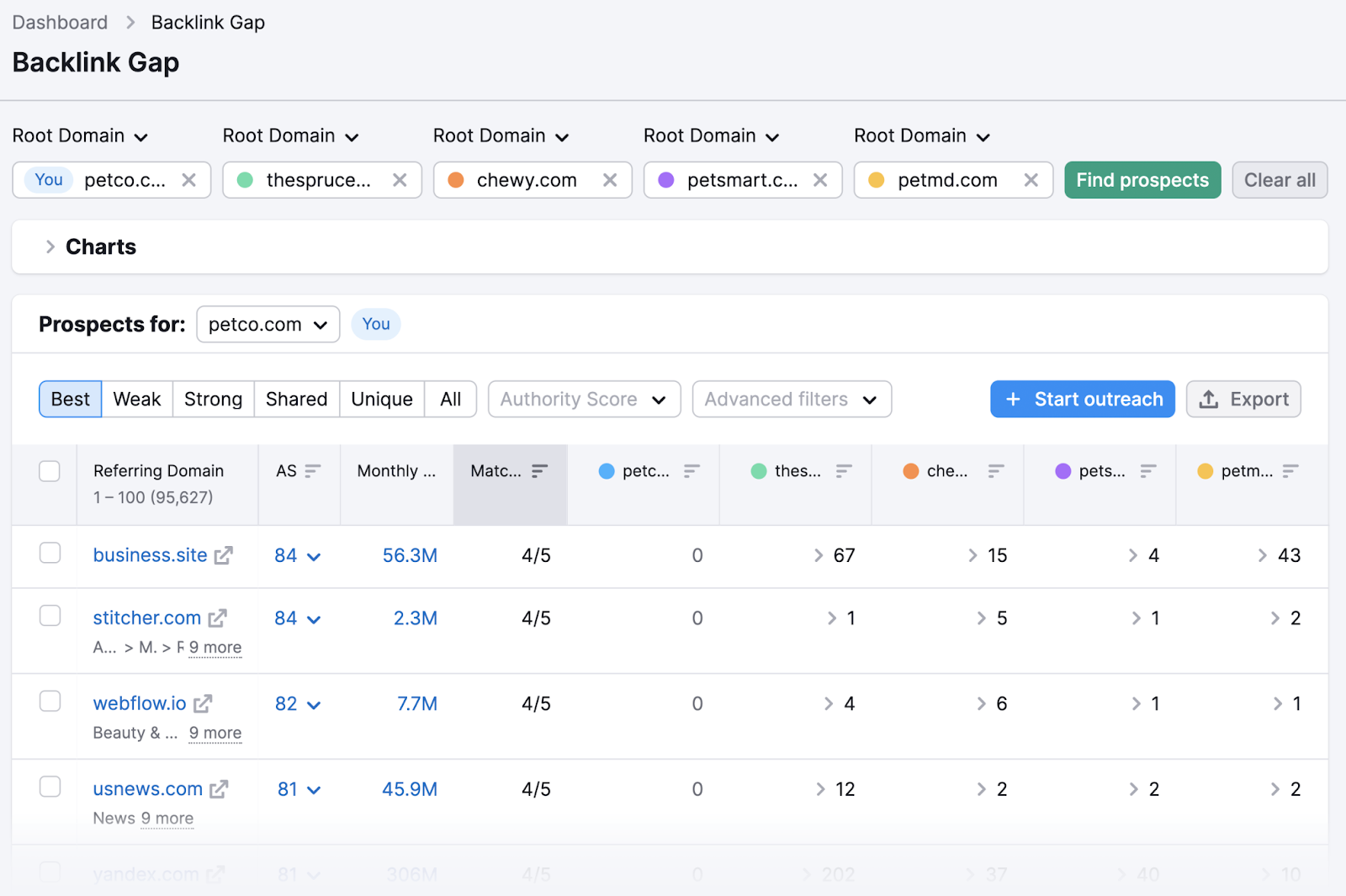
39. Turn Unlinked Mentions Into Links
When someone mentions you or your brand but doesn’t link, you can request a link.
To quickly find unlinked mentions, use the Brand Monitoring app.
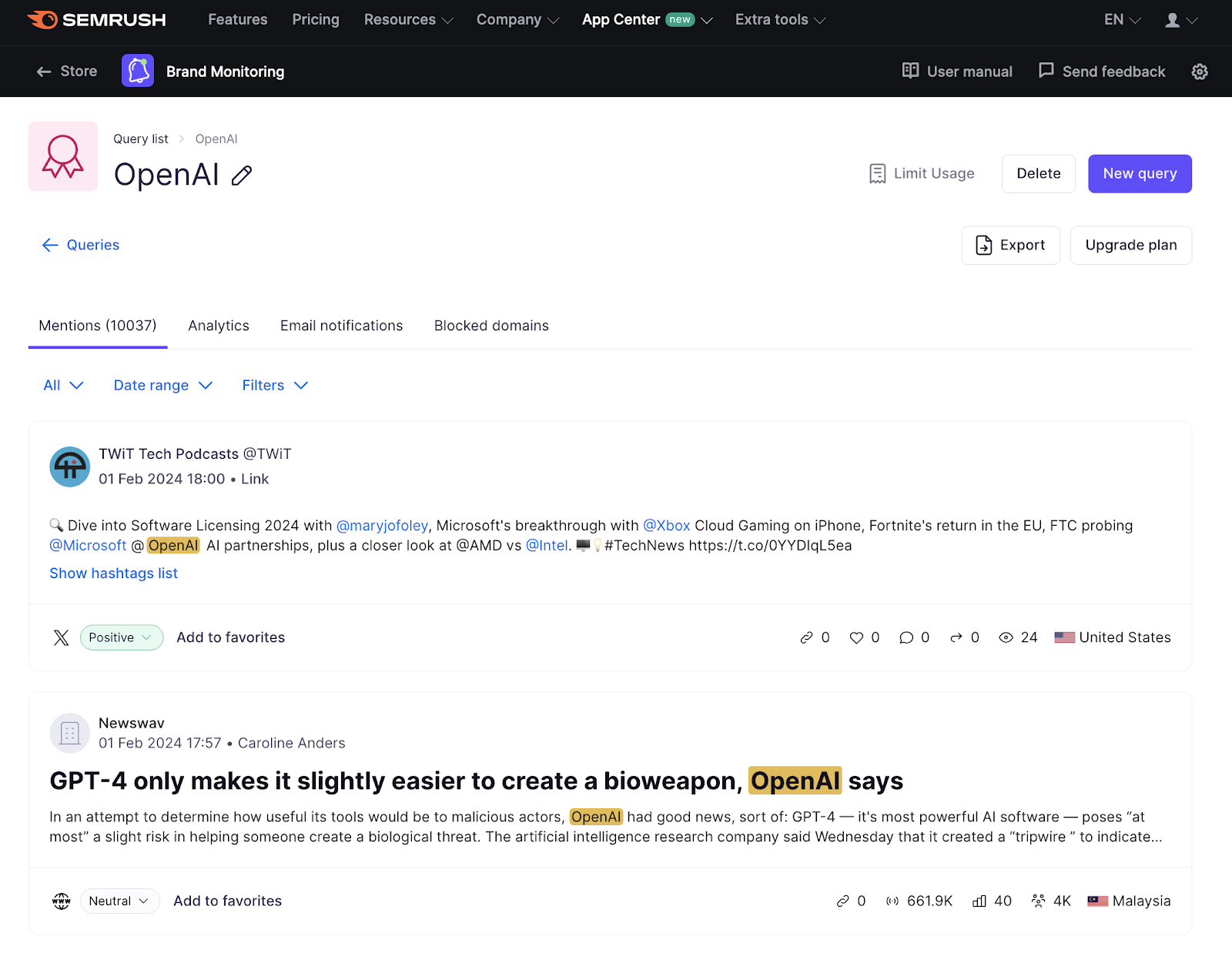
For every unlinked mention you find, reach out to the page’s owner or author. Thank them for the mention, and politely request a backlink.
40. Find New Link Building Opportunities
Pursuing new link building opportunities can improve your backlink profile.
Using the right SEO tools can make the task of finding these opportunities a little bit easier.
Our Link Building Tool, for example, shows a list of prospects you can reach out to for backlinks.
Like this:

41. Set Up and Optimize Your Google Business Profile
If you operate a local business, create a Google Business Profile to appear on Google Search and Maps. Fill out your information accurately, emphasize unique features, and add photos or videos.
This is what a Google Business Profile can look like:
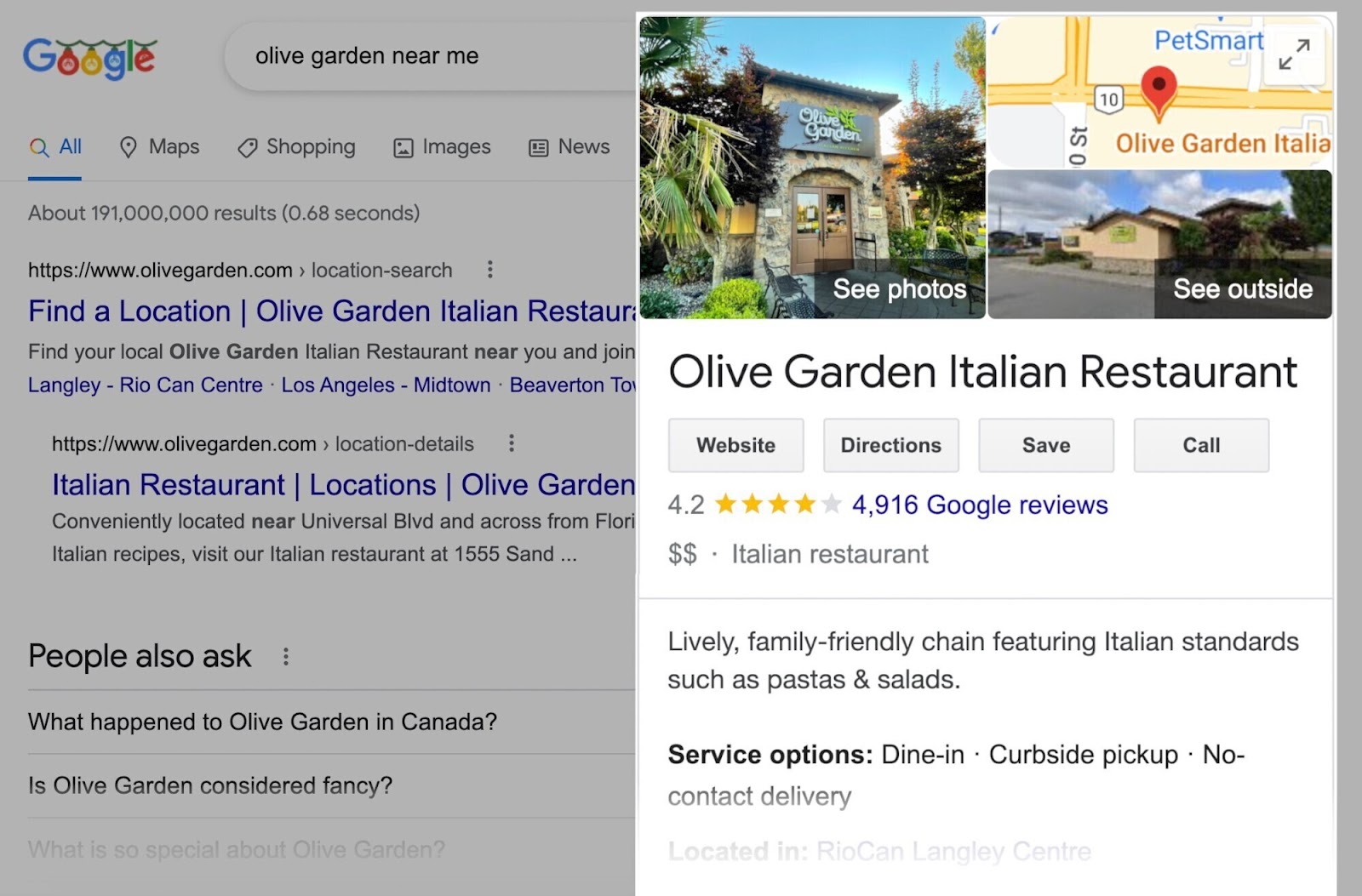
To start improving your brand’s local visibility, read our Google Business Profile guide.
Then connect your profile to Semrush’s Listing Management tool for performance insights.
Execute This SEO Checklist
SEO is always changing, but these 41 tips offer a solid path to higher rankings, increased traffic, and better business results.
Start now with a free Semrush account and optimize your site for search engines and users.
